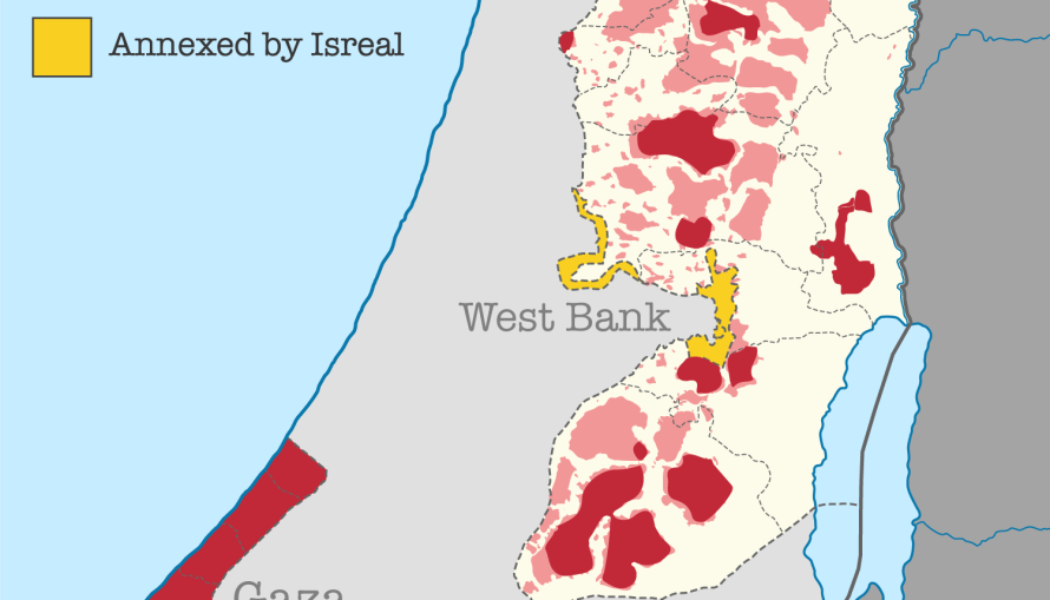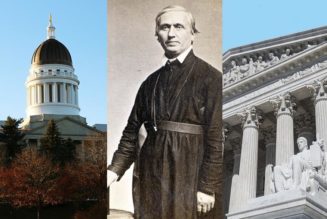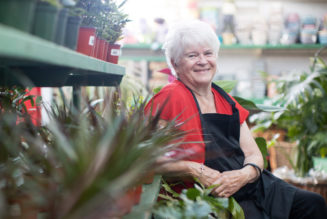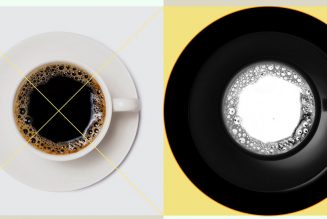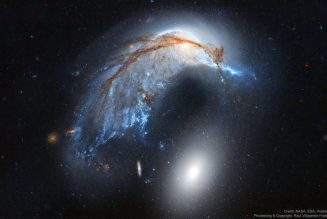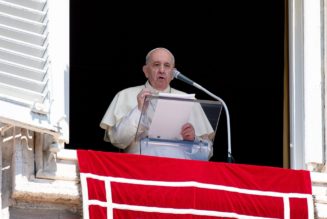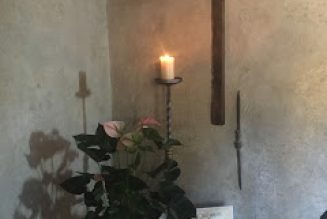Notes from the Author:
1) First and foremost–I offer this post to Our Lord through the intercession of His Mother, St. Joseph, and St. Jerome: in reparation for my sins and the sins of the world, for our repentance, and for an enduring peace throughout the Middle East and the world as quickly as possible.
2) As a reminder, copy/paste GPS Coordinates listed below into Google Maps to see or travel to each location.
3) I apologize for any annoying ads wordpress.com automatically and randomly posts within this article–they are not of my choosing.
4) Lastly, if you enjoy this post and want to learn more, check out my one-of-a-kind book, The Second Person of the Trinity in Time and Space: What is Known Historically About Jesus and the Holy Sites of the New Testament, sold on Amazon.com! (link at the bottom of this post)
///
This past January (of 2023), I had the amazing opportunity to go back to the Holy Land on another self-guided pilgrimage. I still had more sites that I hadn’t yet had the opportunity to visit and/or that I hadn’t known existed until recently.
When I originally planned to do the trip, I was planning to limit my trip to seeing more sites in and around Jerusalem. However, the Lord presented me a huge blessing in the form an opportunity to travel into the West Bank to visit some of the Holy Sites from Christ’s life there.
I took red-eye flights into Tel Aviv and arrived there at a very early 2:43 AM.
I followed the same routine as my trip in September 2022…went through customs, walked to the car rental area, got the shuttle to go pick up my rental car, and arrived at the Budget Car Rental desk to pick up my vehicle. Everything was going smoothly so far…I had gotten some sleep on the plane rides and was feeling good. As I read through the car rental agreement, I noticed an unexpected prohibition to take the rental car into Palestinian Authority-controlled Areas A and B in the West Bank or run the risk of incurring a $300 fine! Unfortunately, two of my destinations I had planned for on this trip were in Area A: Bethlehem and Jericho!
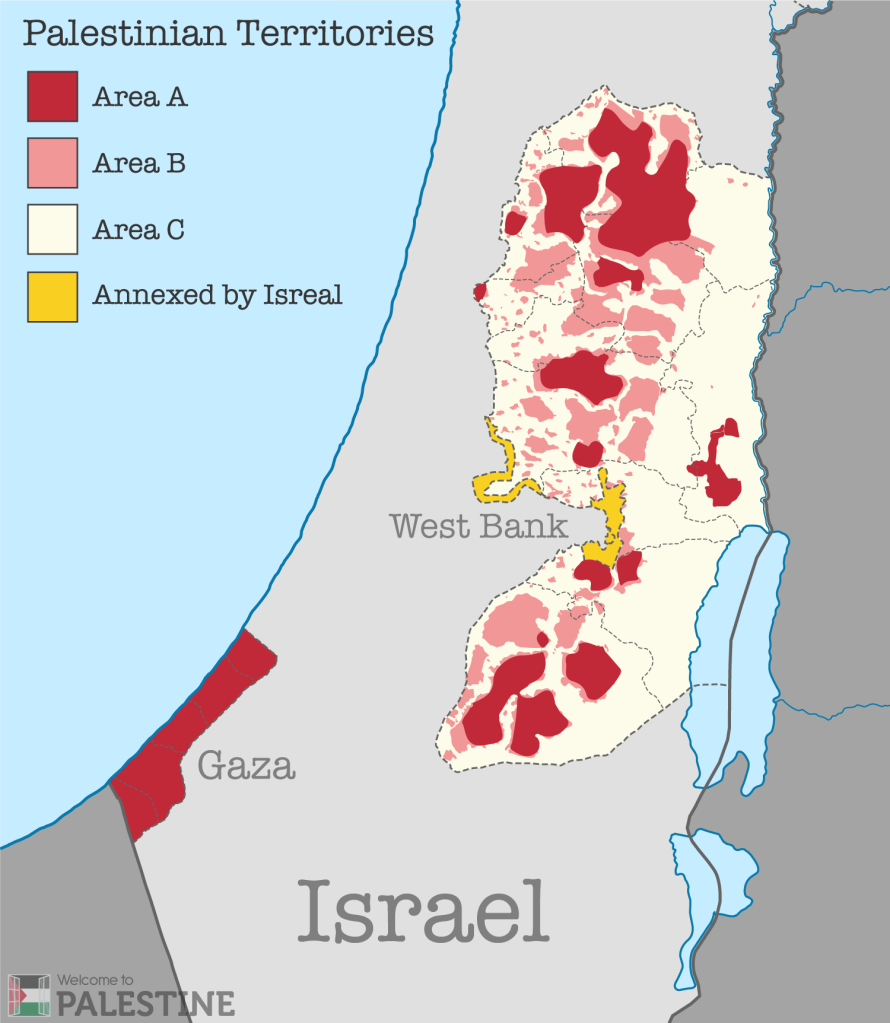
Bad on me, I guess…I hadn’t expected to be confronted with this issue, as I don’t remember there being a prohibition of this kind when I first visited Bethlehem and Jericho using a rental car on a trip in 2012.
This complicated my plan, but I said some prayers as I checked out my vehicle and started the 40-minute drive to the Israeli-Palestinian border’s closest gate to Bethlehem: Checkpoint 300 (GPS Coordinates: 31°43’27.97″N, 35°12’14.59″E)). On my drive, I determined my best course of action was to find parking at Checkpoint 300 (instead of driving through), process through the Checkpoint, and then walk/run a few miles to reach Bethlehem.
I arrived at Checkpoint 300 at around 4:50 AM local time. I drove around for a bit looking for parking and finally found a few mostly empty parking lots near the vehicular gate through the checkpoint. I parked my car in one of the parking lots and saw an Israeli soldier walking towards me. I conveyed to him I was a tourist, showed him my passport, and told him I was looking for a place to park. He told me it was ok to park in one of the empty lots and that it was ok and free of cost (even though the sign said there was restricted access to the lot!). I couldn’t believe it! I thanked the soldier for his kindness and wished him my best.
(As a security professional myself, I understand to a certain degree the challenges that come with guarding a post as a sentry. I can’t, however, fathom the stress of being a gate sentry on the border between Palestinian and Israeli lands–unfortunately you never know if the next car that approaches you could be an aggressor. All the more reason I was so surprised by the young man’s kindness and professionalism to a stranger finding his way around in the darkness.)
I went back to my car and worked to get a few belongings situated in my backpack so I could begin my journey by foot to Bethlehem. Once ready, I threw on my winter coat and stocking cap, as it was chilly out, and slung my backpack across my shoulders. I then started walking towards the Checkpoint 300 pedestrian access facility. It is a large building that appears well-used. As I walked towards the front of the building, I noticed numerous Middle Eastern men in modern clothes socializing near a bus stop in front of the building. I realized these were likely Palestinians who had been granted permits to leave the Palestinian Authority-controlled West Bank and work in Israel. I carefully wove my way through the men, endeavoring not to “stand out” or make eye contact. I walked into the facility through the worker entrance. I went through a one-way turnstile inside the building, walked through some halls and found myself outside once again. I was a little confused, because it looked like I was still on the Israeli side of the wall. There was another group of workers outside the exit to Checkpoint 300 congregating–cabdrivers also. I kept to my own business, looked like I knew what I was doing (haha), and walked towards the town of Bethlehem about 2 miles to my south. It was about 5:10 AM. The streets were sparse and quiet, and it was cold outside. I was glad I packed my winter coat! Ironically, the last time I was in Israel, I was enjoying the hot weather and the beach!
I kept walking and eventually saw the West Bank barrier wall…except…I still couldn’t definitively determine which side of the barrier I was on: the Israeli side or the Palestinian side with Bethlehem! I couldn’t clearly tell just yet based on Google Maps either. However, I kept walking and eventually saw a few sights that helped me know I was where I needed to be. The first was a Christmas star like the one that had guided the Wisemen along this very same road to the Christ child! Although it was a simple street decoration, in a small but meaningful way, I was being given the treasure to actually re-live some of the wisemen’s experience 2,000 years later. The Christmas decorations were also an indication that I was indeed near Bethlehem. The second sight was a set of angel street decorations with the massive St. Michael’s Hotel (!) behind them (see photo below). When I saw the name of “St. Michael” on that hotel, I was confident one of my favorite Saints was looking out for me along my pilgrim path to Bethlehem.
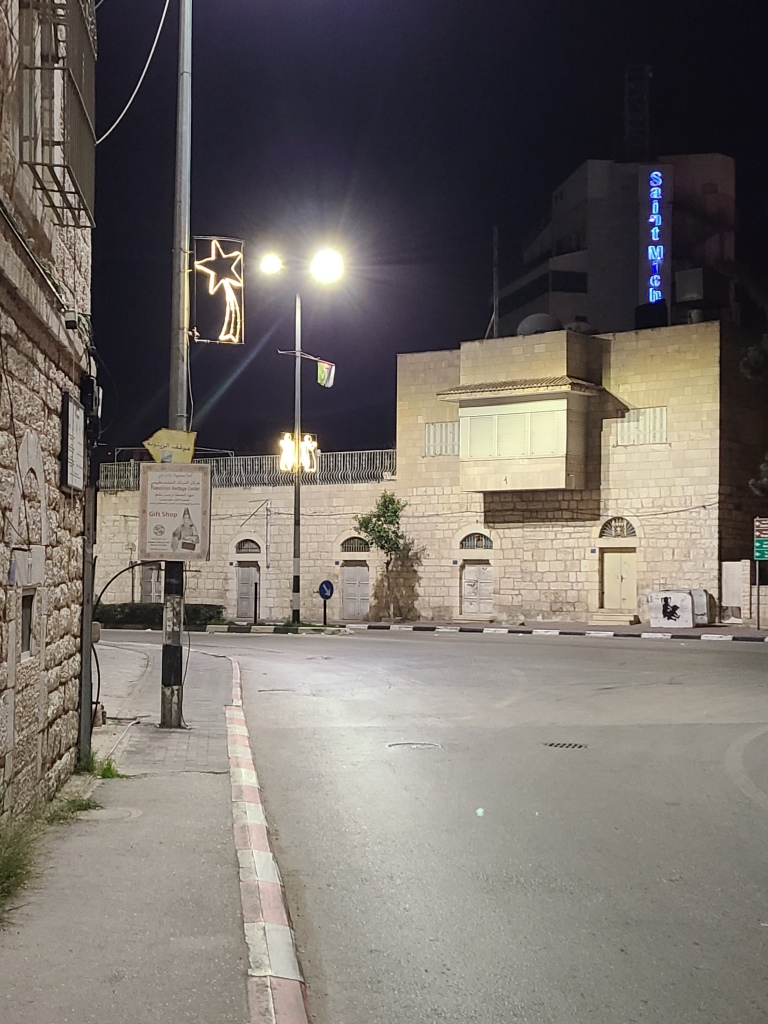
I was able to confirm my intuitions were correct when I saw the unique Palestinian mural below, with a sign saying “Welcome to Bethlehem!” I had made it!
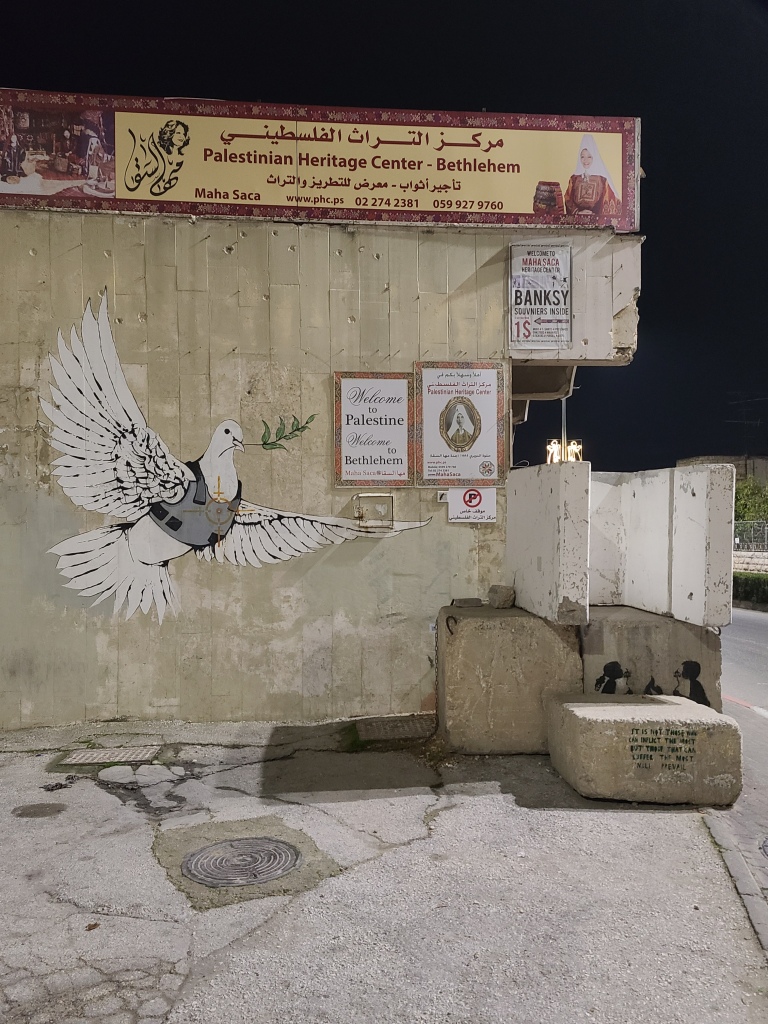
At this point, I continued on down the main road leading from Jerusalem into Bethlehem–likely the same road Our Lady and St. Joseph would have taken, and the same the wisemen would have taken into Bethlehem after visiting with King Herod in Jerusalem.
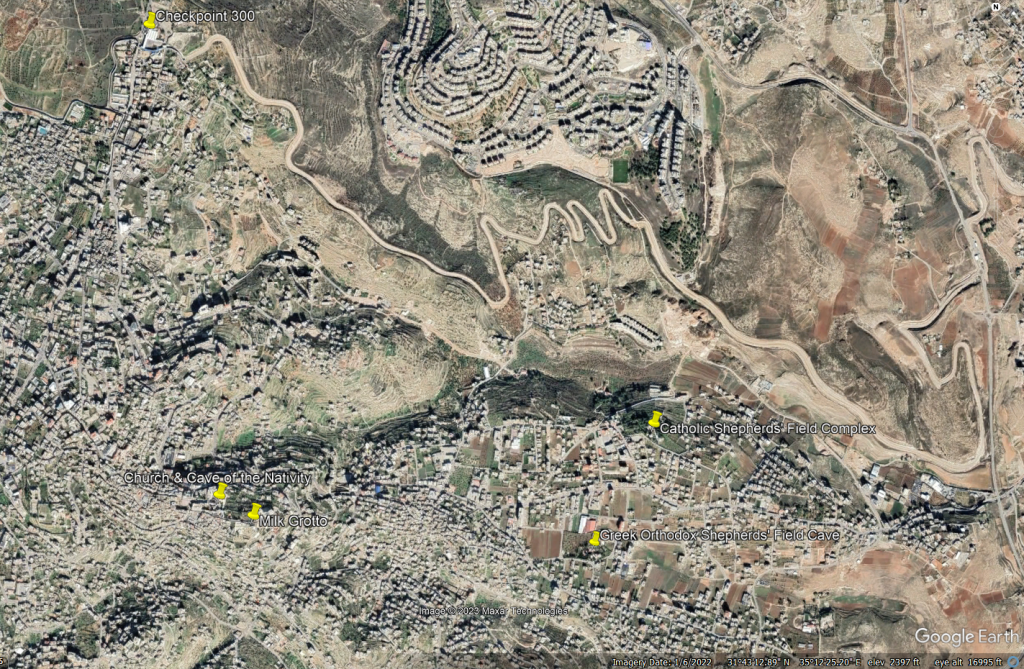
Instead of seeing one or two sets of Christmas street decorations, I began seeing more and more lining the length or the road ahead of me. It was beautiful to see Christmas being celebrated here and seeing people of different faiths co-existing together.
Additionally, I was looking at Christmas lights at the very place where Christmas BEGAN! The billions of Christmas lights that are lit each year around the world, in their own small way, bear witness to the seismic event that happened in this town in someone’s cave spareroom: the birth of God incarnate.
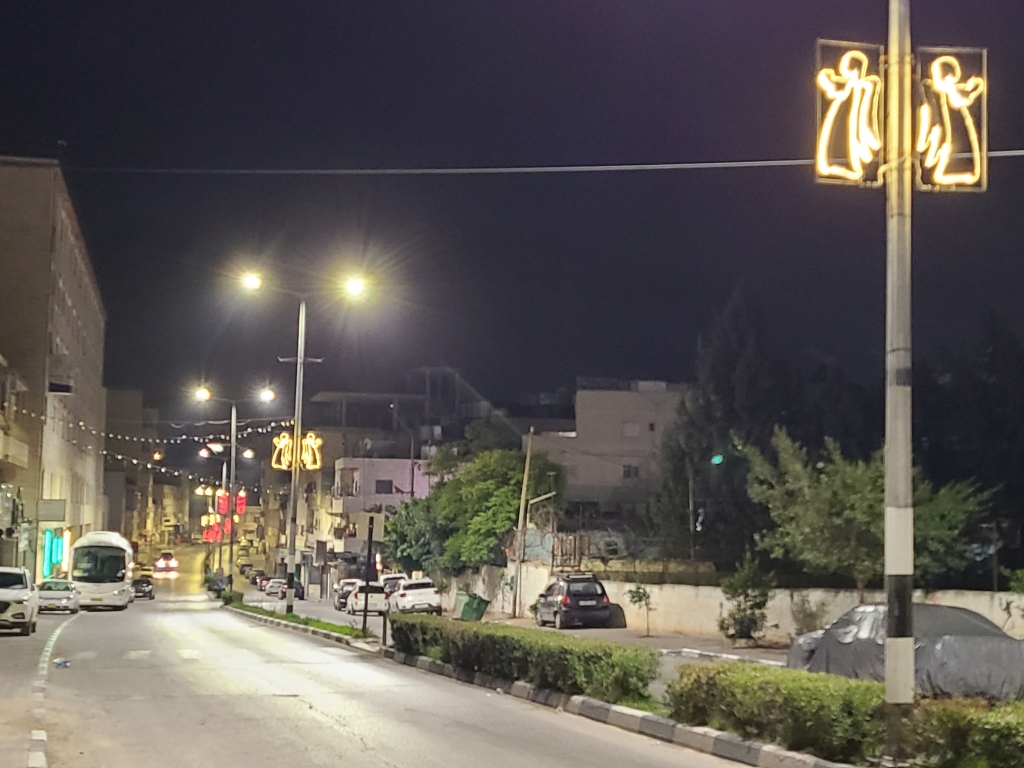
As I walked down the road, I started going uphill, likely the northside of the hill upon which the ancient town of Bethlehem was situated. I started to see a few more people getting in their cars and beginning their day. Finally, I got to the top of the hill. I saw a beautiful mosaic of the Blessed Virgin Mary on a donkey riding into Bethlehem. Next to it was a shooting star decoration that lit it up.
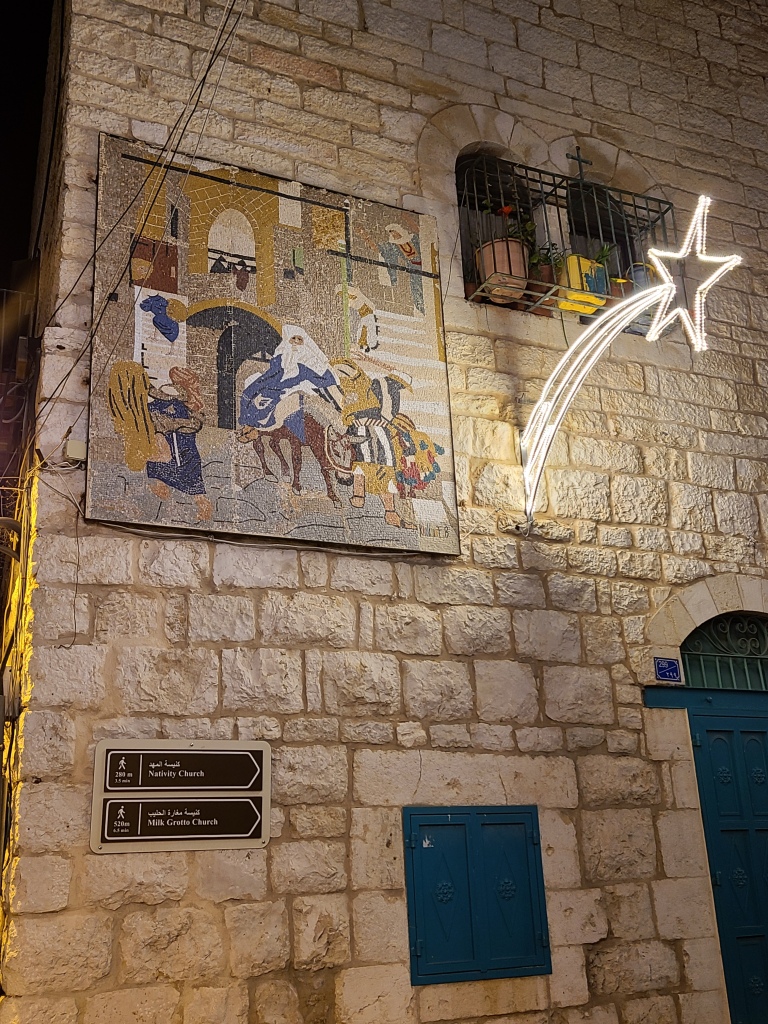
I turned to my left and saw a deserted street lined with the beautiful shooting star Christmas lights. They lit up the whole street! I couldn’t help but thinking of the Christmas Carol “O Little Town of Bethlehem” when it says of Bethlehem: “but in thy dark streets shineth the everlasting light.” 2,000 years later, the Commemoration of Christ’s birth still lights up the streets of Bethlehem.
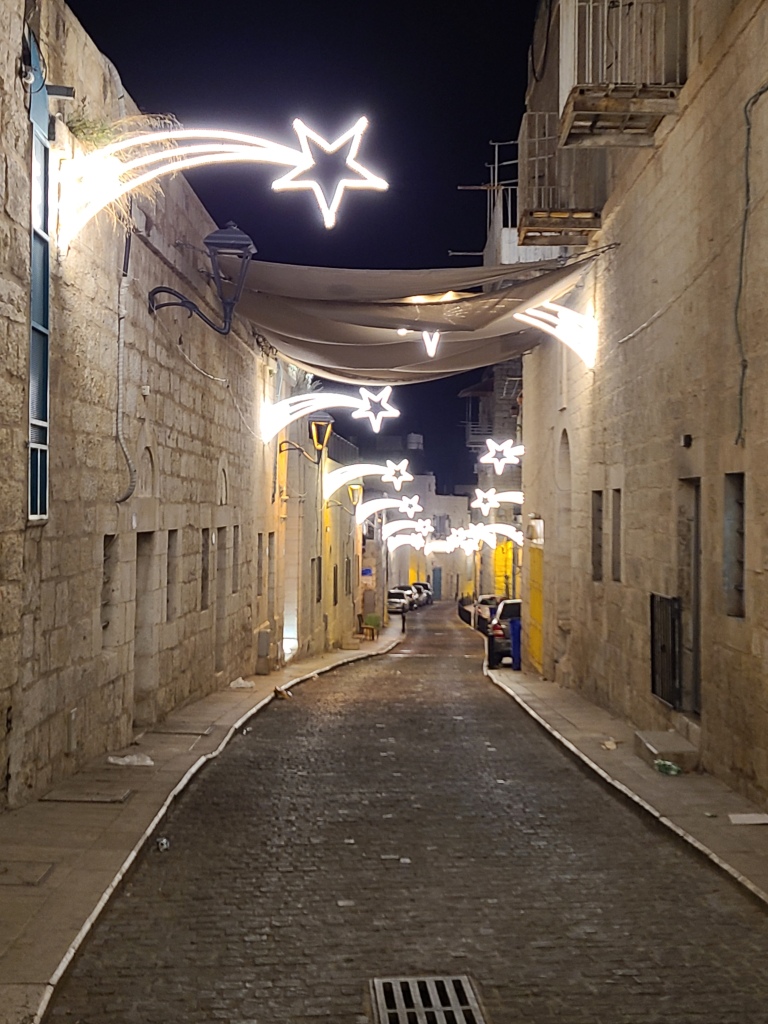
I kept walking through the quiet streets of Bethlehem, meditating on how it must have been for Our Lady and St. Joseph riding through the town 2,000 years ago.
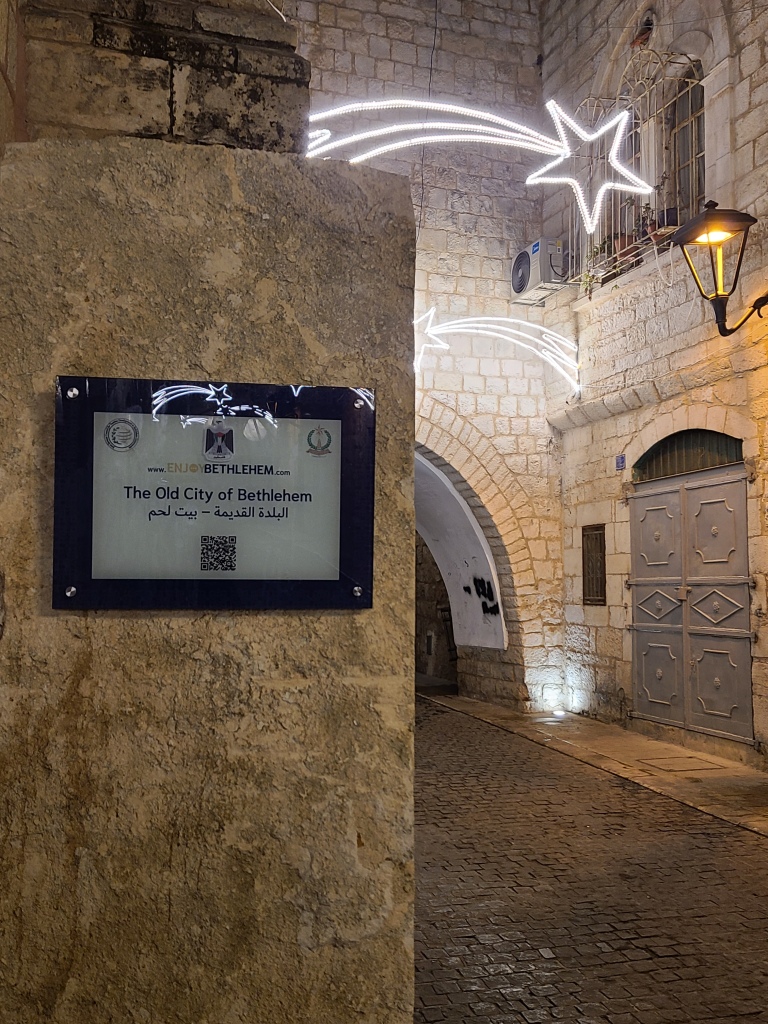
Eventually, I came to the magnificent “Manger Square,” the large open square in front of the Church of the Nativity. The Church of the Nativity has been standing here since the Emperor Constantine had it completed in the 300s over the cave where Our Lord was born.
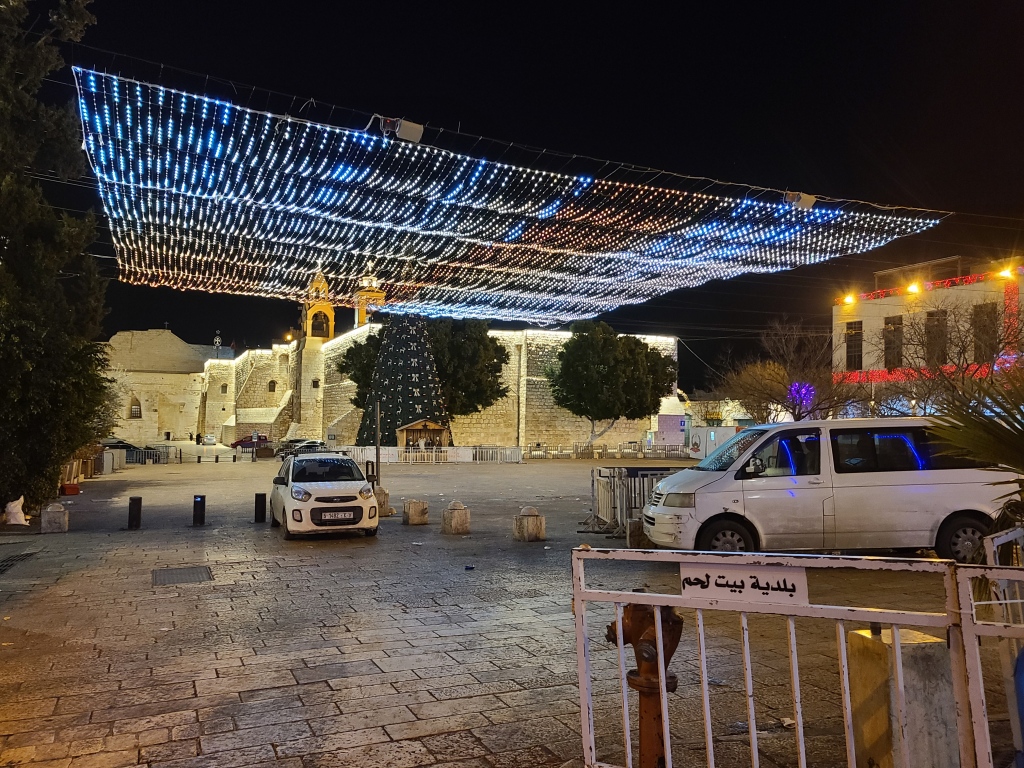
At this point, however, my goal was to keep moving eastwards past the church. Of course, I would come back to it later, but my goal now was to travel down to the flat land east of the hill on which Bethlehem is perched, an area known as Beit Sahour. On Christmas night, the sky above this holy field failed to contain the joy in heaven and was shattered, revealing the Host of Angels singing “Glory to God in the highest!”…My destination was the Shepherds’ Field east of Bethlehem, and I began to run down the hill of Bethlehem to reach it as fast as I could. I had to beat sunrise. The sky in the east towards the Dead Sea would begin brightening any moment. I wanted to experience what it was like for those shepherds at the same place, at about the same time of year, and in the darkness where they received the good news of Christ’s birth!
I had my backpack on my back and my heavy winter coat and hoodie on (with an undershirt) when I began to run the mile from Bethlehem down into the plain below. After a few minutes, I took my coat and hoodie off and wrapped them around a strap on my backpack–the cool air felt good and helped me move more easily and comfortably.
The streets of Bethlehem were still quiet and well-lit. Finally, I was able to get a clear view of the eastern horizon, unobscured by buildings and walls (see below). I still had further to go, but I could see my destination in the distance.
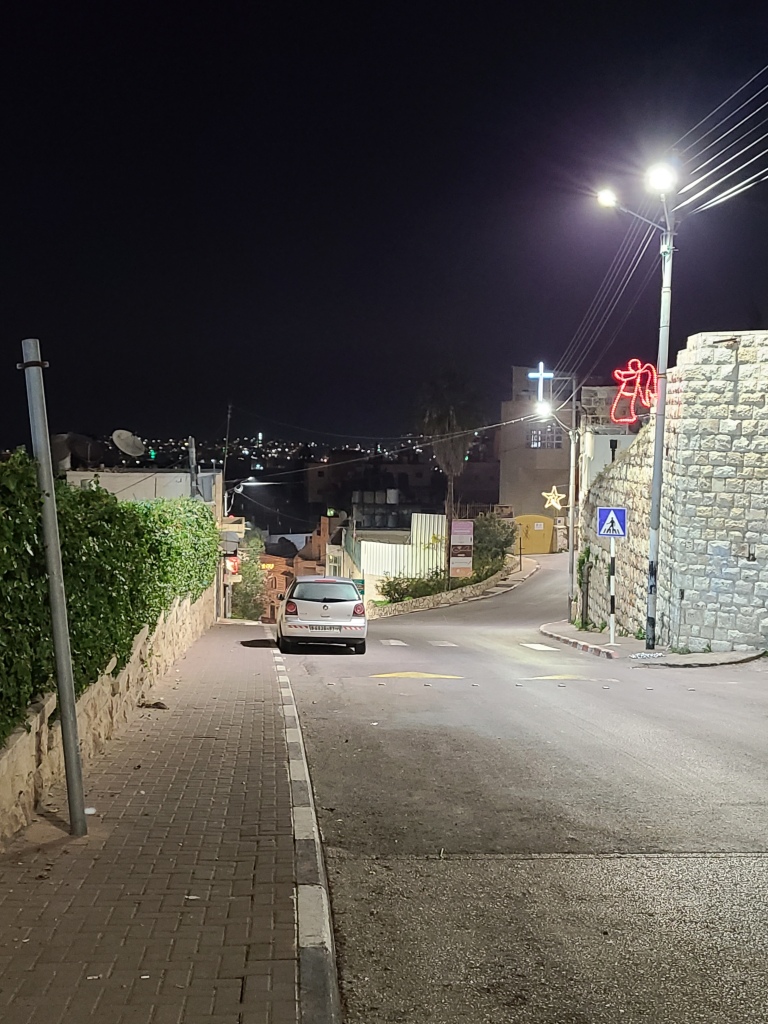
As I ran, I kept running into more beautiful Christmas lights, and couldn’t help stopping and taking more pictures! Haha
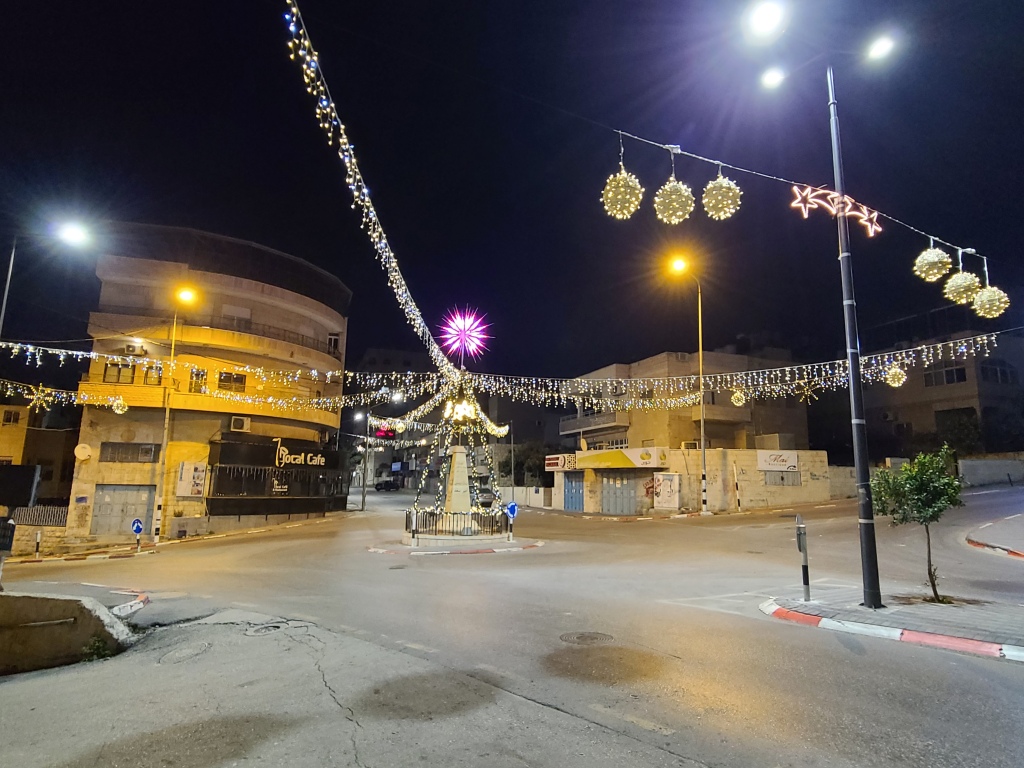
I finally arrived in the area of Beit Sahour and saw a lit-up monument to the Shepherds who, as St. Luke tells us, were the blessed first people to hear the Good News of Christ’s birth outside of Blessed Mary, St. Joseph, and perhaps some relatives or birth attendants. Surprisingly, according to Wikipedia, Beit Sahour is actually 80% Christian.
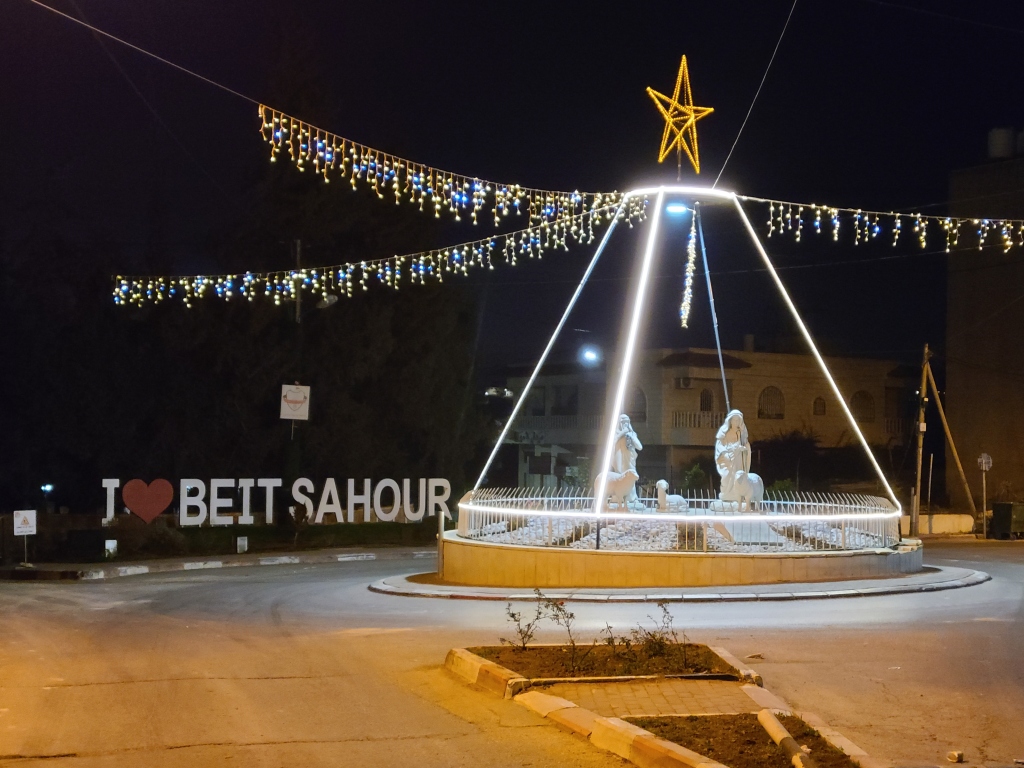
The star and the light above the Shepherds made a cool effect…similar to the Christmas Star and perhaps the angel who first spoke to the shepherds:
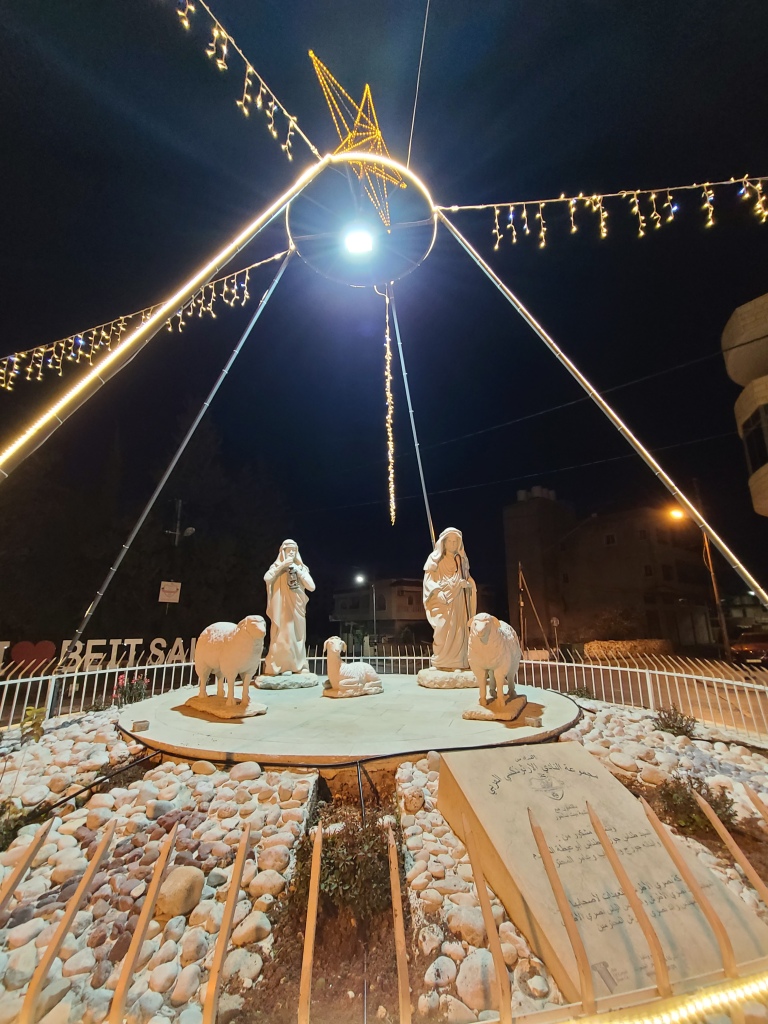
I finally made it to the gate of the Greek Orthodox Shepherds’ Field complex (GPS Coordinates: 31°42’5.83″N, 35°13’36.30″E). There are actually two Shepherds’ Field church premises in Beit Sahour: One Orthodox (Shepherds’ Field (“E”)–“E”astern Christian), and one Catholic (Sherpherds’ Field (“W”)–“W”estern Christian). I visited the Catholic Shepherds’ Field (GPS Coordinates: 31°42’26.52″N, 35°13’47.15″E) when I visited Bethlehem in 2012, but unfortunately the Greek Orthodox area was closed at that time. The Catholic site is about .5 miles to the north of the Greek Orthodox site. Both sites are very ancient, but veneration of the current Greek Orthodox site appears to be somewhat older, according to my research of the archaeology of the sites. Definitely possible as well that shepherds at both locations saw the angels on Christmas night which could be a reason for two traditions. Lord, please hasten the day when Orthodox and Catholic Churches are united again someday!
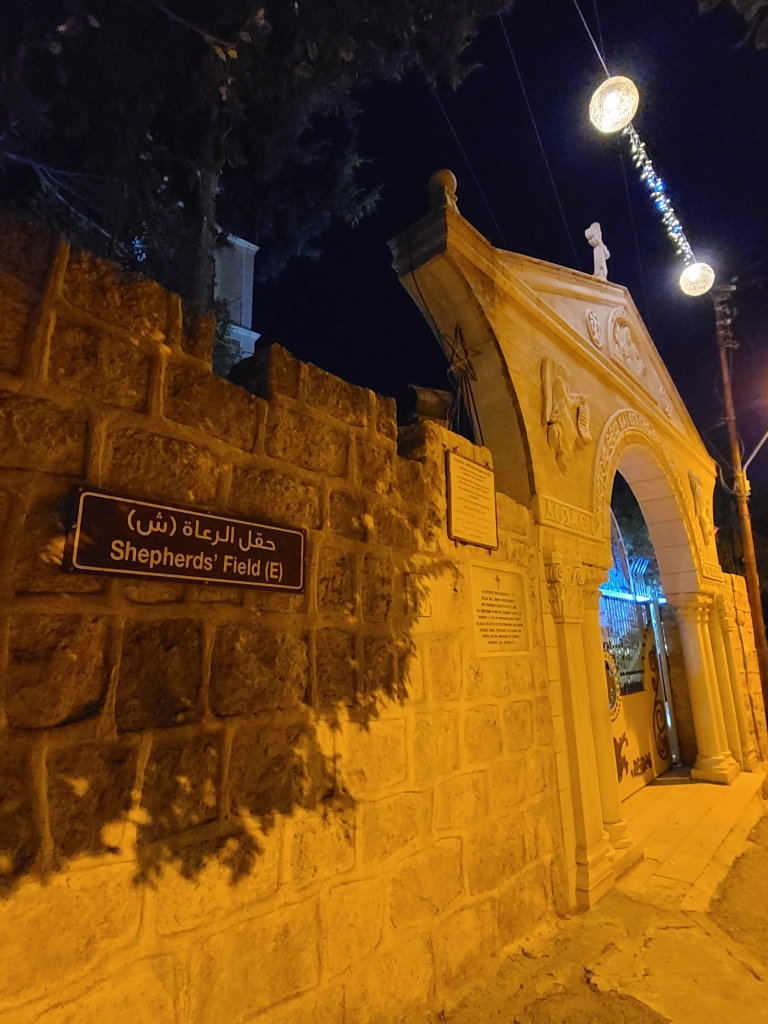
The gate was very beautiful and very cool to see the angels in adoration of our Lord on its facade.
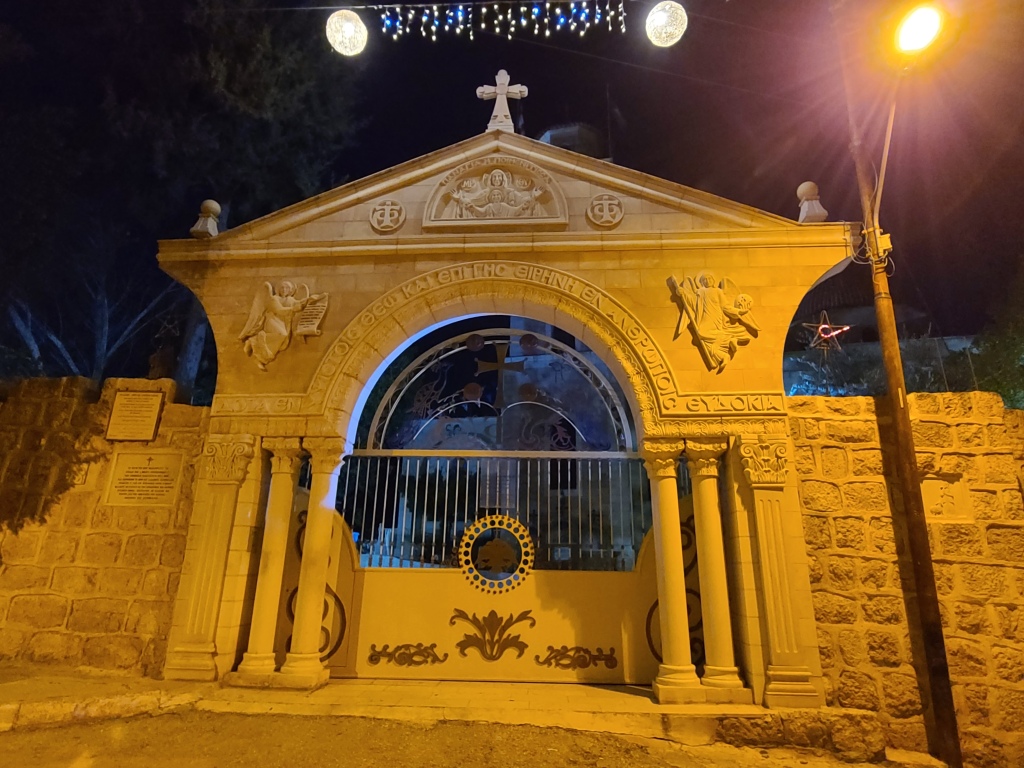
“So…this is where it all happened…” I thought.
I looked up into the dark sky above me and imagined it filled with angels glorifying God. Although nowhere near to what it must have looked like to the shepherds, the humble streetlight outside the gate shown its light down on me (see photo below). It was unmistakably another small, but powerful gift from our Lord to me–He gave me a miniscule impression of what light coming from above in the darkness at this holy place seems like. Although seemingly insignificant, it made an impact on me, and I was filled with gratefulness.
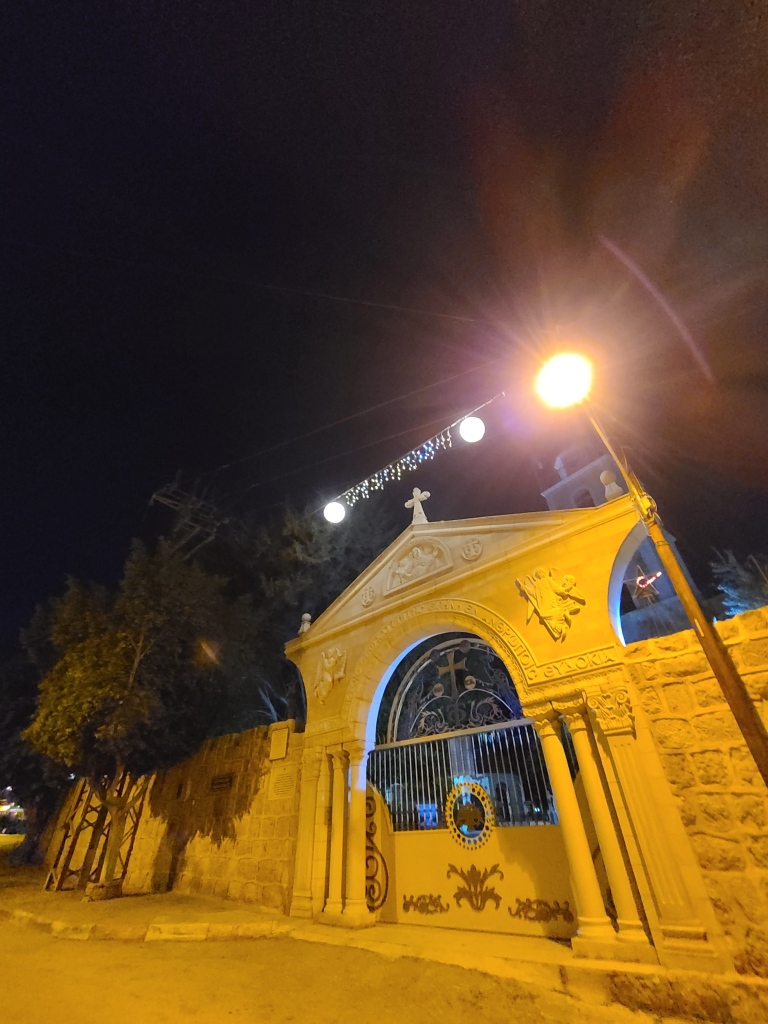
I brought up Luke 2: 8 – 20 on my phone and read about the appearance of the angels to the shepherds in the same place where it happened. It was incredible.
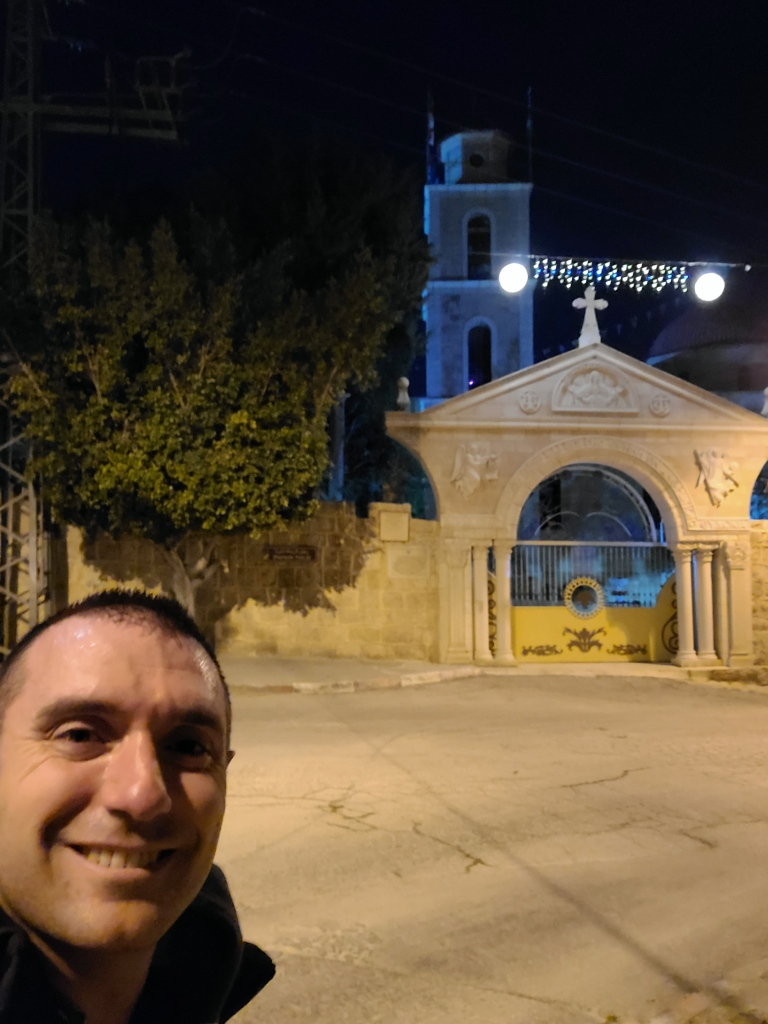
As I stood at the Shepherds’ Field, I thought to check to see what the temperature was outside. A common misconception is that Christ must have been born in the springtime, not in the wintertime, because it would have been too cold during the wintertime for the shepherds to be tending their flocks at night. Although it was cool at 5:54 in the morning on 13 January 2023, it was definitely not intolerable–a comfortable 46 degrees Fahrenheit. For me, it was even more evidence to support the traditional placement of Christ’s birth in the wintertime.
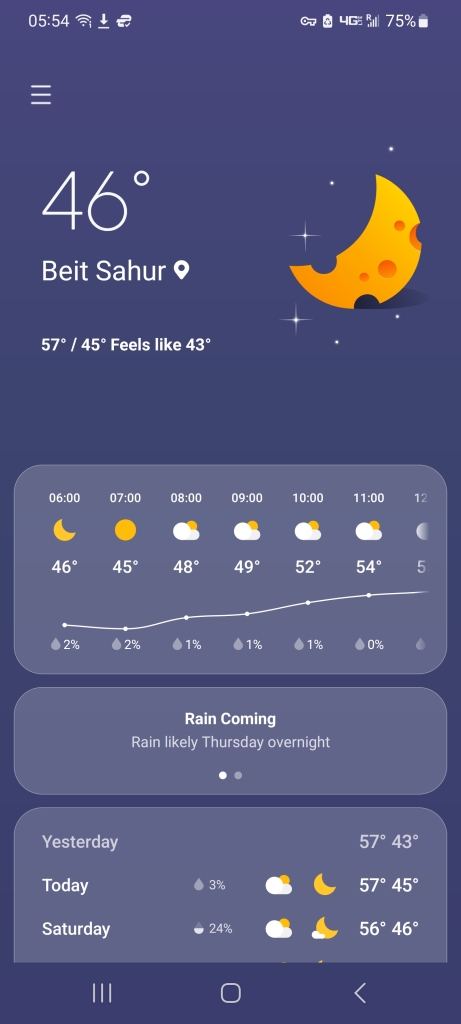
After some prayer and meditation, I set my sights on my next stop, back westwards from the Shepherds’ Field and up to the Cave of the Nativity–the cave where Our Lord was born. I would now be following the path of the shepherds as they “went with haste” (Luke 2:16) to find the “Babe wrapped in swaddling cloths and lying in a manger” (Luke 2:12) as the angel had told them. It was a mile back from where I had come…uphill this time! I saw a church tower lit up in the distance (see the photo below). It was not the Church of the Nativity, but that’s the direction I needed to go.
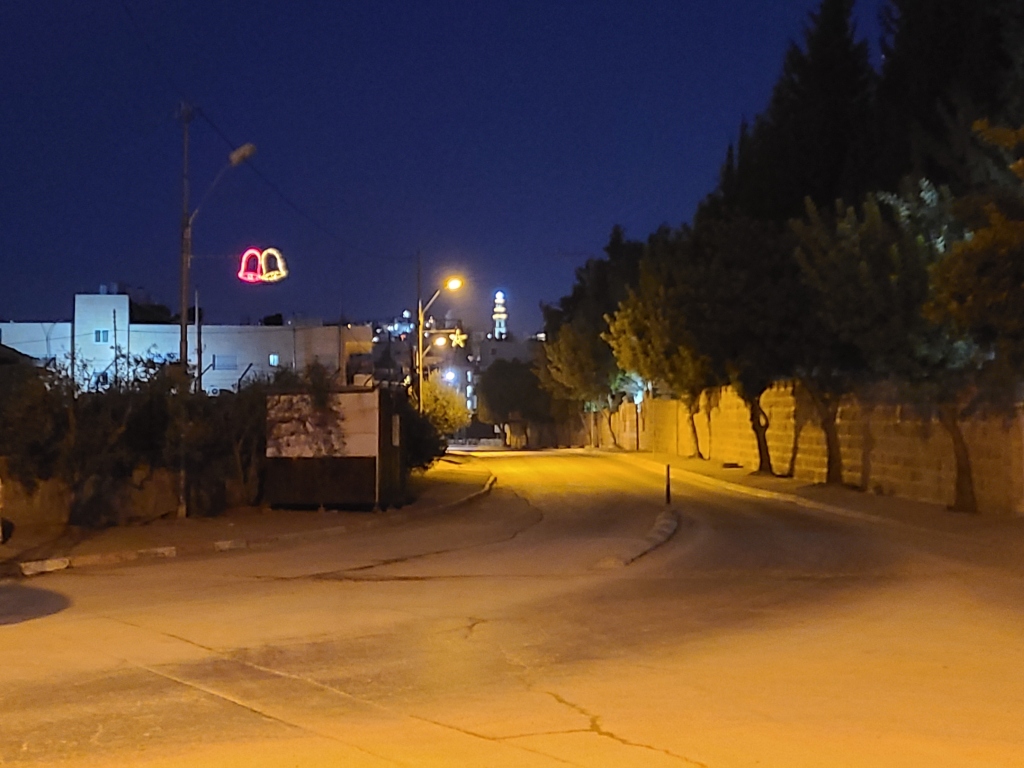
As I began walking, I snapped some pictures of some fantastic tiles inlaid into the wall around the Greek Orthodox Shepherds’ Field complex.
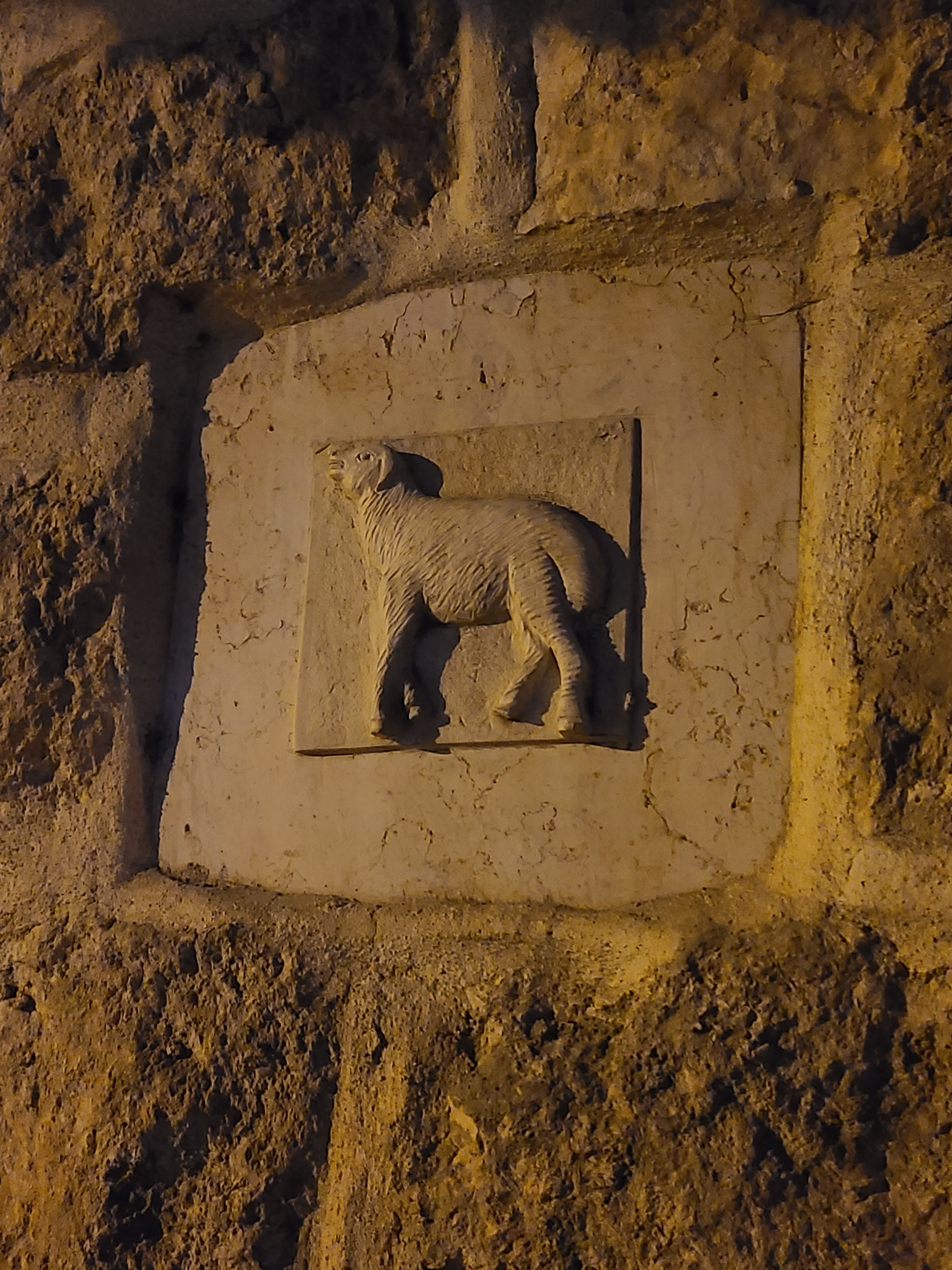
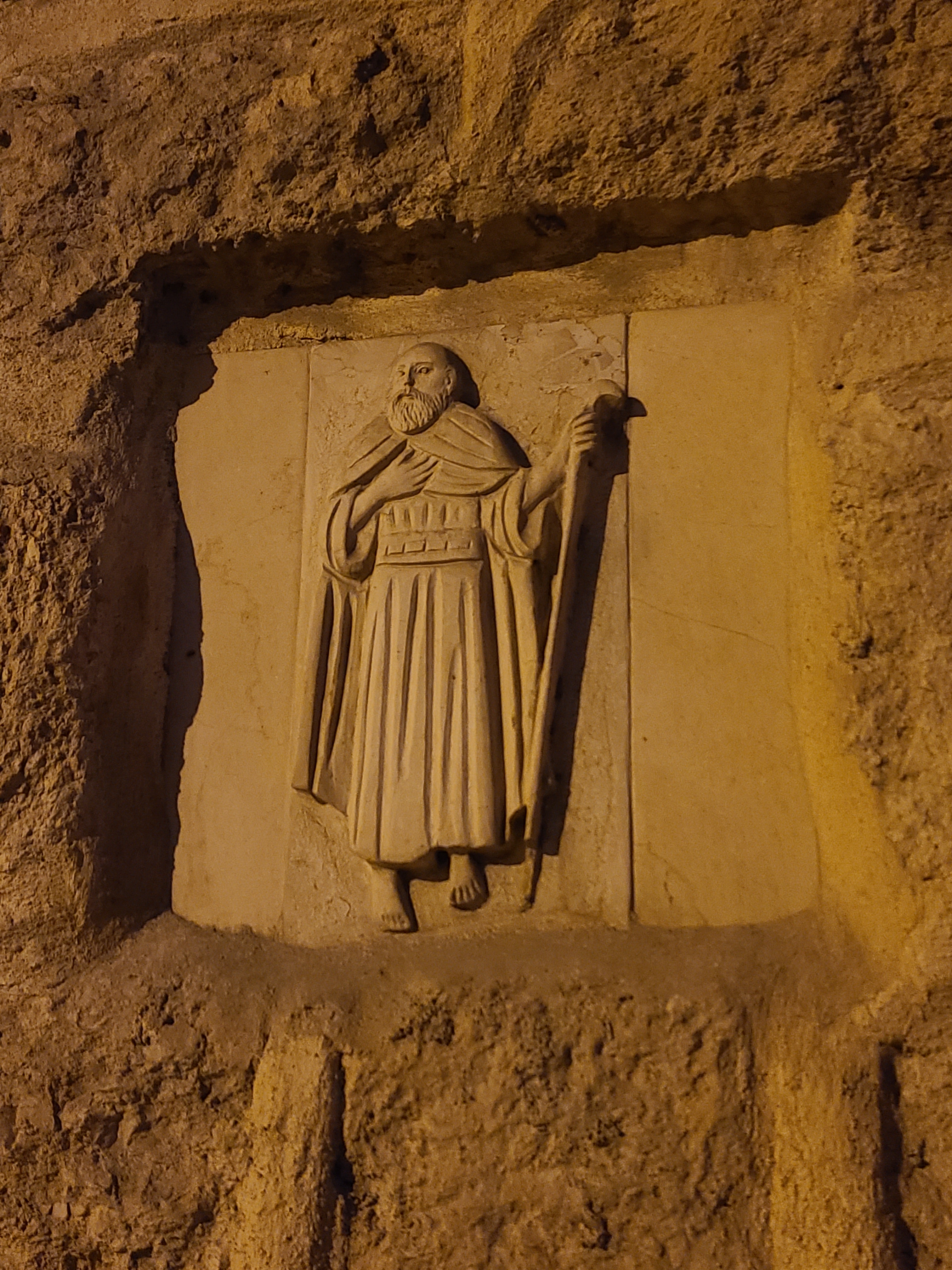
I walked westwards past a large field adjacent to the Greek Orthodox Shepherds’ Field complex (which one tradition holds is the Field of Boaz where Ruth and Boaz, the great grandparents of King David, met! (GPS Coordinates: 31°42’7.26″N, 35°13’27.13″E)) and got an even better view of the sky where the angels appeared. Additionally, the sunrise began to beautifully light up the dark sky.
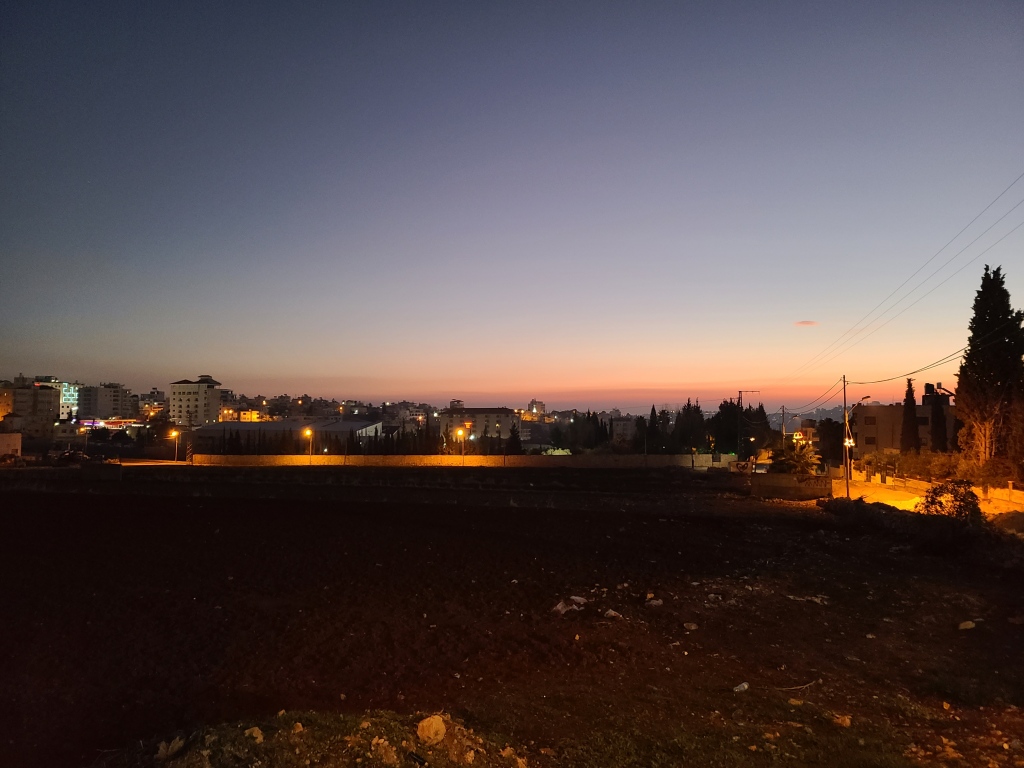
As I traced the steps of the shepherds up to Bethlehem, I feel like I may have actually learned more about them in the process. One of the things I learned was–they were probably in pretty good physical shape! Walking the route up to Bethlehem from the Shepherds’ Field is not a “walk in the park.” It is a steep, over 1-mile walk uphill. I estimate the average steepness grade is about 8 to 9%. To put that in perspective, that is steeper than Boston’s famous “Heartbreak Hill” along the Boston Marathon route whose average grade is only 5%.
I took plenty of pictures along the long route uphill. The brightening morning sky made for some gorgeous views as I drew closer and closer to the Church of the Nativity…
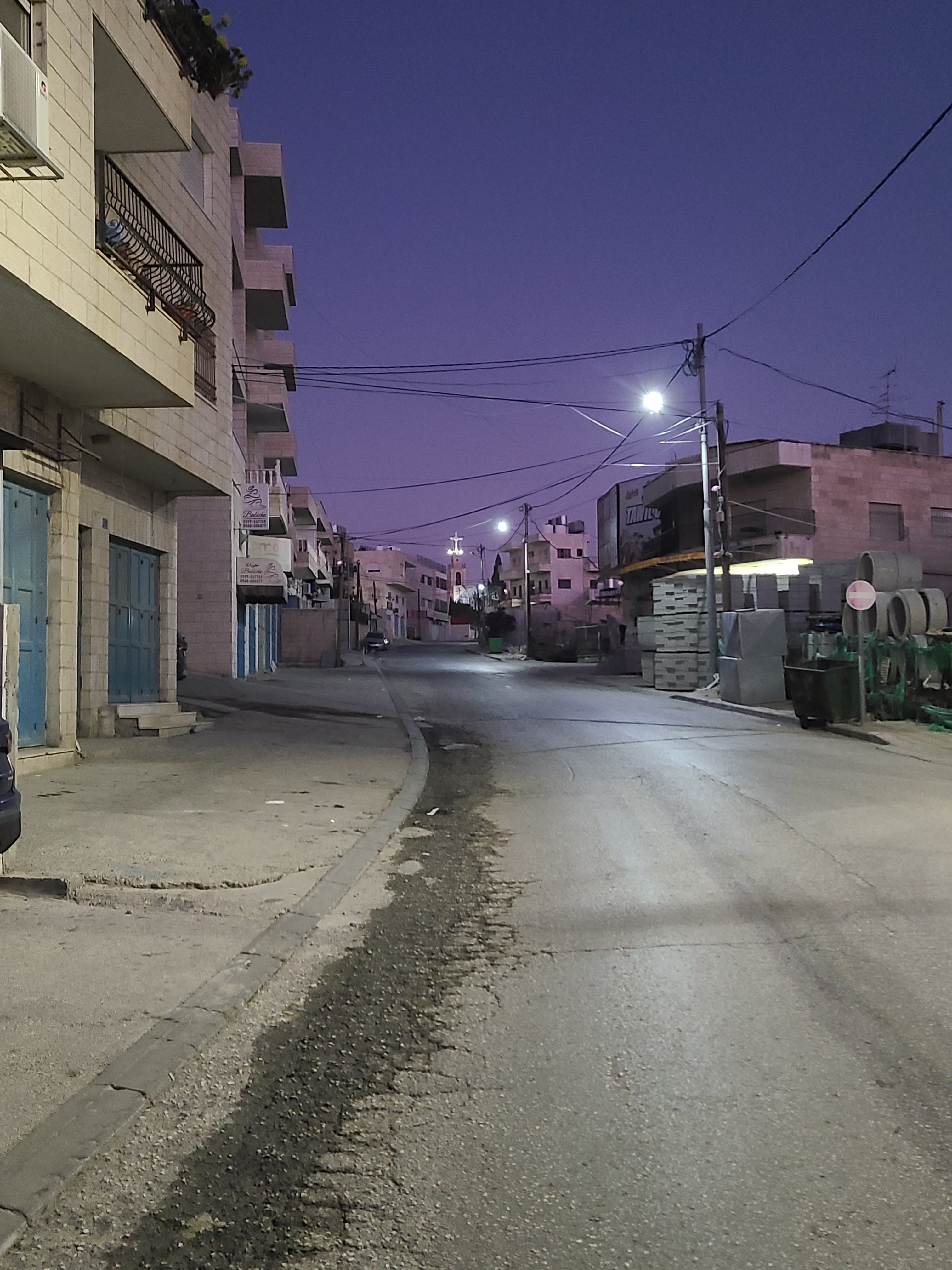
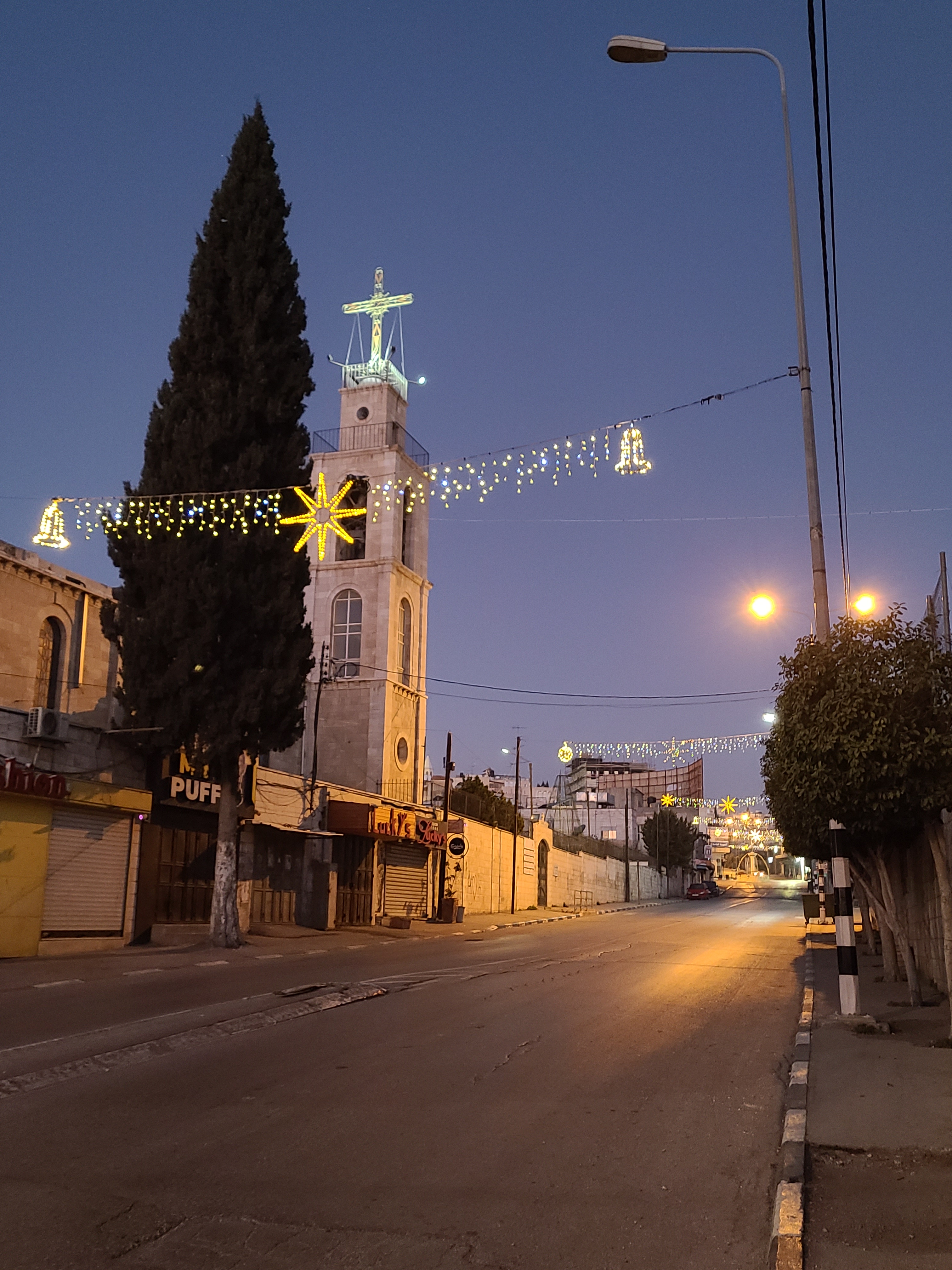
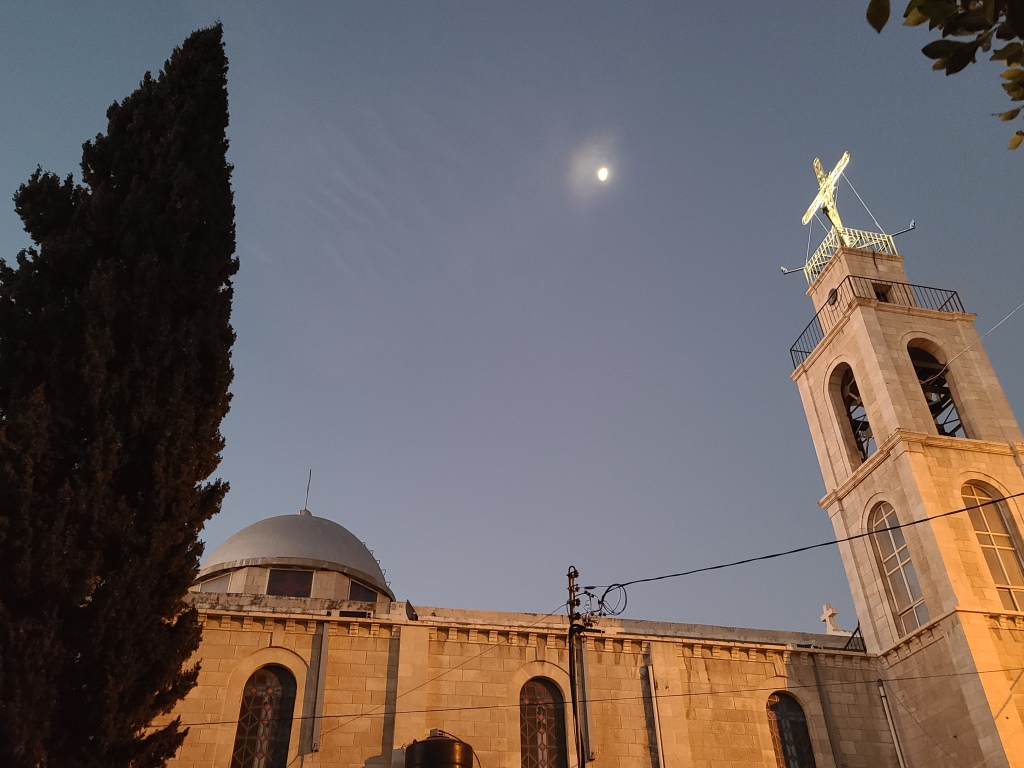
The sunrise was beautiful…
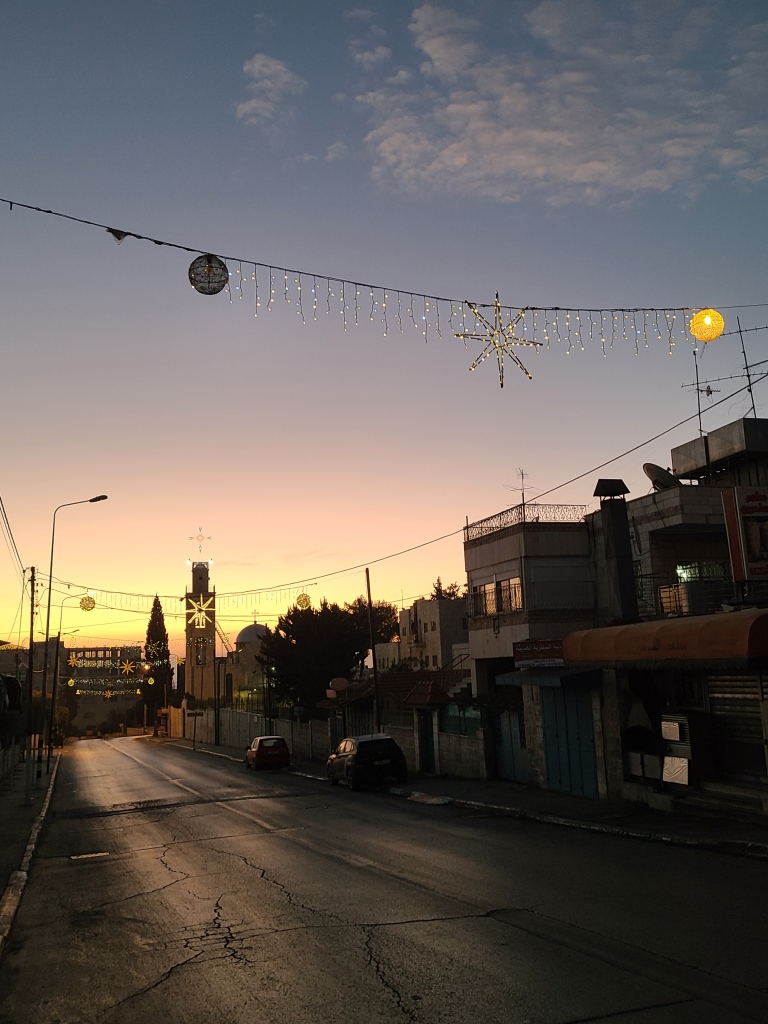
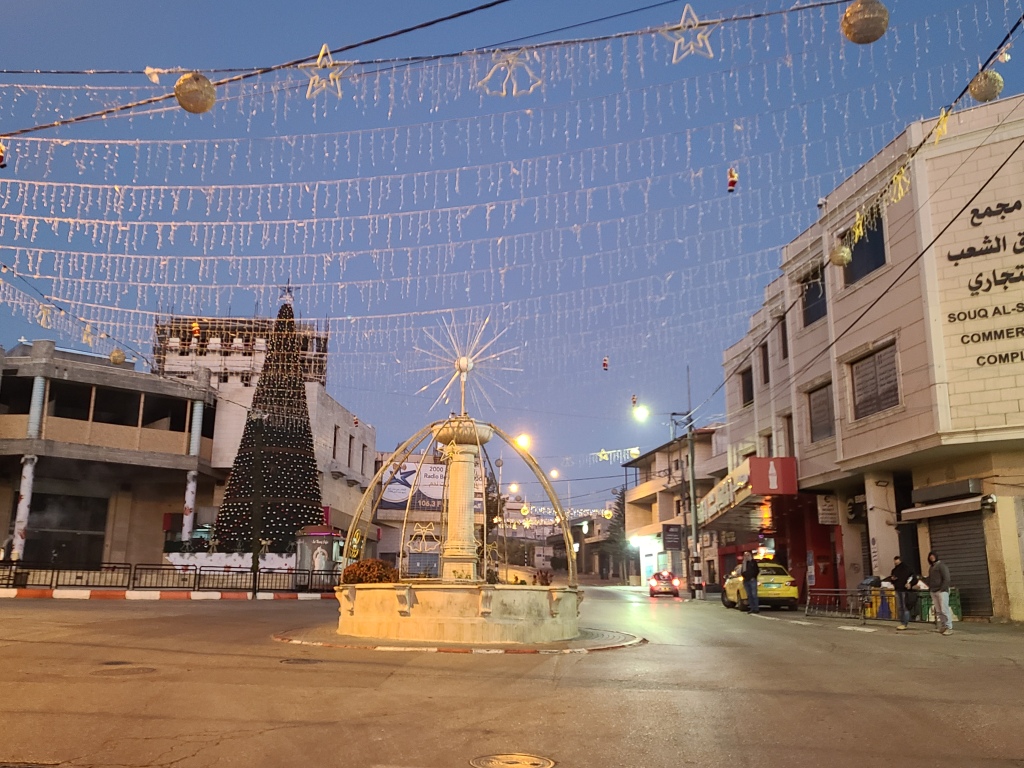
A Christmas tree in one of the squares of Bethlehem:
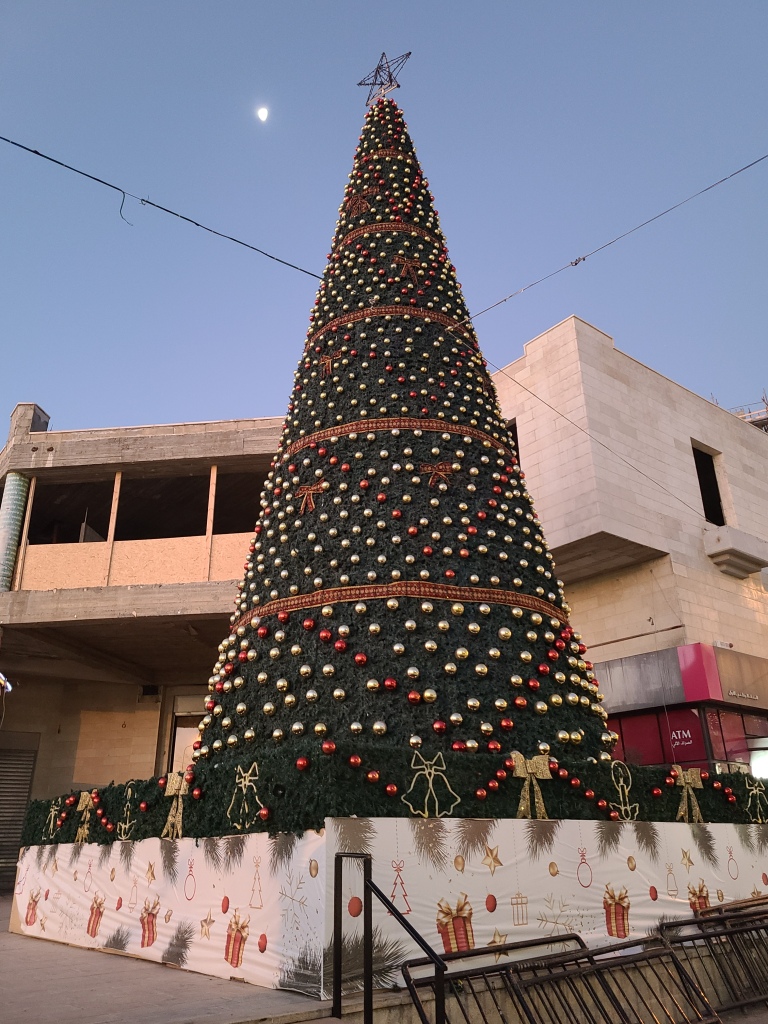
…Still going uphill westwards…whew!:
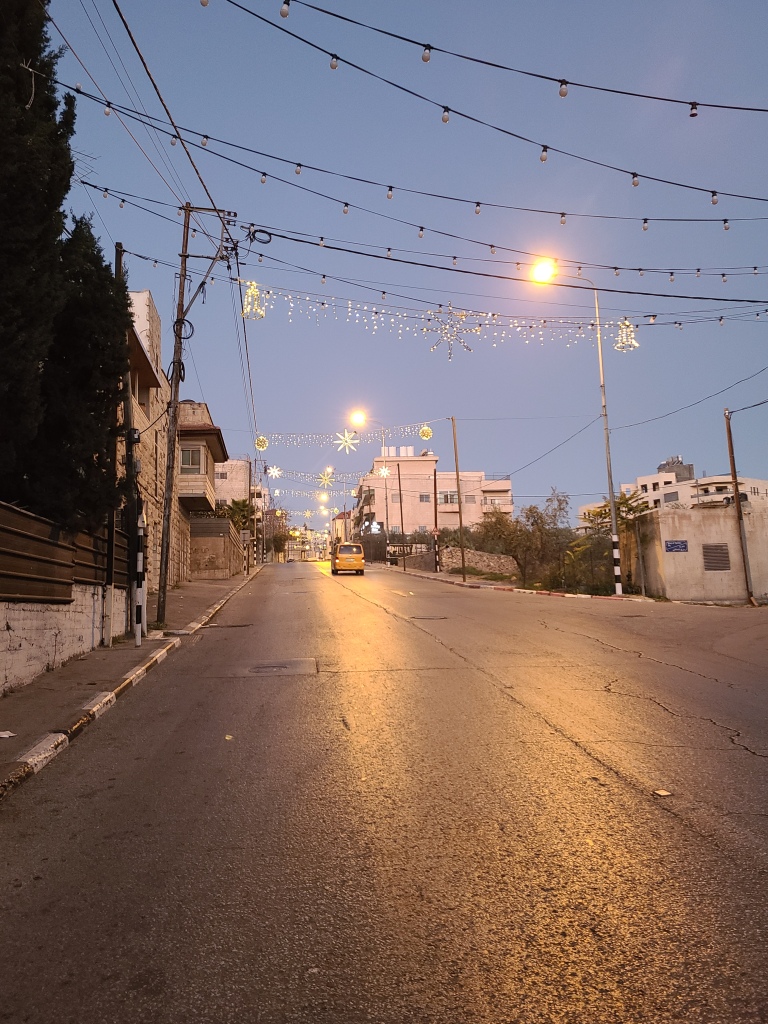
While I was walking uphill into Bethlehem, I saw a beautiful grove of olive trees along the road…
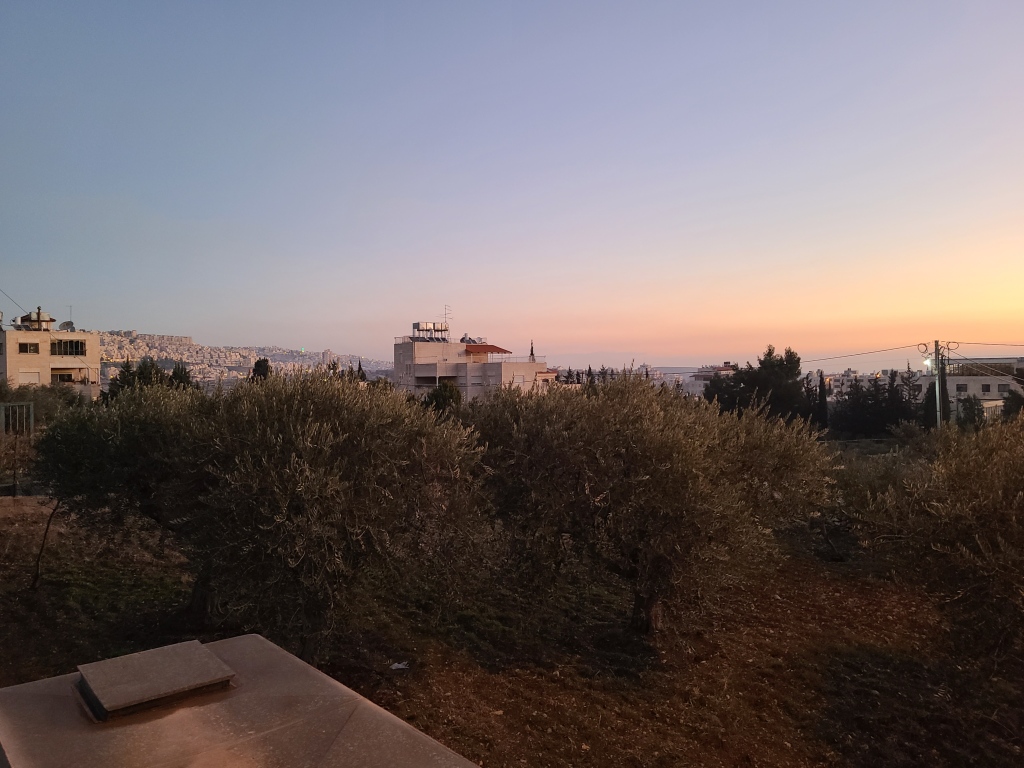
I kept getting higher up towards Bethlehem…and would occasionally look behind me to see the sunrise and the area of the Shepherds’ Field in the plain below:
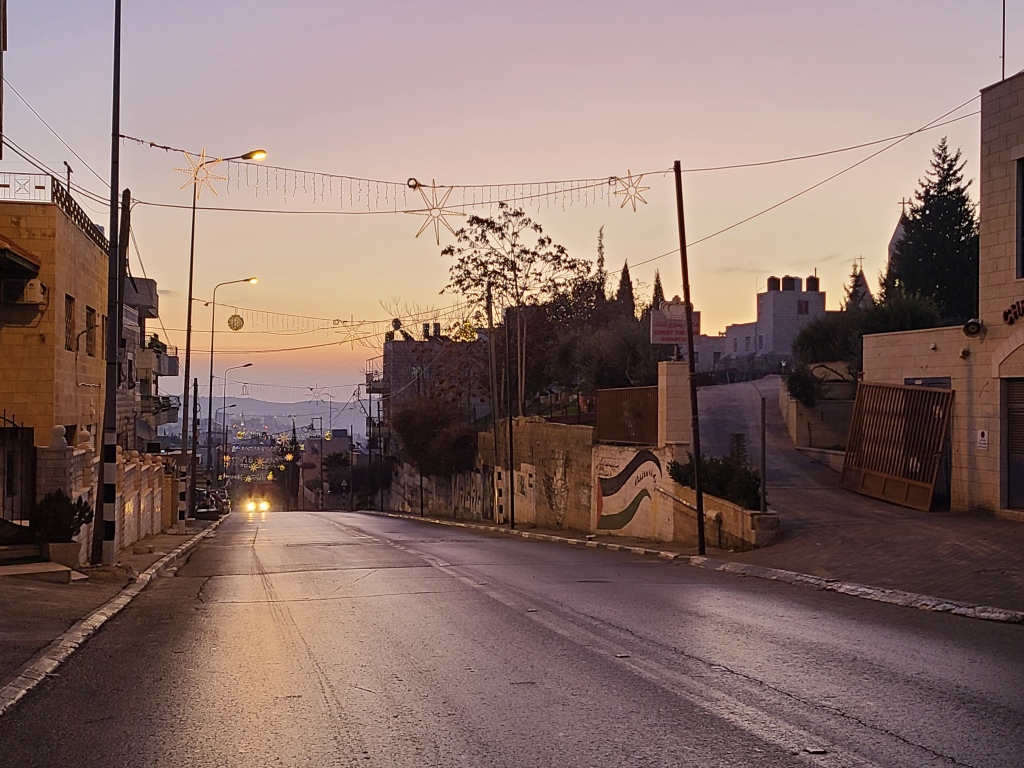
I was now also able to make out some of the large apartment complexes in the distance…
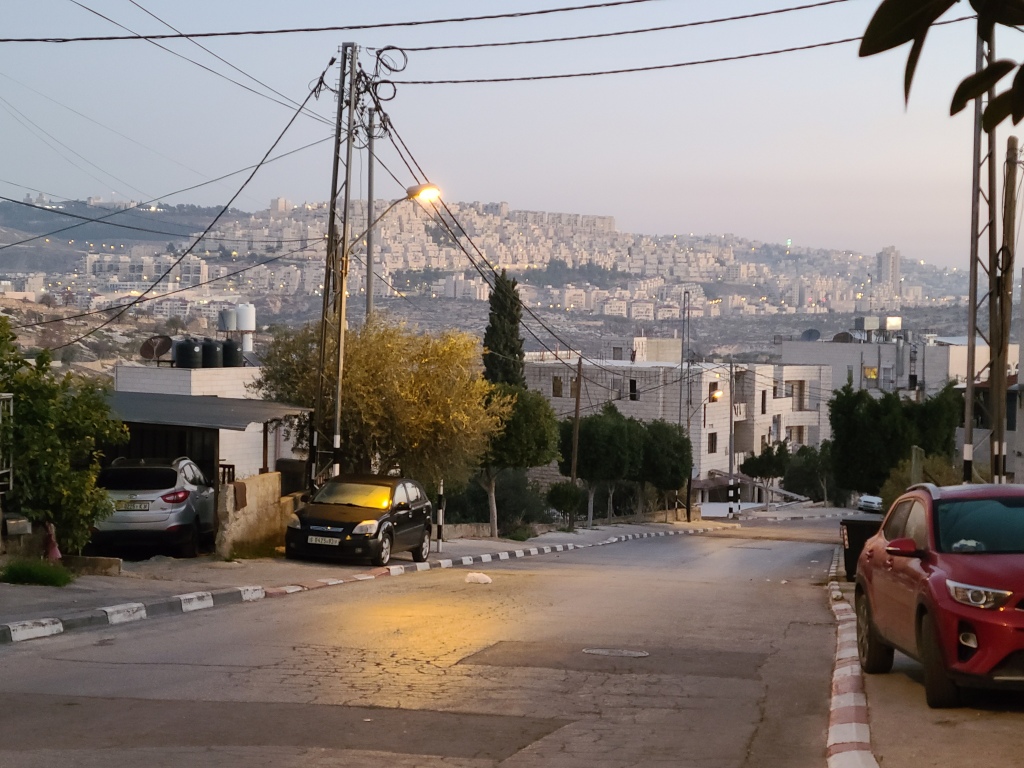
I soon saw a sign for “Saint Joseph Street”…I was getting closer to the Church of the Nativity! It was cool to see St. Joseph’s name in Arabic.
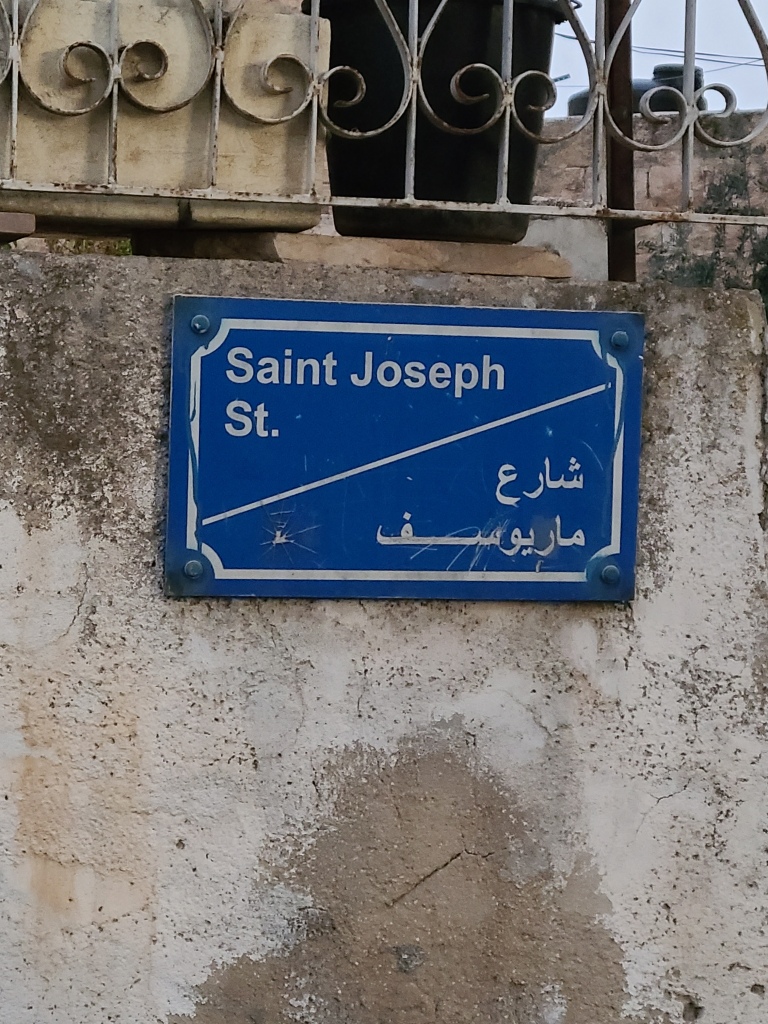
Still going uphill, but only about 600 meters away from the Church of the Nativity now…
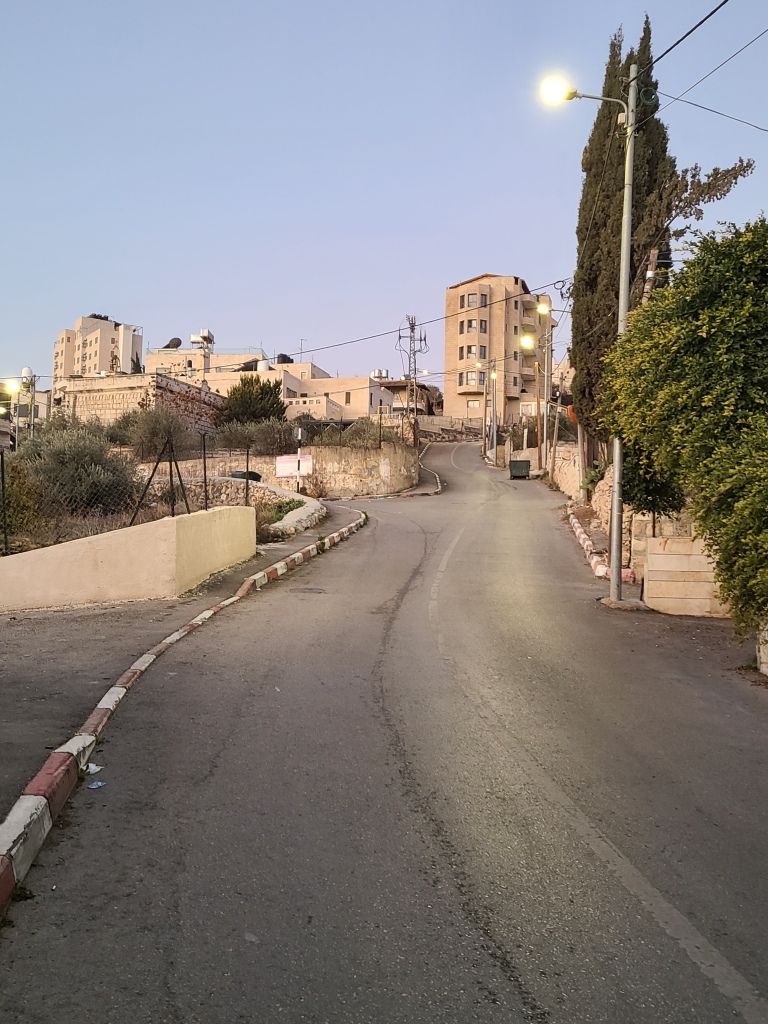
About 500 meters from the Cave of the Nativity, I found another cave, cut into the soft Bethlehem stone, which appeared to still be in use today. It was interesting to think the cave in which our Lord was born may have been somewhat similar to this one…at the very least it was made of similar stone!
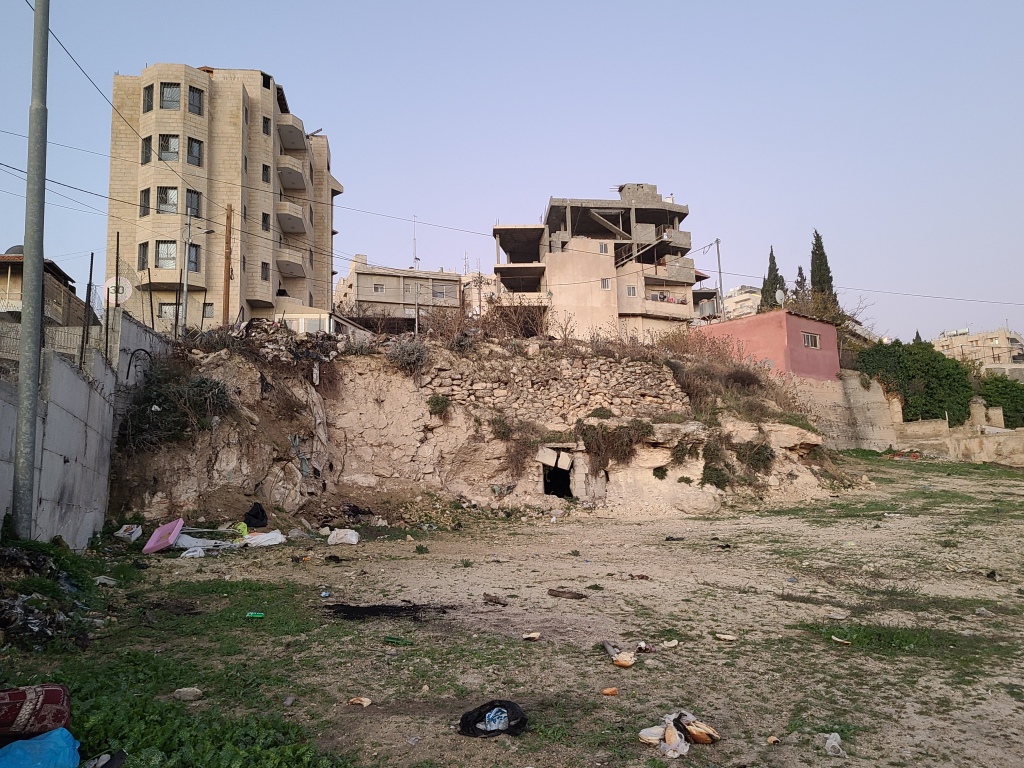
Some of the natural Bethlehem stone from the entryway to the cave:
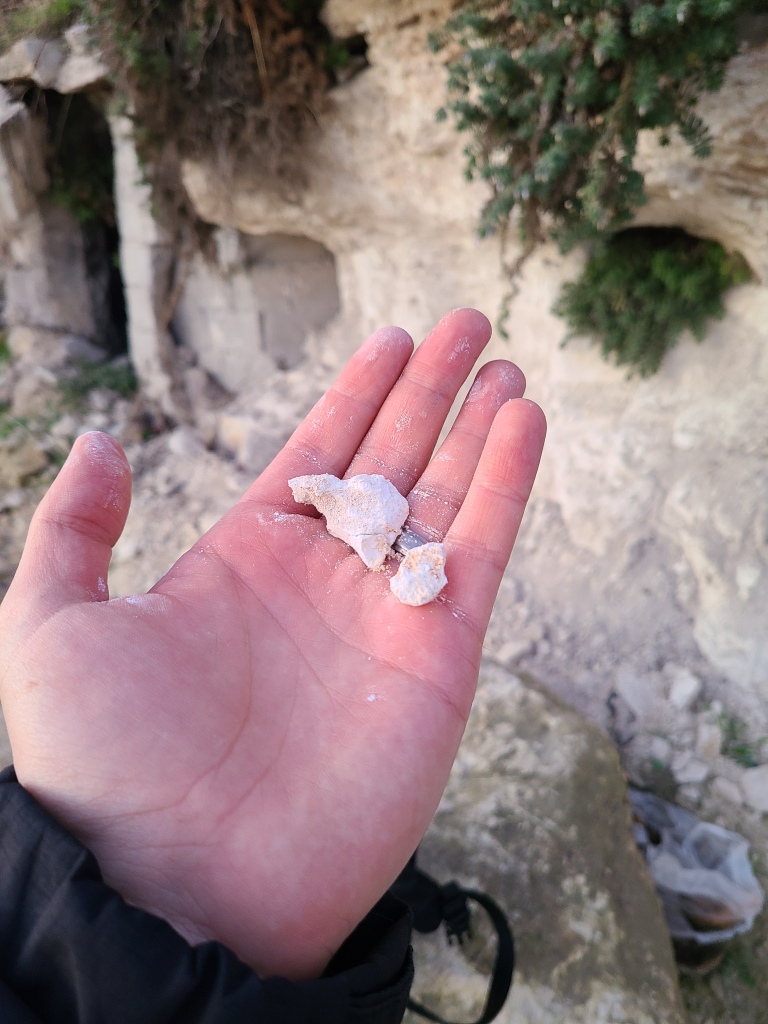
…Still going westward uphill…
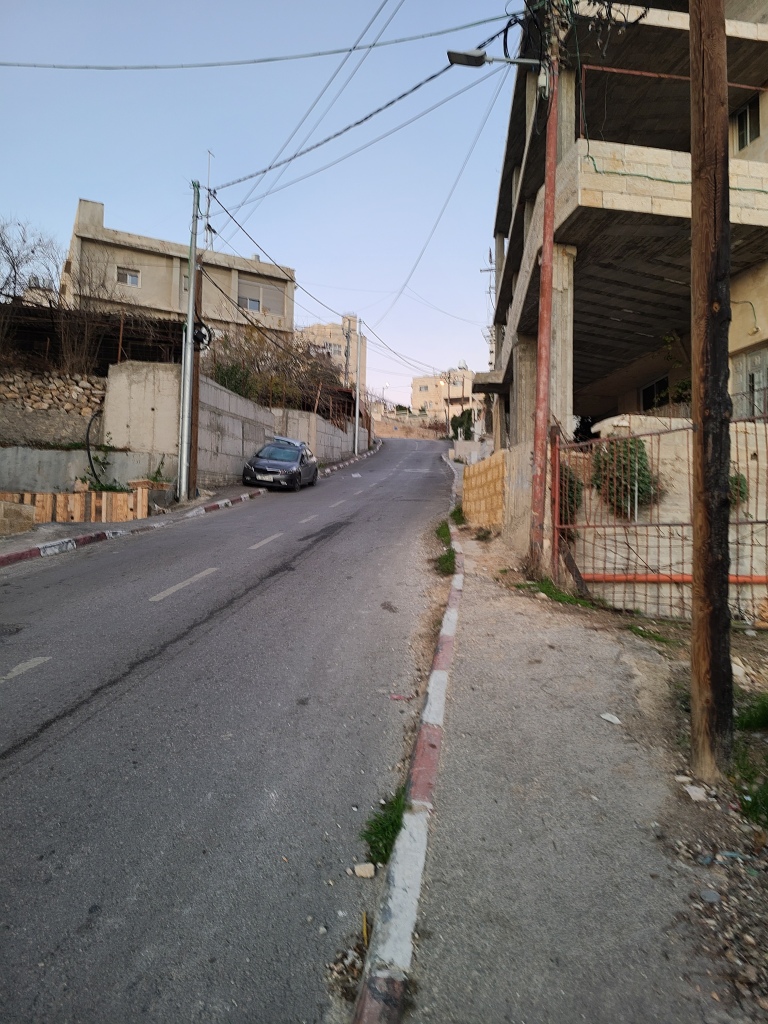
A beautiful view of the Field of the Shepherds below, to the east.
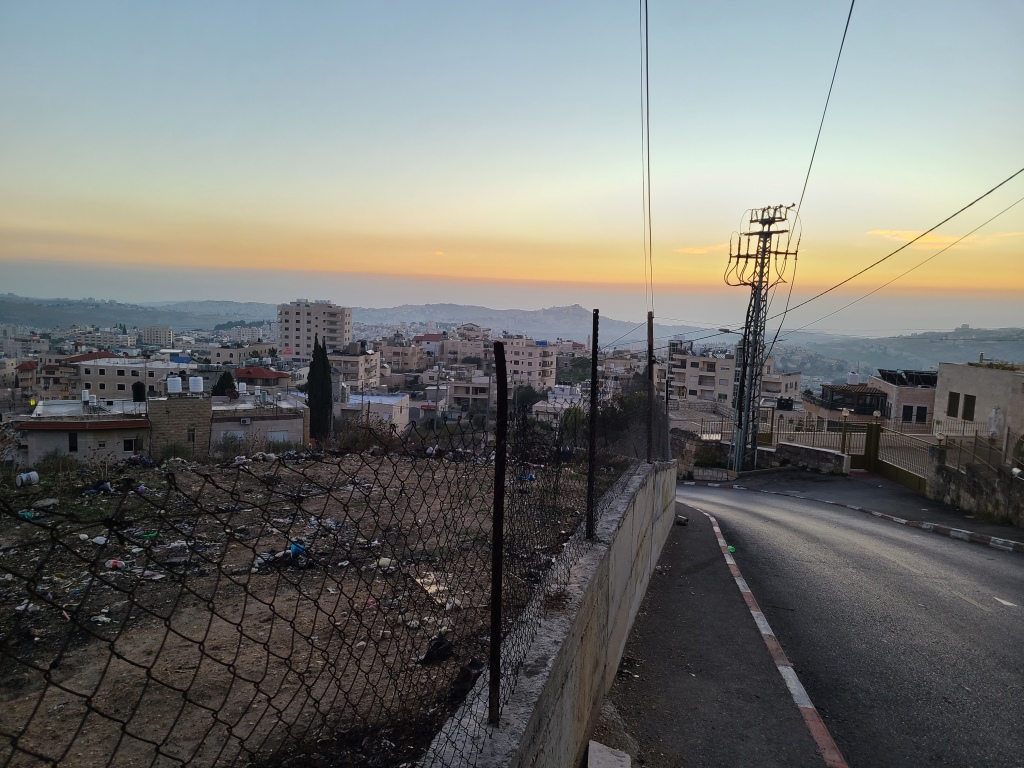
View from the hill of Bethlehem looking towards the southeast:
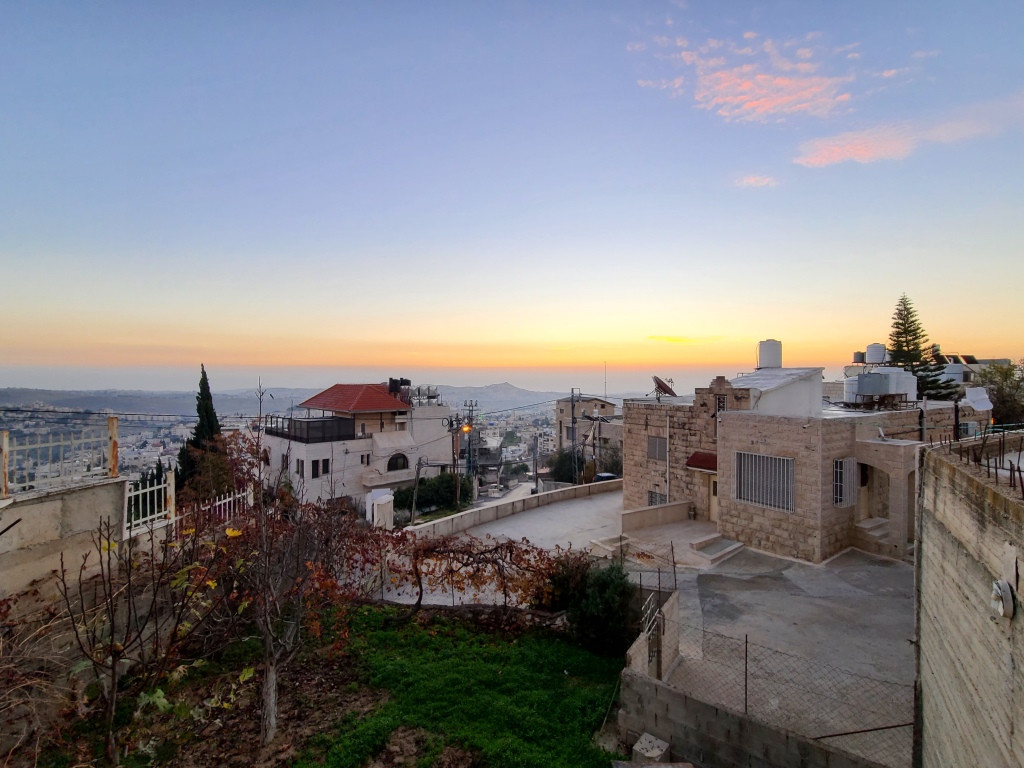
View of the Shepherds’ Field (the cluster of trees in the upper middle of the photo below, to the left of the golden dome) from the hill of Bethlehem:
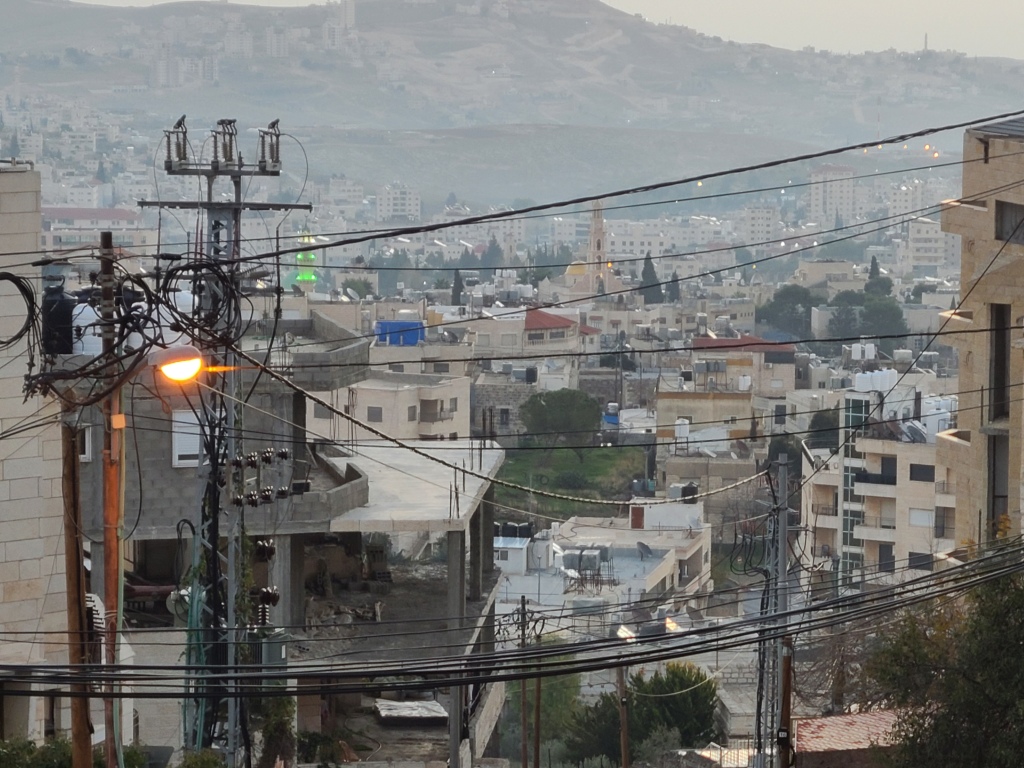
Some zoomed-in views of the lovely sunrise to the southeast of the hill of Bethlehem:
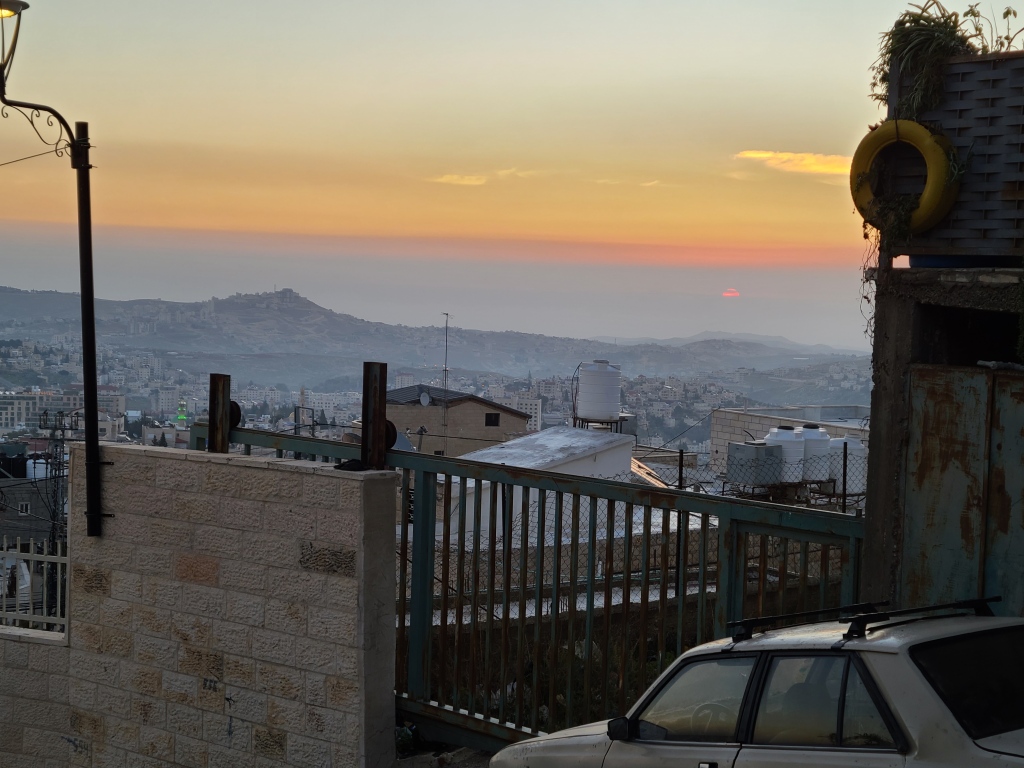
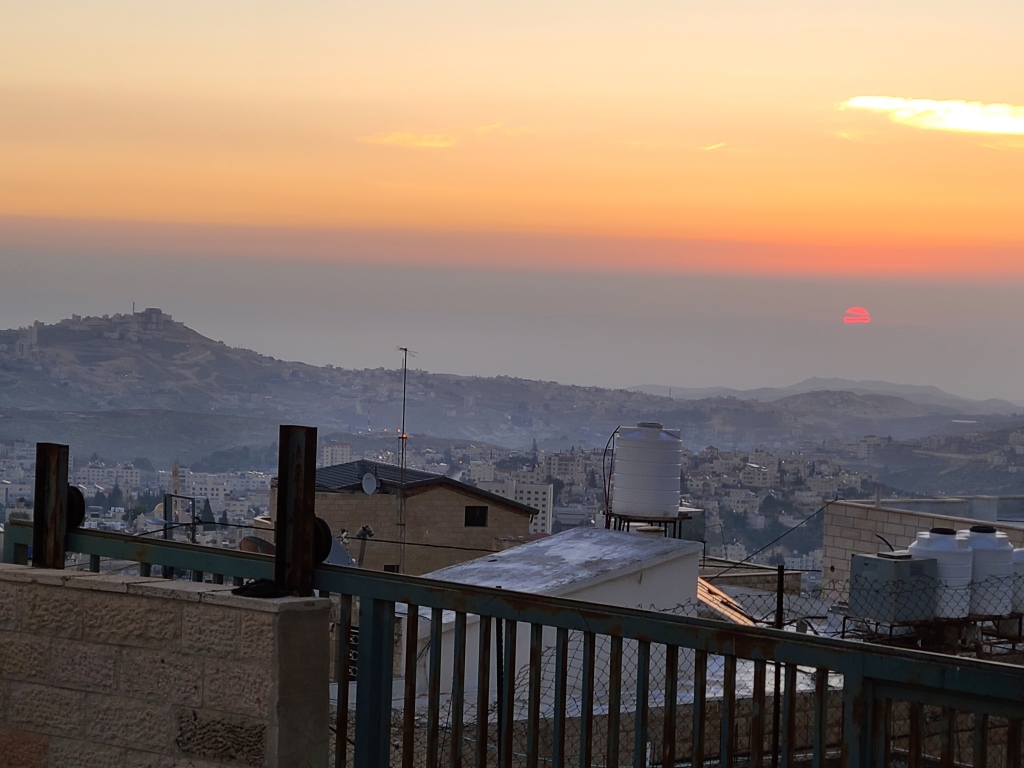
…Still going westwards uphill…are we there yet???
…Only about 200 meters away from the Cave of the Nativity now!

In the photo above, I was now standing within the area archaeologists have determined was the site of the town of Bethlehem dating to the Iron Age – from about 1200 B.C. to 600 B.C. A survey conducted by S. Gutman and A. Berman examined the area of Bethlehem in 1969 and some of its findings are documented in the French archaeological journal Revue Biblique, Volume 77, pages 583 to 585. This article provides us a map of the hill of Bethlehem (below) that shows the site of Iron Age Bethlehem (the shaded area) in relation to the Church of the Nativity (represented by the black shape in the middle of the map).
The shaded area would have been the site of the town King David was from (he lived in about 1000 B.C.). The presence of the Cave of the Nativity within this area indicates there is good cause to believe this area may have later been the approximate site of the Roman town as well; and, vice versa, the presence of the Cave within the area of the town lends credence to the credibility of the tradition linking the Cave to Christ’s birth.
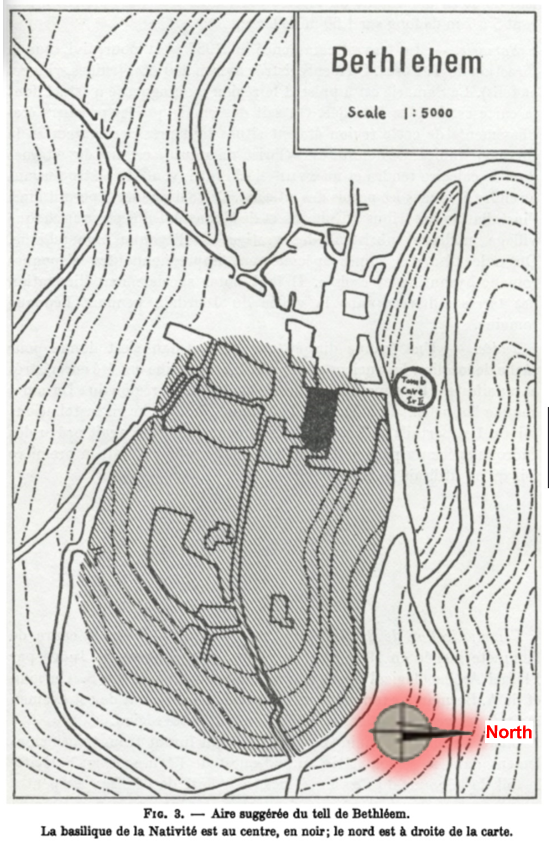
As I walked westward up the path of the shepherds and thought of the location of the little town of 1st Century Bethlehem, I came to a beautiful realization:
Supposing the limits of the town of Bethlehem in Roman Times (i.e. the 1st Century) were similar to those earlier in the Iron Age, and considering the Cave of the Nativity would then have been found on the western *edge* of the town (i.e. the side of town Mary and Joseph would have probably encountered first following the main road south and east from Jerusalem), it appears St. Joseph wanted to find shelter at one of the first opportunities possible to care for his wife and the new Baby.
The shepherds, therefore, coming into Bethlehem from the opposite direction of Mary and Joseph (*and* after journeying one mile up a steep hill–and doing so “in haste”!) may have had to *persistently* search westwards through the whole town of Bethlehem before finally finding the “babe wrapped in swaddling cloths and lying in a manger” on the opposite side of the town from which they came. As they searched, they had to have been tired and perhaps even slightly discouraged that they had not yet found the baby spoken of by the angel. However, they had been convicted by what they saw and heard in the field below. Their faith did not waver, and they became the first group of people outside Our Lady and St. Joseph to behold the long-awaited Messiah and the world’s Salvation!
I was able to transpose the shaded area of the map onto Google Earth to show what buildings/areas are now over the site of the Iron Age town of Bethlehem in the present day:
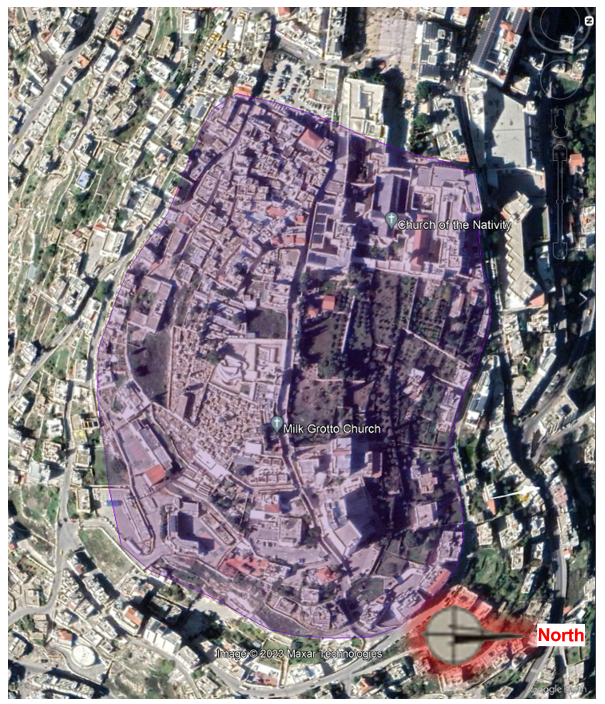

As I walked up the street through the ancient site of the town of Bethlehem, I saw a sign for the entrance to a Monastery for the Perpetual Adoration of the Blessed Sacrament. Truly, in Bethlehem’s dark streets shineth the everlasting light–even today! It was beautiful to see.
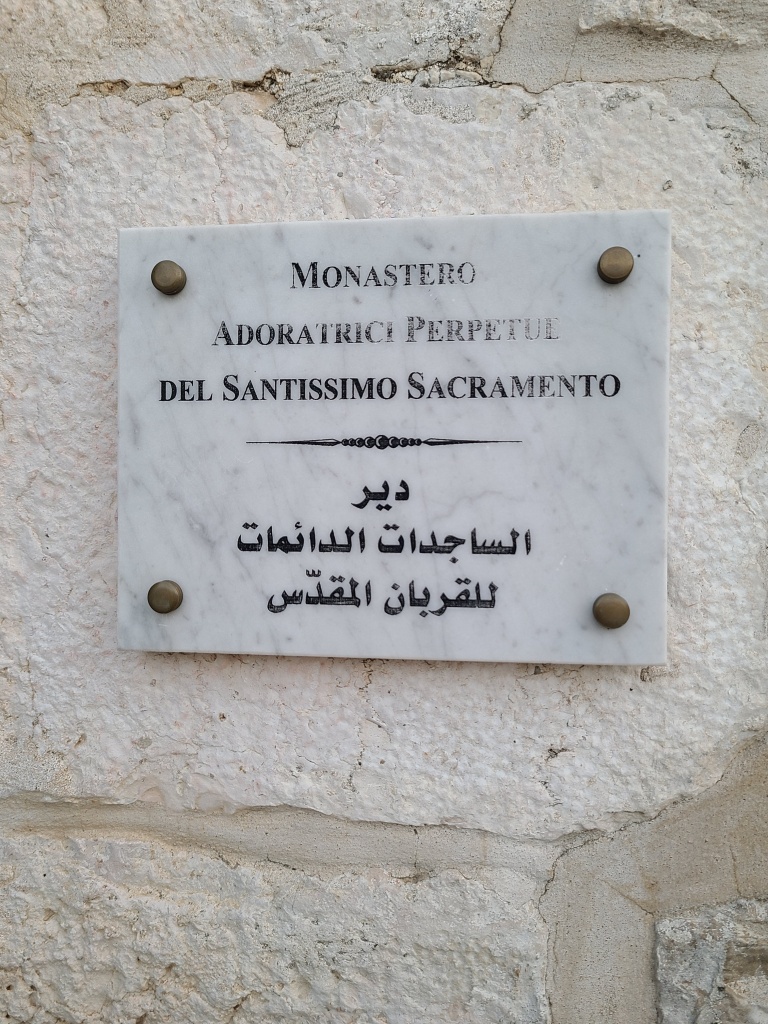
I kept walking and finally made a right turn and found myself back in Manger Square. Immediately in front of me was the humble, insignificant entrance to one of the holiest places on earth: The Church of the Nativity (GPS Coordinates: 31°42’15.46″N, 35°12’27.10″E).

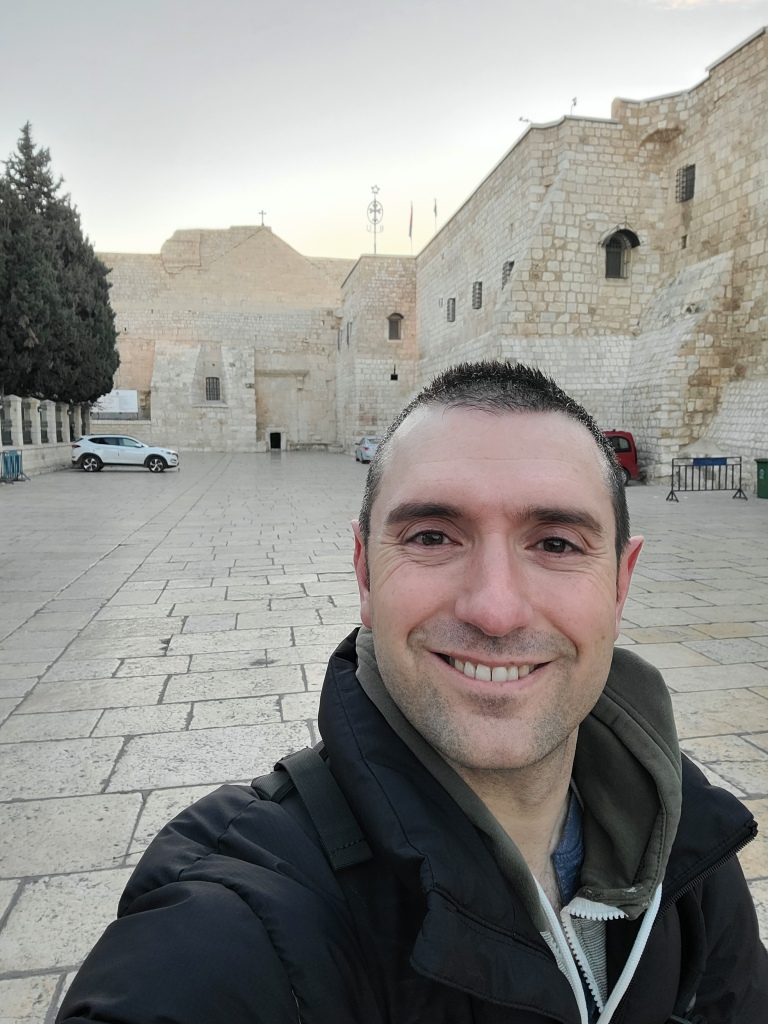
The photo below shows the doorway into the Church of the Nativity. It’s obviously been reconfigured over the last 1,700 years since it was originally built. The horizontal beam in the middle of the photo was actually the lintel of the doorway into the church in Byzantine Times. This was later filled in by the Crusaders to create a smaller arched entrance (the outline of which you can still make out). Finally, the entrance was made even smaller after the Crusades–the small entrance that exists to this day–to prevent looters from bringing in carts to take away valuables.

The short, 4-foot entrance now requires all who enter to bow down and humble themselves as our Lord humbled Himself by becoming a small baby in order to save us all.
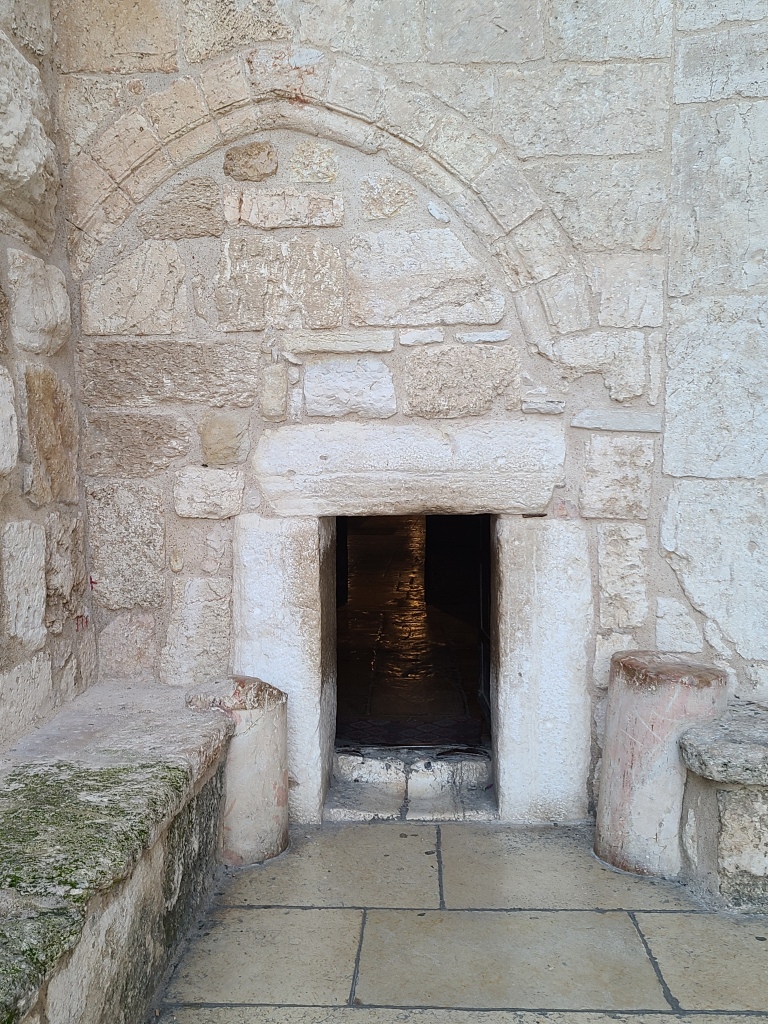
I passed through the small door and entered the narthex of the church:
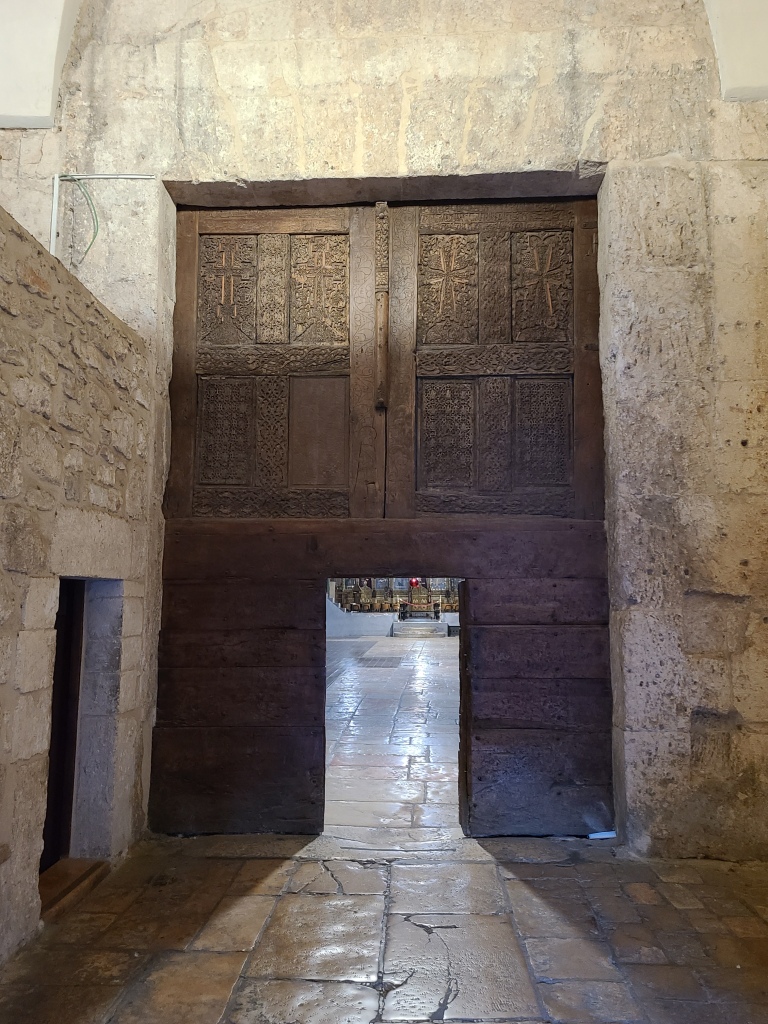
I went through the narthex’s doorway and into the Church of the Nativity itself. The floor plan of the church has been largely unchanged throughout its 1,700 year history. It’s amazing to think of the millions of liturgical celebrations held here over 1,700 years. I wonder what the first Mass celebrated here was like?
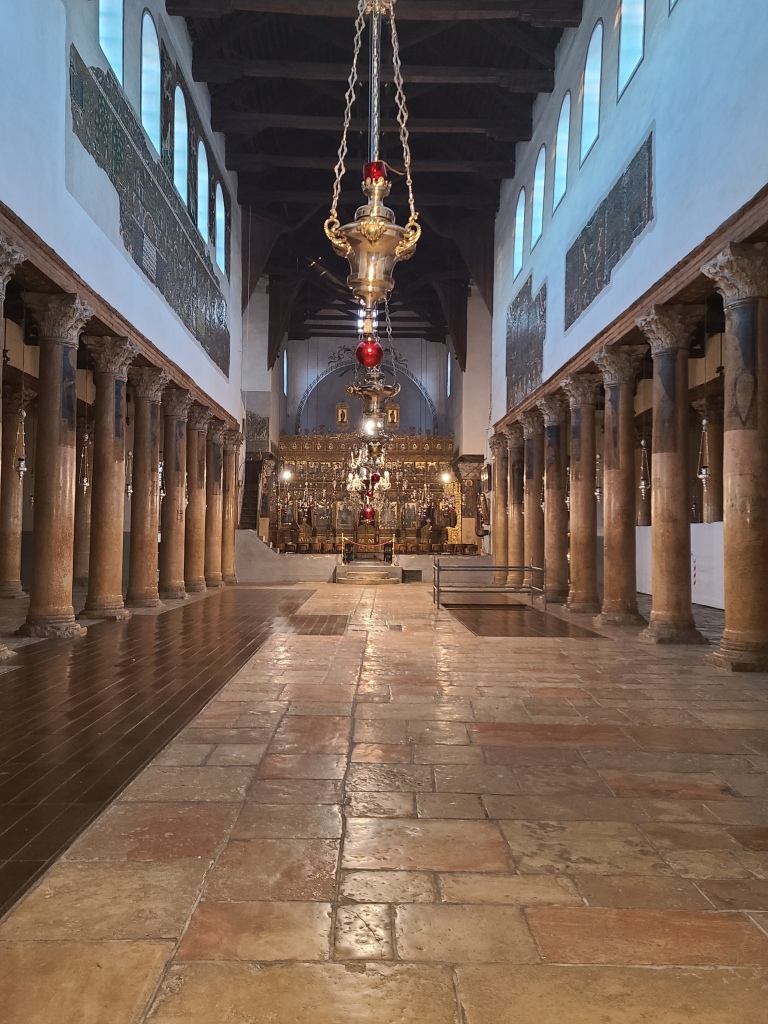
Wooden panels cover up mosaic flooring dating to the Constantinian Basilica from the A.D. 300s. This floor was discovered under the modern flooring during excavations:
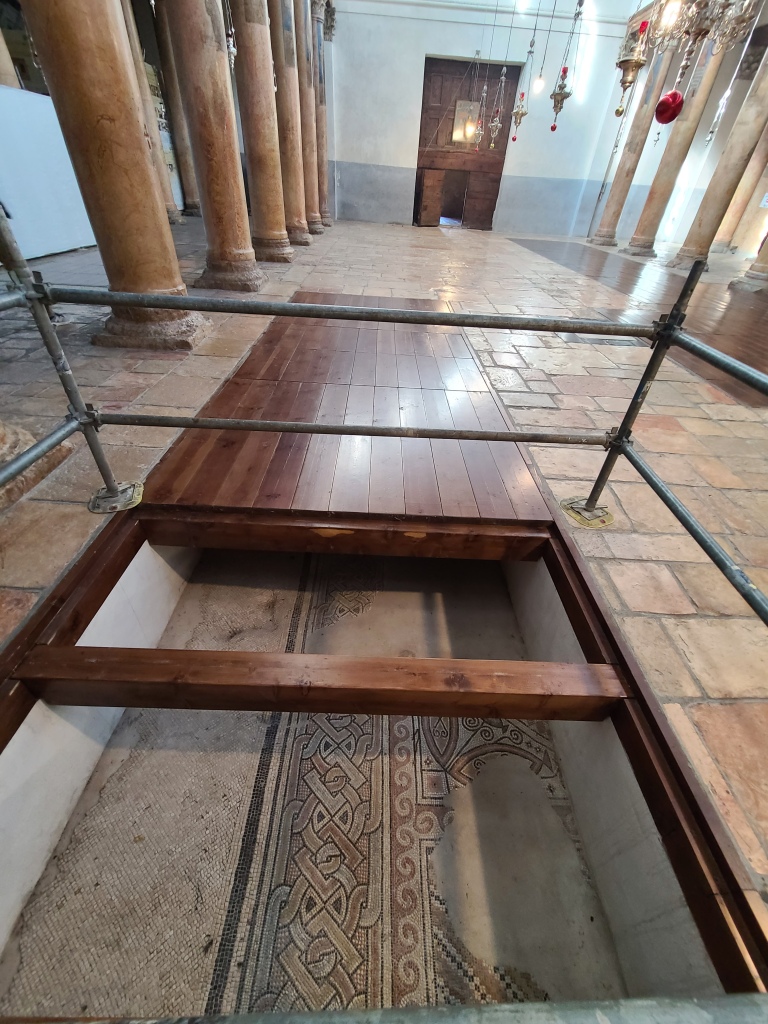
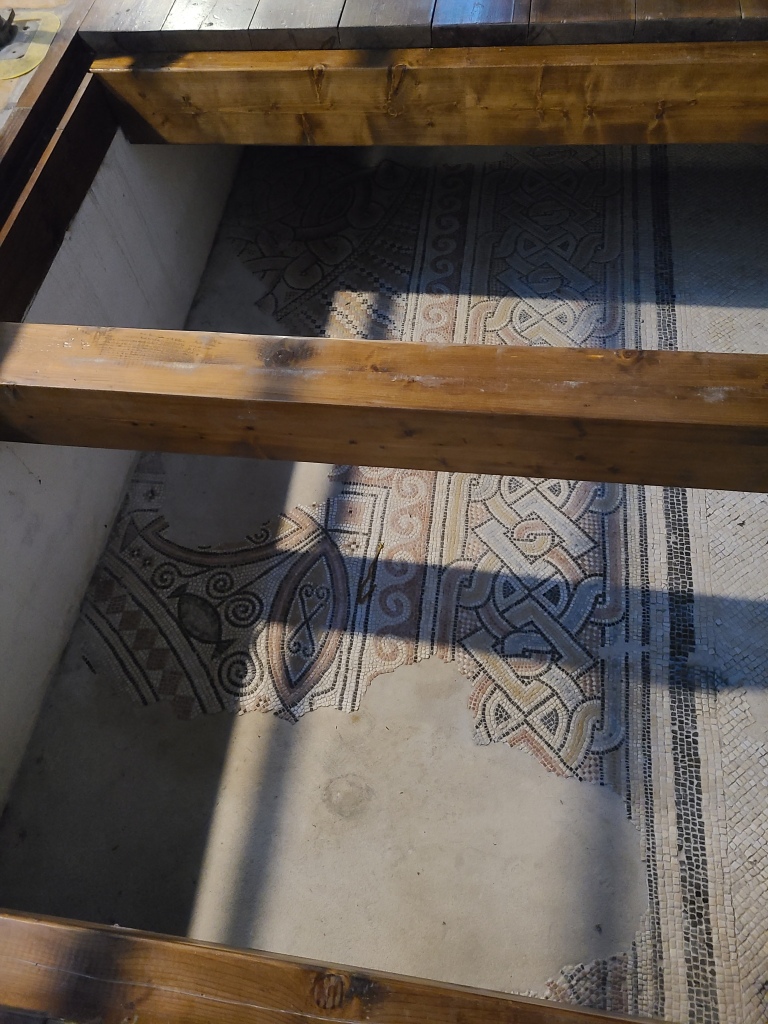
As I stood inside the Church of the Nativity, I was taken aback that I was standing where our Lord was born into the world. This was the place where Christmas *began*–where St. Joseph took Our Lady for shelter so she could have her Baby. I was also amazed to be the *only* person standing inside this ancient basilica–a stark contrast to the last time I had visited when I paid a guide to “skip the line” to get into the Cave of the Nativity, which lies under the front crossing of the church. These and many other thoughts flew through my mind as I stood in awe inside this holy place.
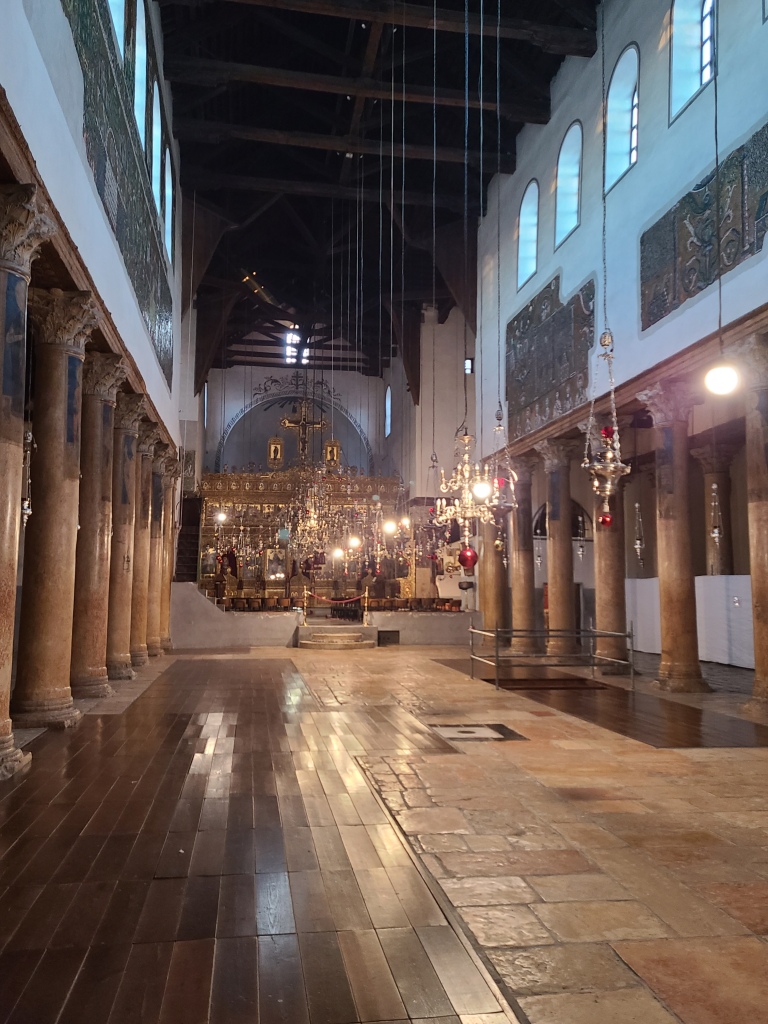
One of the things I love about the Church of the Nativity are the globe Christmas ornaments used to decorate the interior…it’s a nice touch! :)
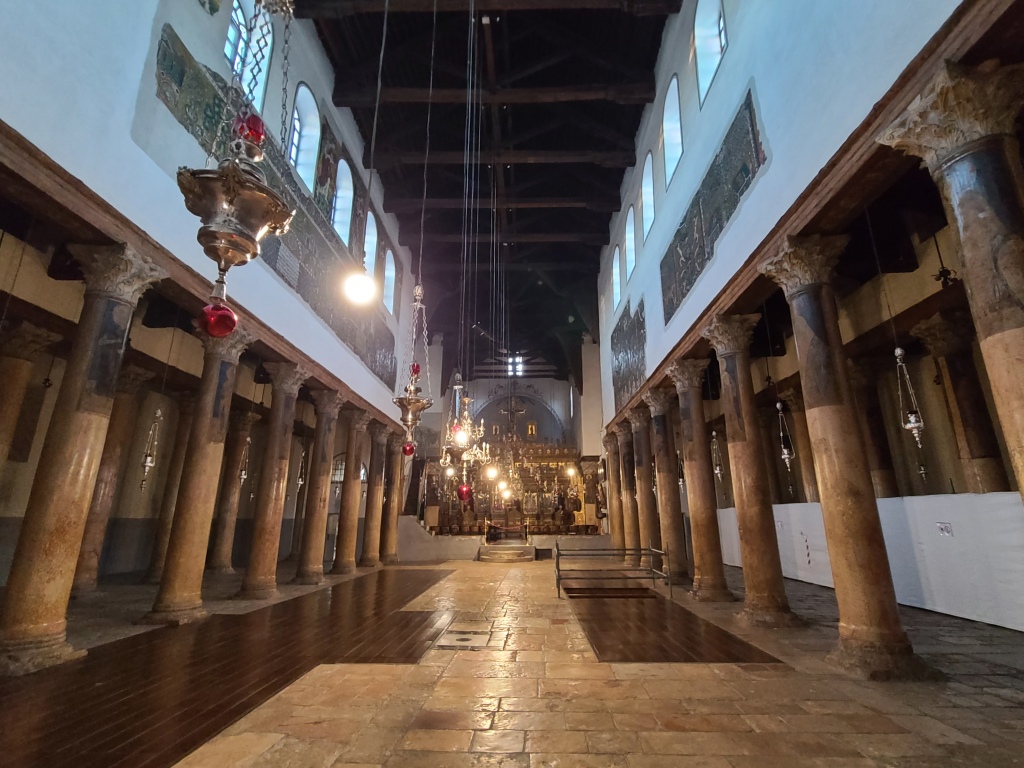
In the arcade above the pillars, glimmering mosaics (see photos below) from the 1100s were discovered by surprise by Italian restoration specialists working in the church in the 2010s. The angels are 8 feet tall!
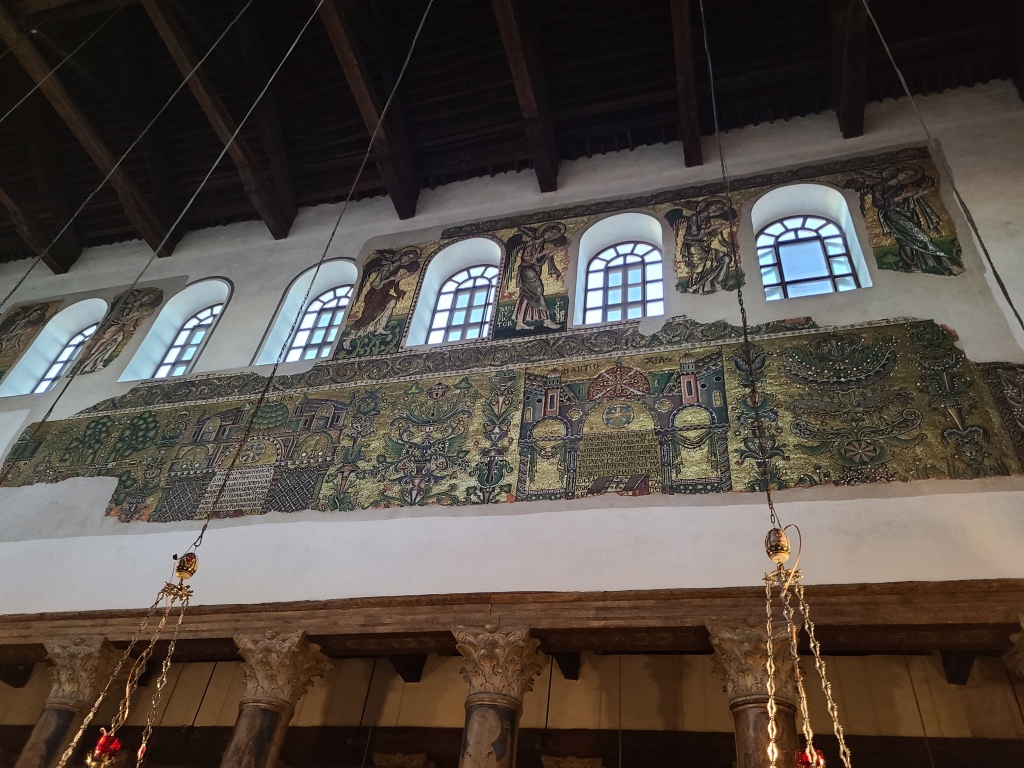
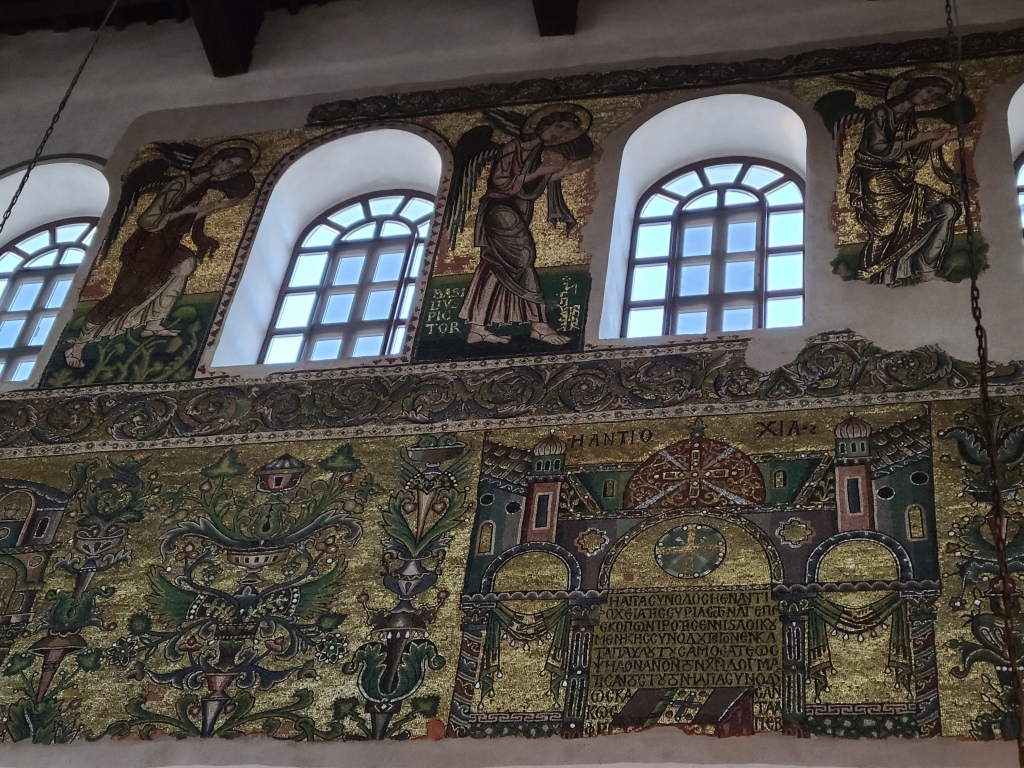
I slowly worked my way up to the front of the church and stepped onto the elevated sanctuary crossing of the church. The Cave of the Nativity was just below me. It was also in this approximate area the kings of the Crusader Kingdom of Jerusalem would have been crowned by the Latin (Catholic) Patriarch (bishop) of Jerusalem . The Church is currently shared by at least three denominations: Roman Catholics, Greek Orthodox, and Armenian Orthodox.
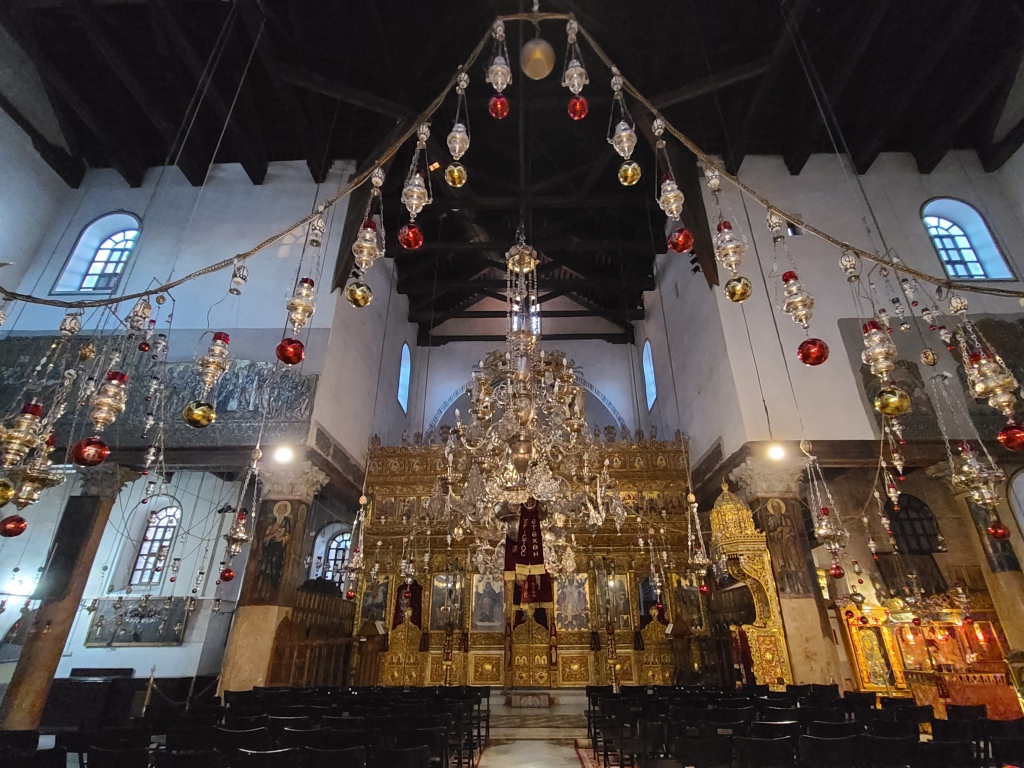
The views from this place looking towards the Greek Orthodox icon screen in front of the main altar (i.e. the iconostasis) were simply breathtaking…
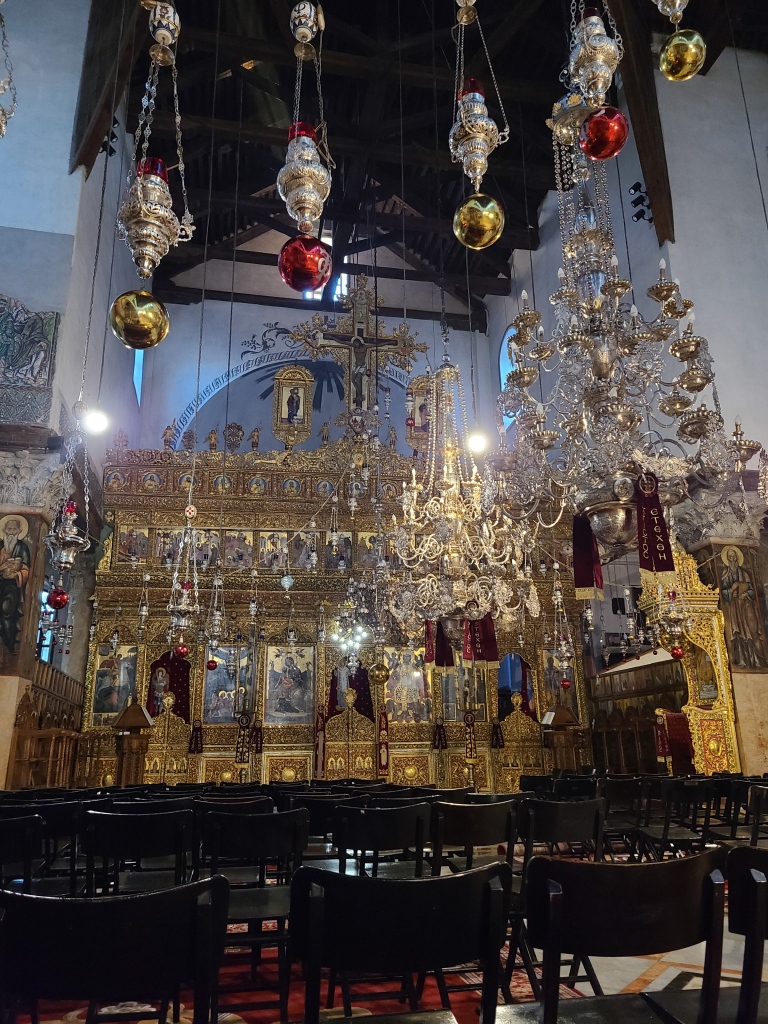
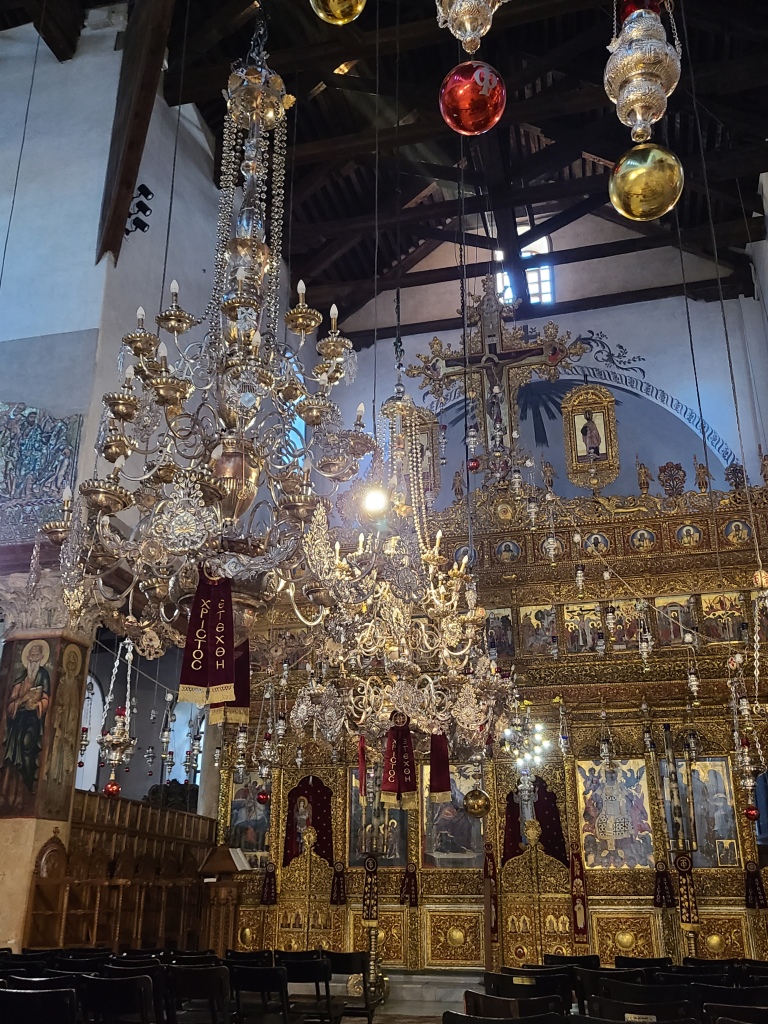
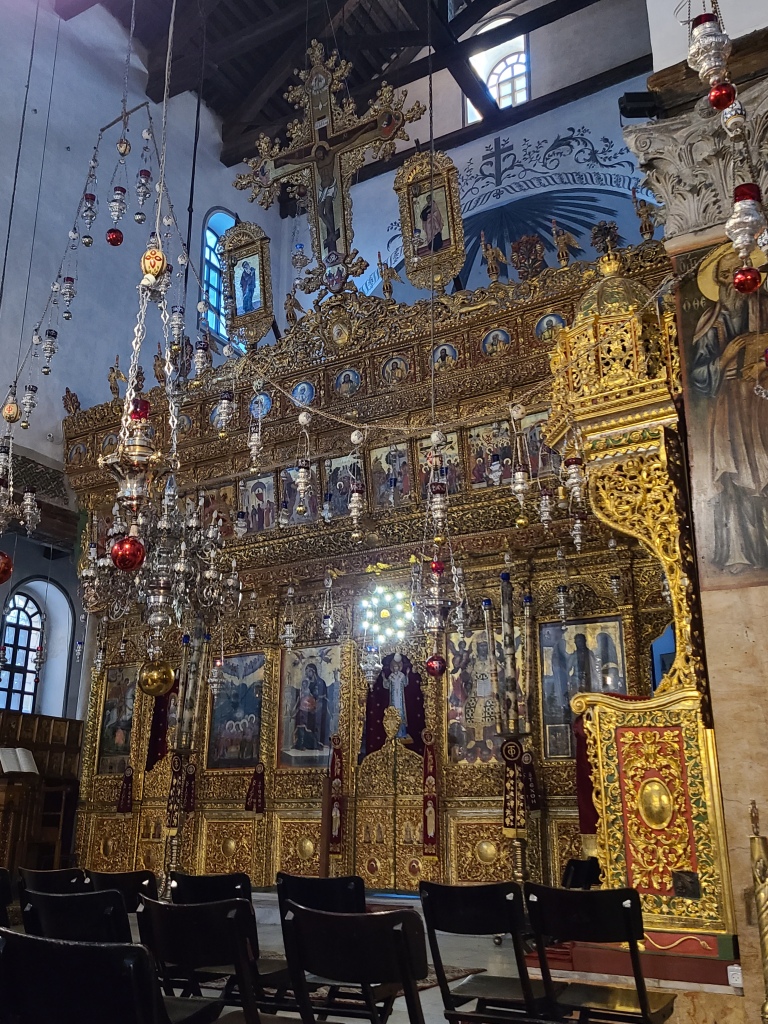
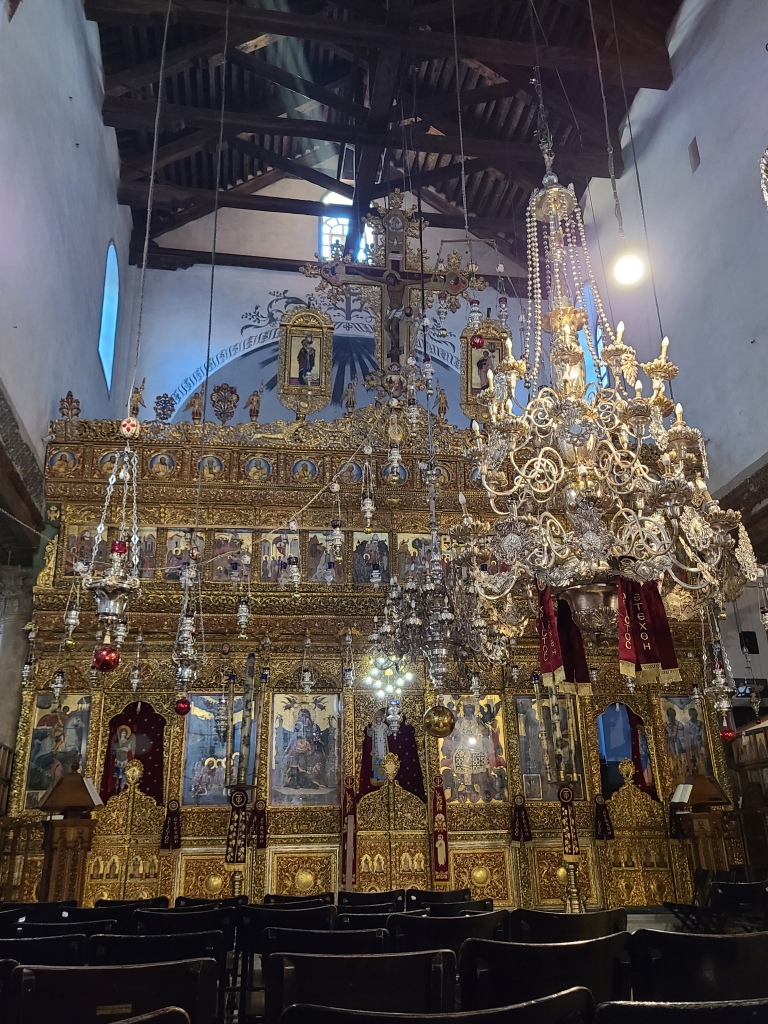
The iconostasis is incredible–it is intricately crafted and covered in scenes from the life of Our Lord and pictures of the Saints.
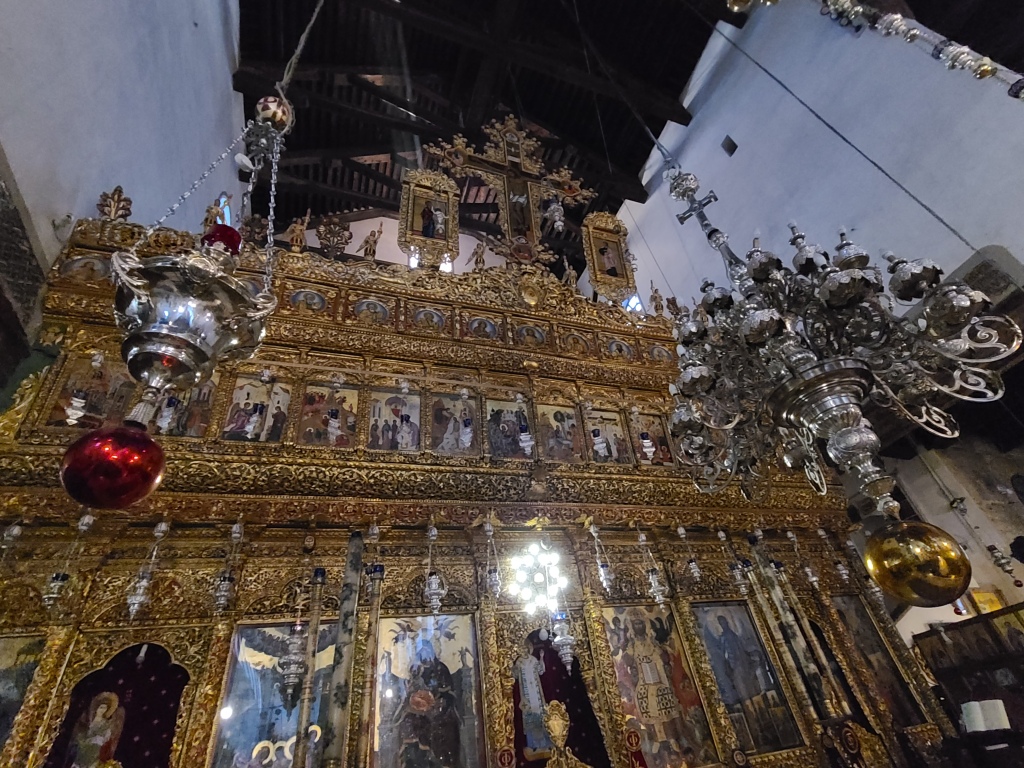
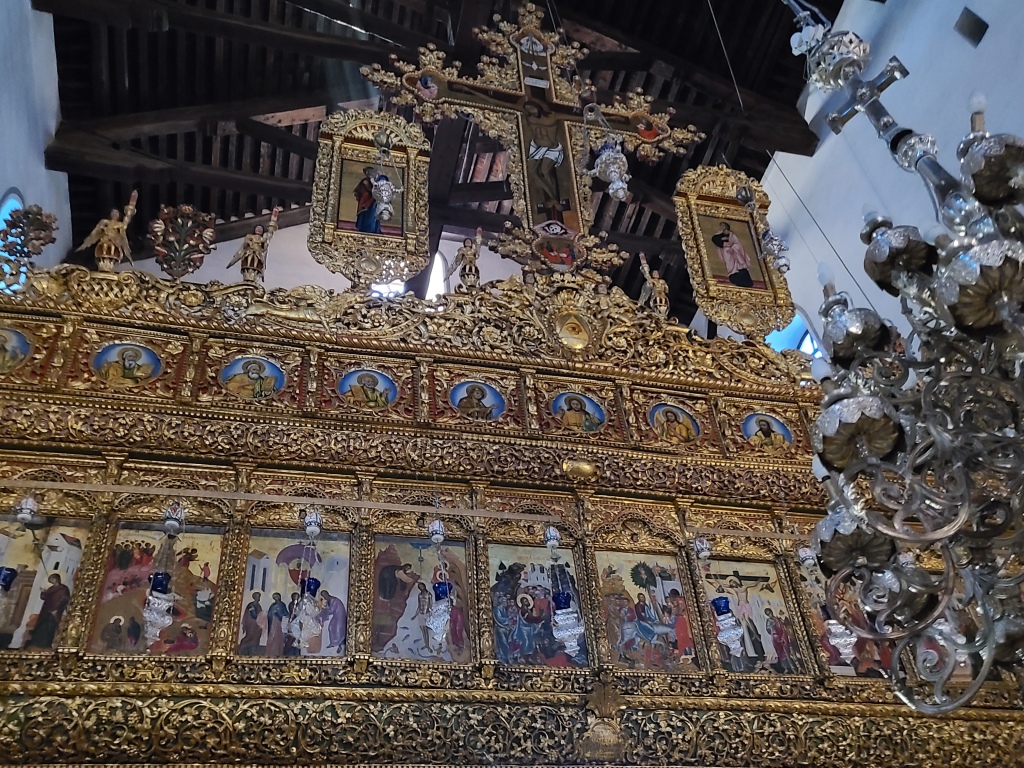
Below is the priest’s door into what’s known in Eastern churches as the “High Place” behind the iconostasis that contains the altar where the Sacrifice of the Divine Liturgy (i.e. Holy Mass) happens.

To the right of the doorway is an icon of Christ triumphant, shown as High Priest (wearing priestly vestments), and shown as King (wearing a crown). (Notice the exceptional, golden ornamental moulding surrounding the icon and covering the iconostasis!)
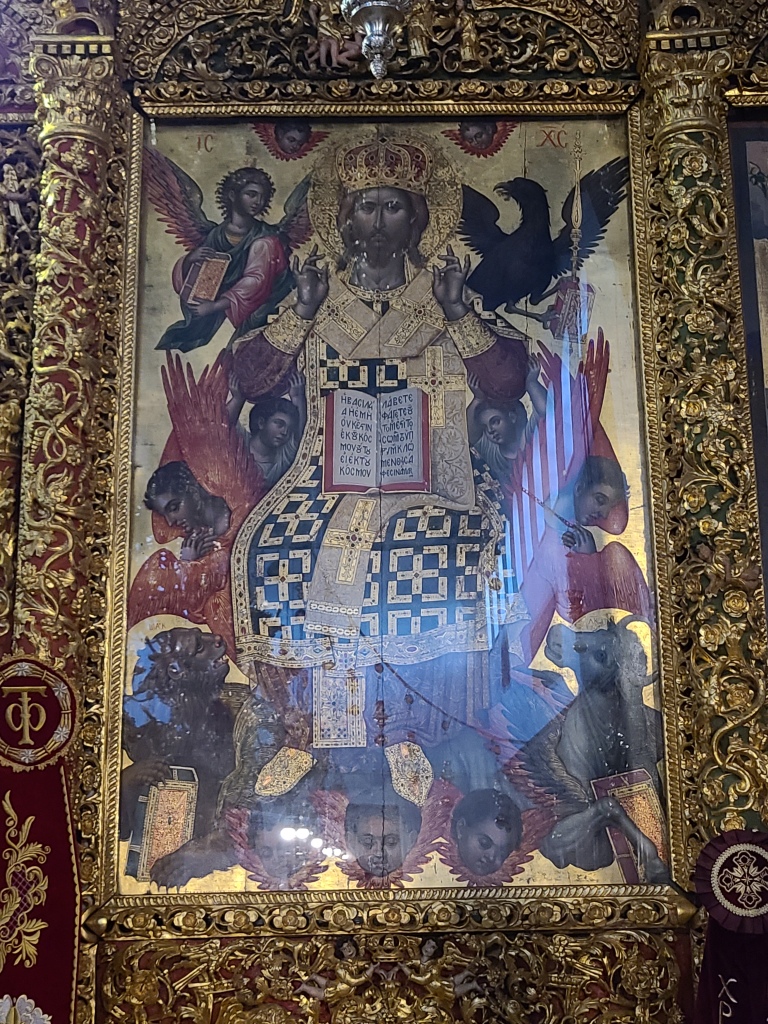
To the left of the doorway is a beautiful icon of Our Lady enthroned holding Baby Jesus.
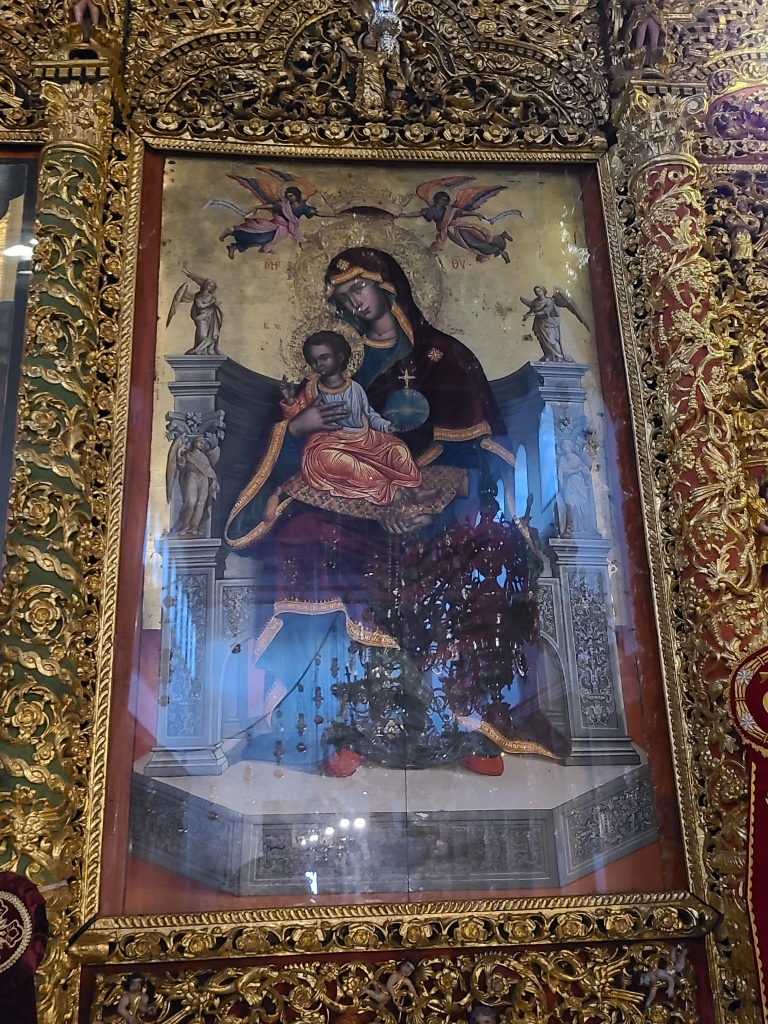
An icon of the Nativity on the iconostasis:
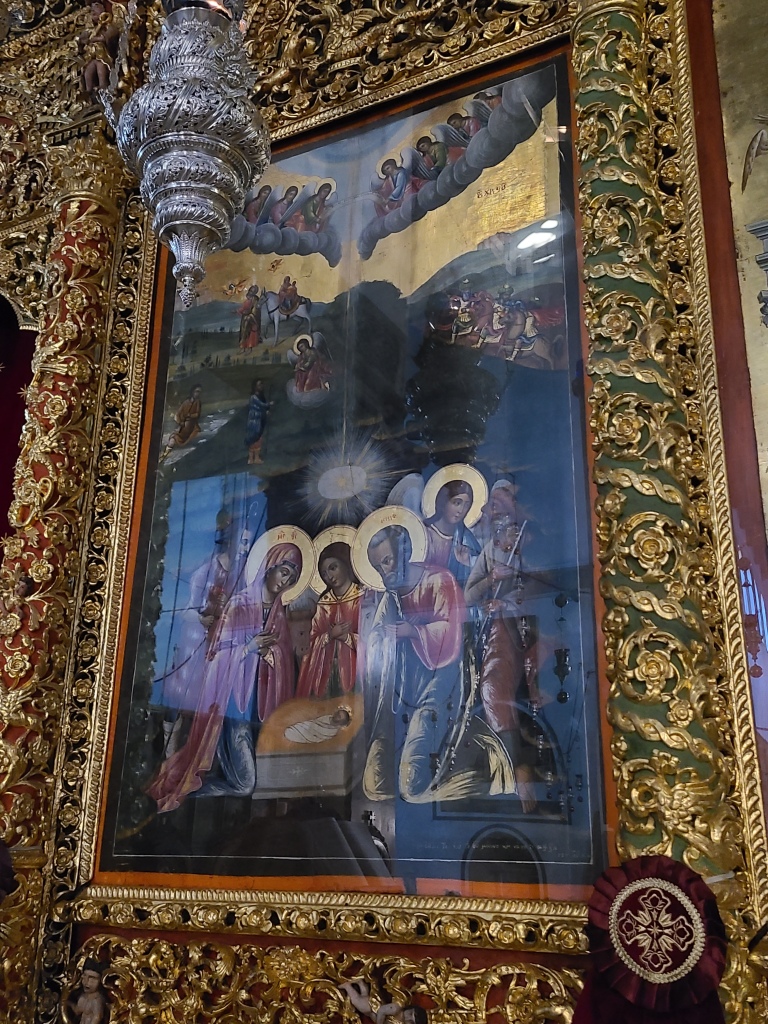
After seeing the iconostasis, I looked at some of the side altars and other sacred artwork throughout the church. Below is an icon of the Nativity created through weaving mostly golden and silver thread.

I even found an icon of St. Nicholas towards the front of the church! Very appropriate to have an icon of Santa in the Church of the Nativity!
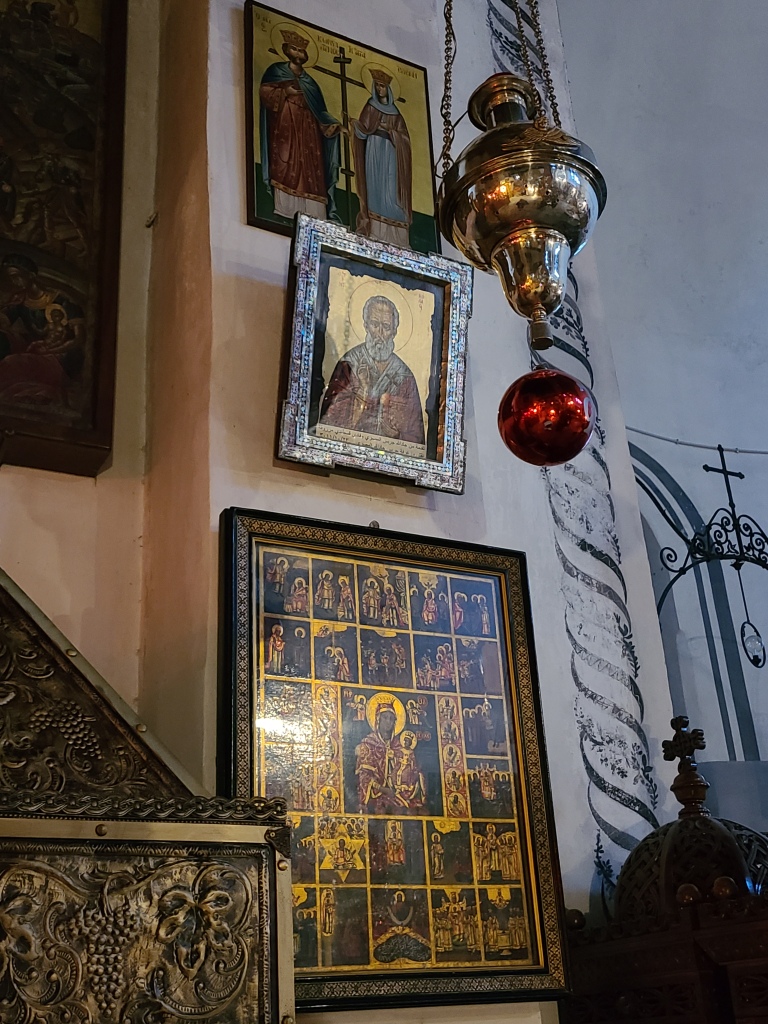
A picture of Our Lady holding Baby Jesus:
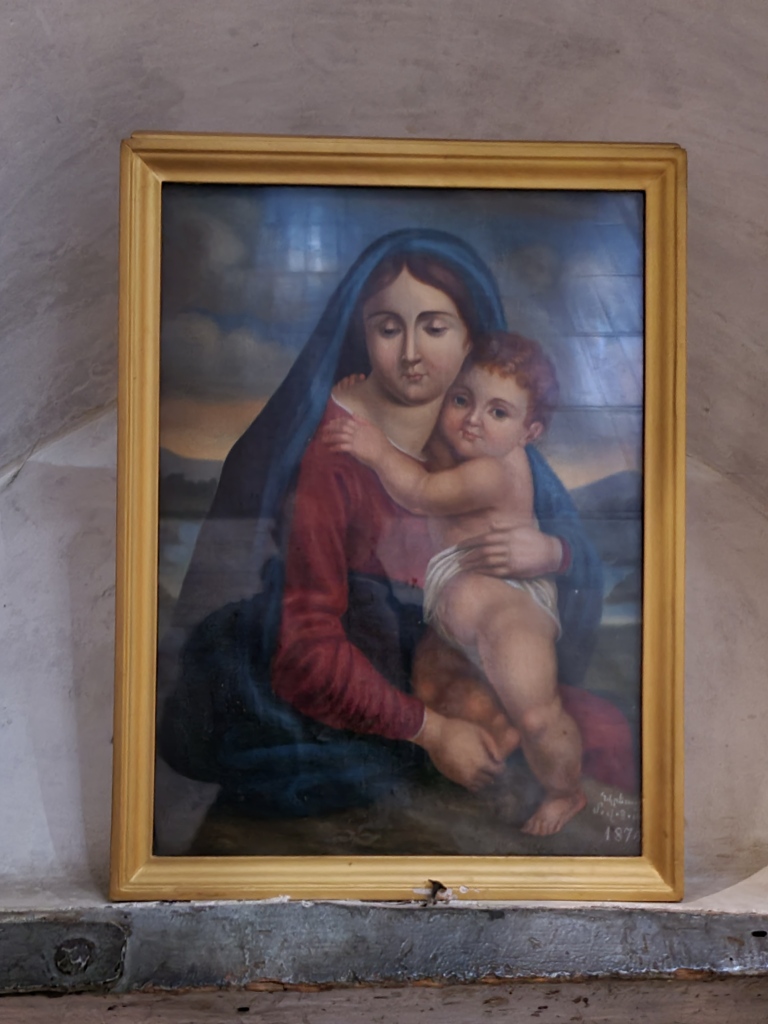
As I looked at some of the artwork on the southern side of the church, my eyes fell upon one of the two small entrances, on either side of the sanctuary, that led into the Cave of the Nativity! (see photo below) This is the traditional place where Our Lord was born. The earliest extra-biblical source to mention this place is St. Justin Martyr who wrote around A.D. 155 – 170. In his Dialogue with Trypho, Chapter LXXVIII, Justin states: ”But when the Child was born in Bethlehem, since Joseph could not find a lodging in that village, he took up his quarters in a certain cave near the village; and while they were there Mary brought forth the Christ and placed Him in a manger, and here the Magi who came from Arabia found Him.” (Note: St. Justin’s statement can be seen to corroborate what I discussed earlier–that the Cave was on the edge or outskirts of the town of Bethlehem in the 1st Century.)
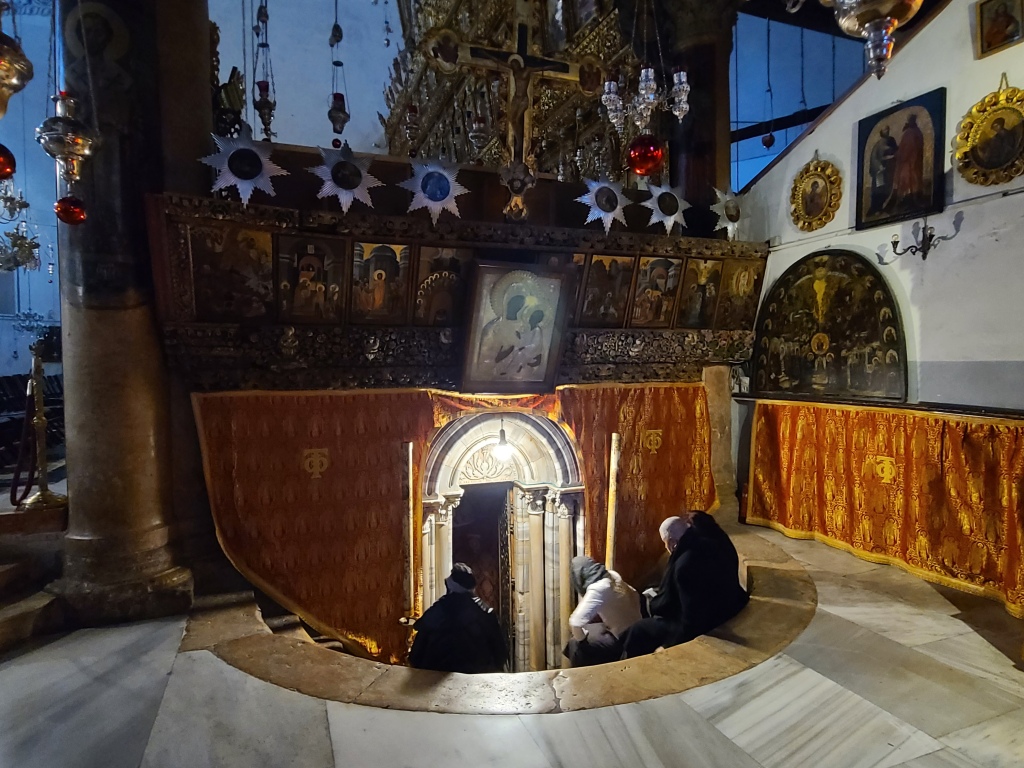
Therefore, the more historically accurate depictions of the Nativity show the birth as happening in a cave (used for holding livestock and/or beasts of burden). These depictions are especially common in Eastern Christian art, as shown in the icon of the Nativity below:
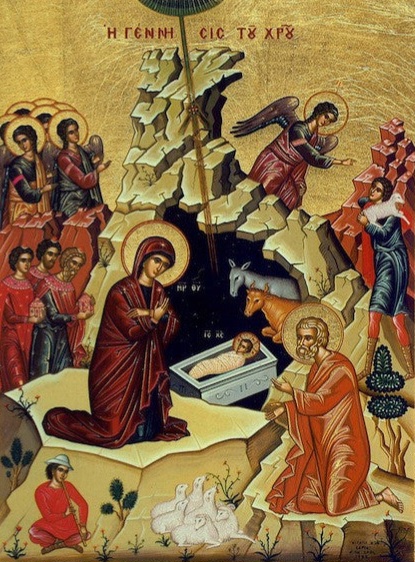
Depictions of the Nativity taking place in an outdoor barn like the picture below are therefore not how it would have actually been.
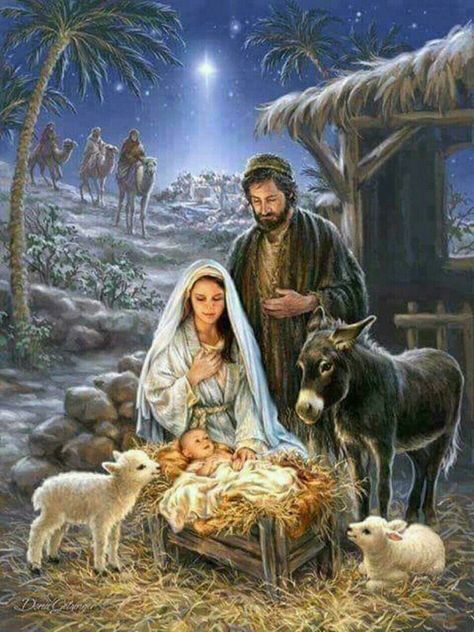
I sat down outside the entrance to the cave along with a few Palestinian Orthodox Christians who were attendants for the Greek Orthodox Divine Liturgy that was going on inside the Cave of the Nativity. Although we could not easily see into the cave, we could hear the Greek Orthodox clergy mesmerizingly chanting their liturgy. It was very beautiful.
I metitated on where I was. I felt like one of the Shepherds waiting their turn to see the Lord.
After a while, I noticed it was starting to get close to 7:30 AM. I walked to the other entrance to the cave to see if other Catholics had begun assembling to go into the cave.

This morning, my plan was not only to trace the steps of the Shepherds from their field up to the Cave of the Nativity, but I also intended to physically see, hold, and adore Our Lord as they did: I planned to attend Holy Mass at 7:30 AM inside the Cave of the Nativity!
I sat down on the steps leading down to the other entrance into the Cave of the Nativity and was joined by a few other Catholics. One of the men appeared to be one of the officials of the Church of the Nativity assigned to make sure services occurred on schedule. The Greek Orthodox Divine Liturgy ran a bit over time, but we were soon able to enter once most of the Orthodox attendees had departed the cave.
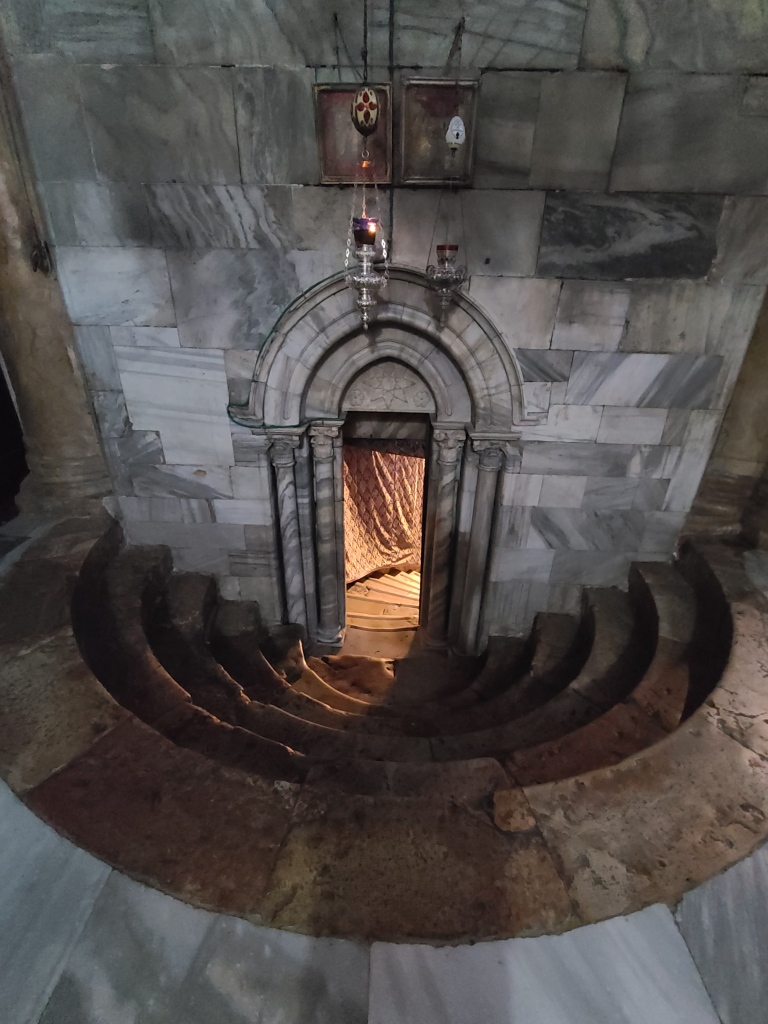
I began to walk down into the holy cave…
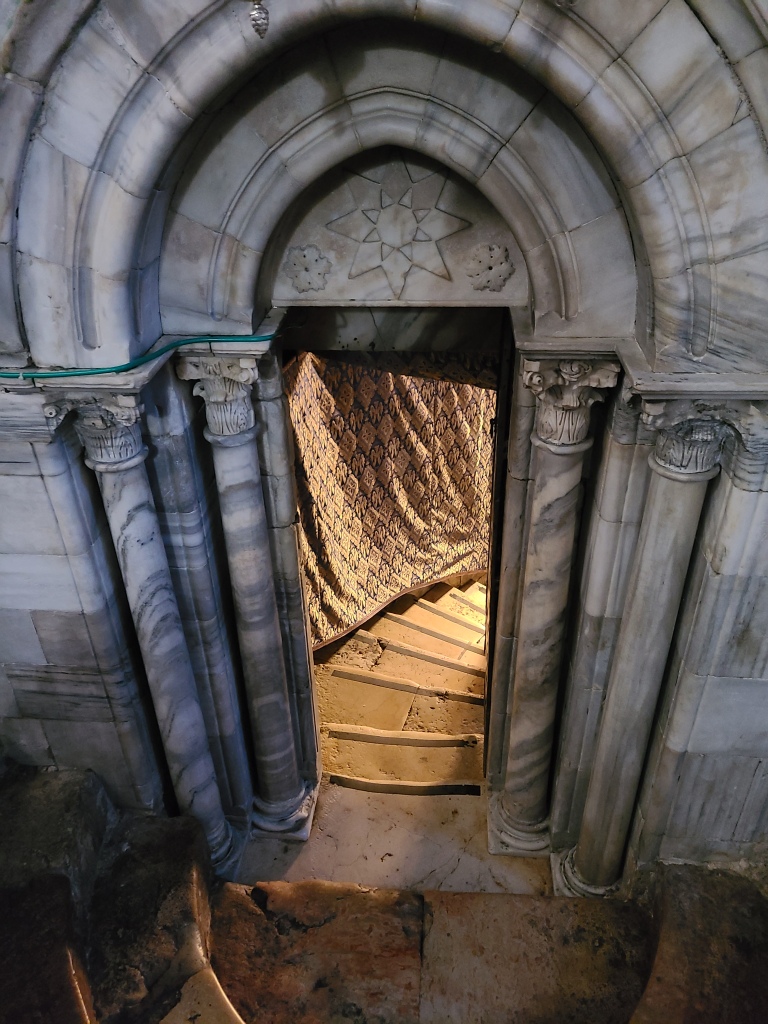
Here it was!
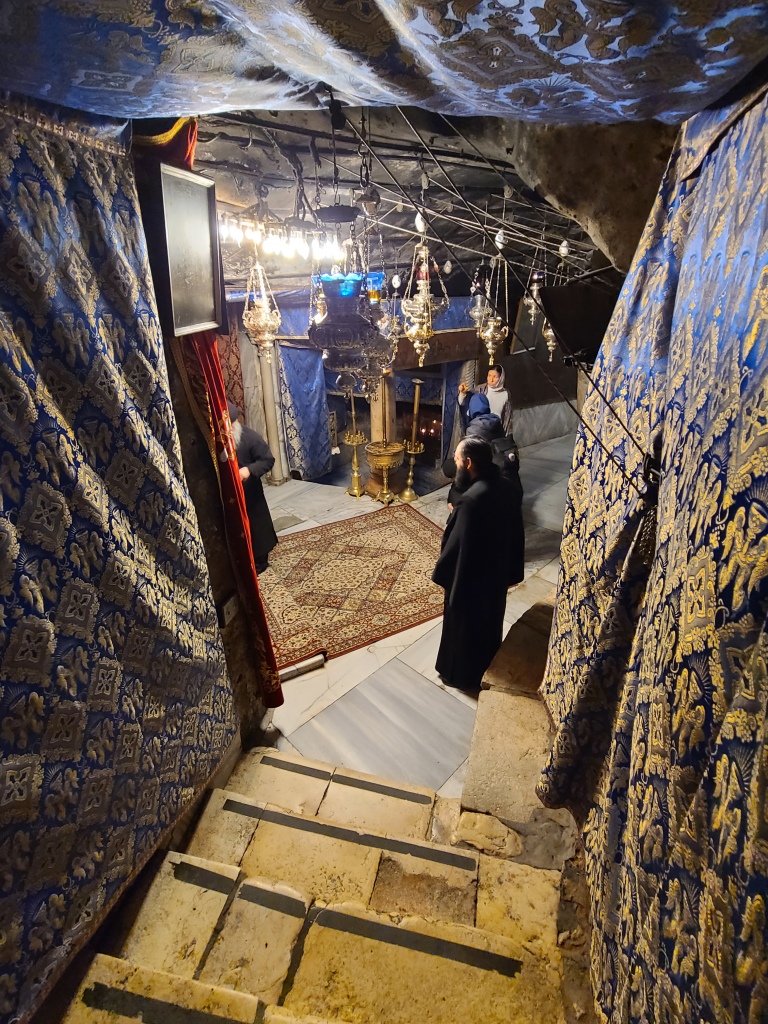
Immediately to my left after coming down the stairs was the exact location of Our Lord Jesus’s birth inside the Cave of the Nativity! (see photo below)
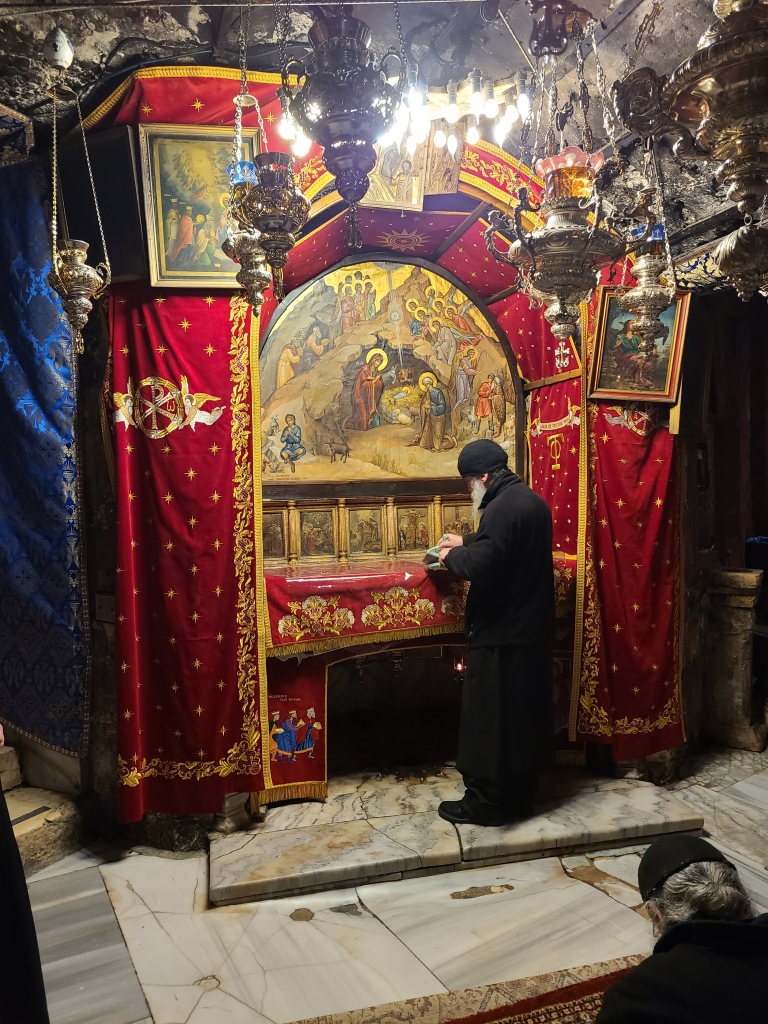
The Greek Orthodox priests were still putting away their liturgical items, and it gave me a great opportunity to meditate on where I was standing and what I was about to participate in. I was reminded of the exceptional watercolor paintings of James Tissot–a Catholic French artist who in the late 1800s painted hundreds of individual watercolor paintings of events from the Gospels with keen archaeological insight of the holy places and exceptional realism. His paintings of the Nativity events are especially vivid and mirror what the Cave of the Nativity may have actually looked like when Jesus was born (notice in the images below the flights of carved stone stairs on either side of where the Lord was born–this is how the cave looks today as well). I meditated on these images…closing my eyes and opening them again as I stood in the exact locations as the perspectives in the paintings.
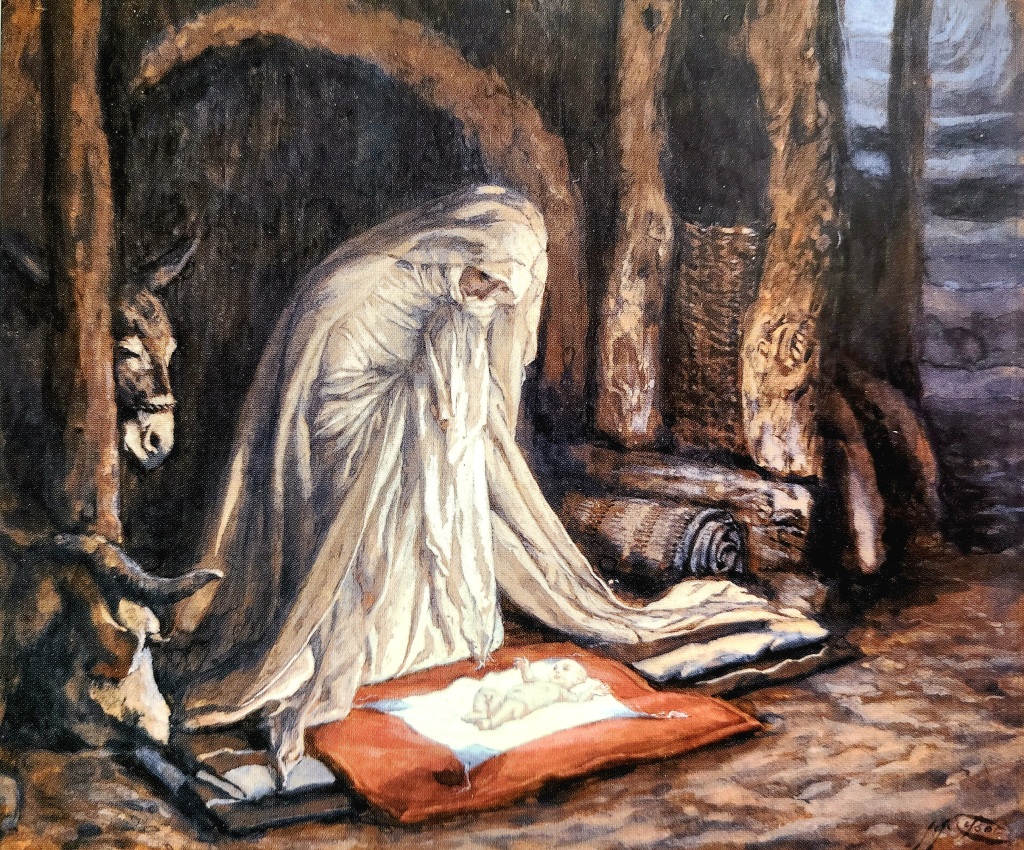
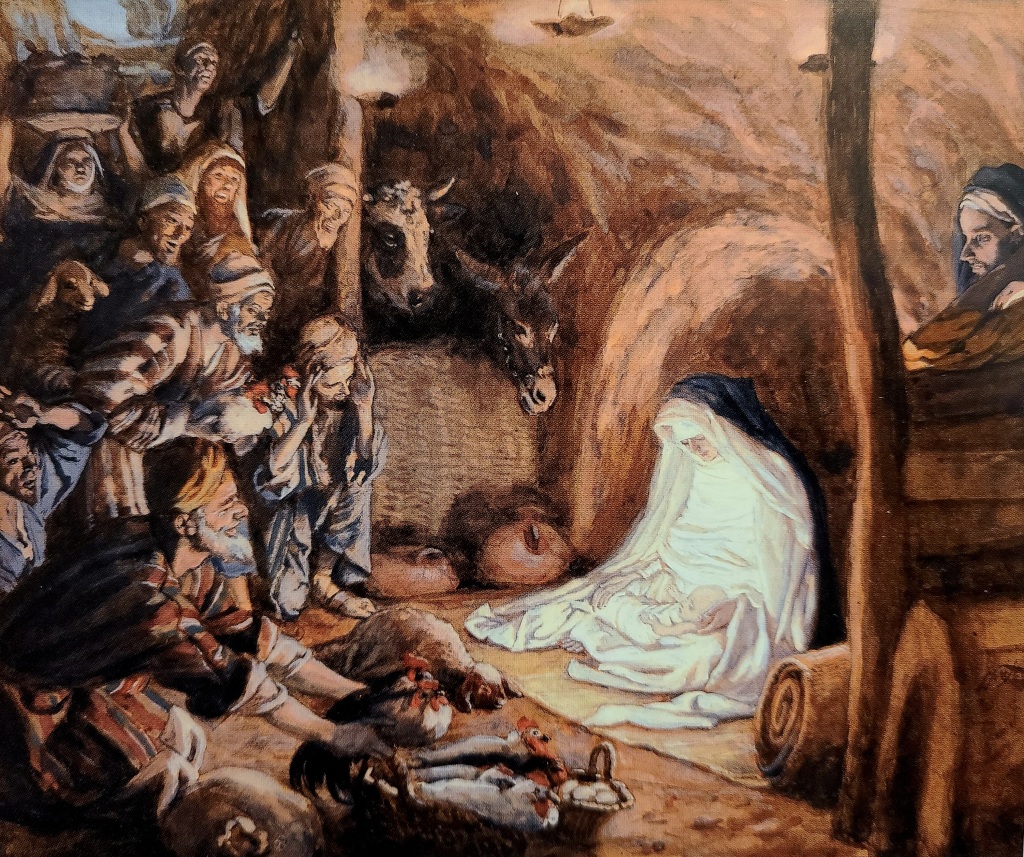
As I took in the cave, I was careful to look for traces of the cave’s natural stone (see photos below). It was these stone walls–silent witnesses–who “heard” the sounds of Our Lady giving birth and the soft cry of our infant Lord as He was born into our world.
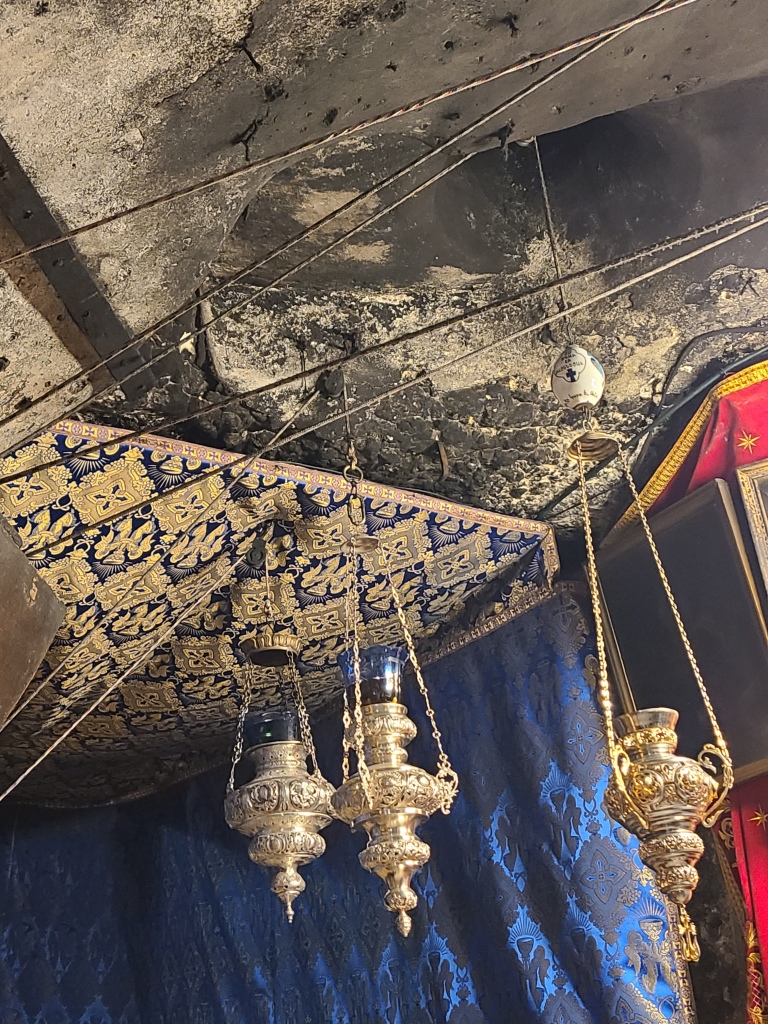
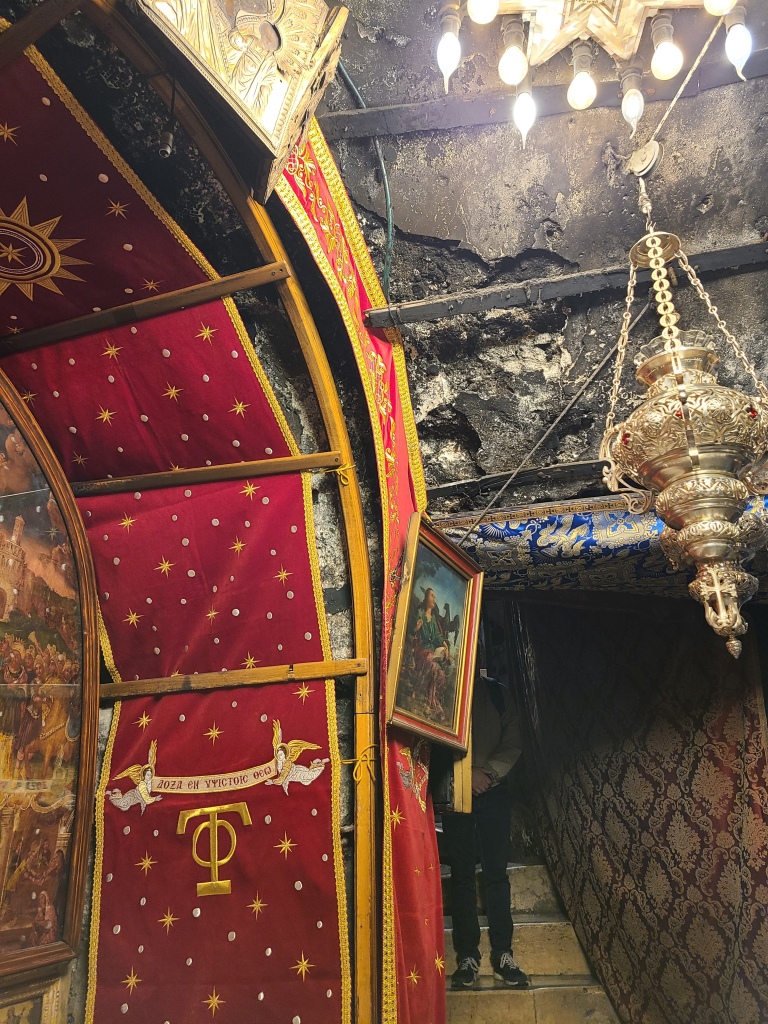
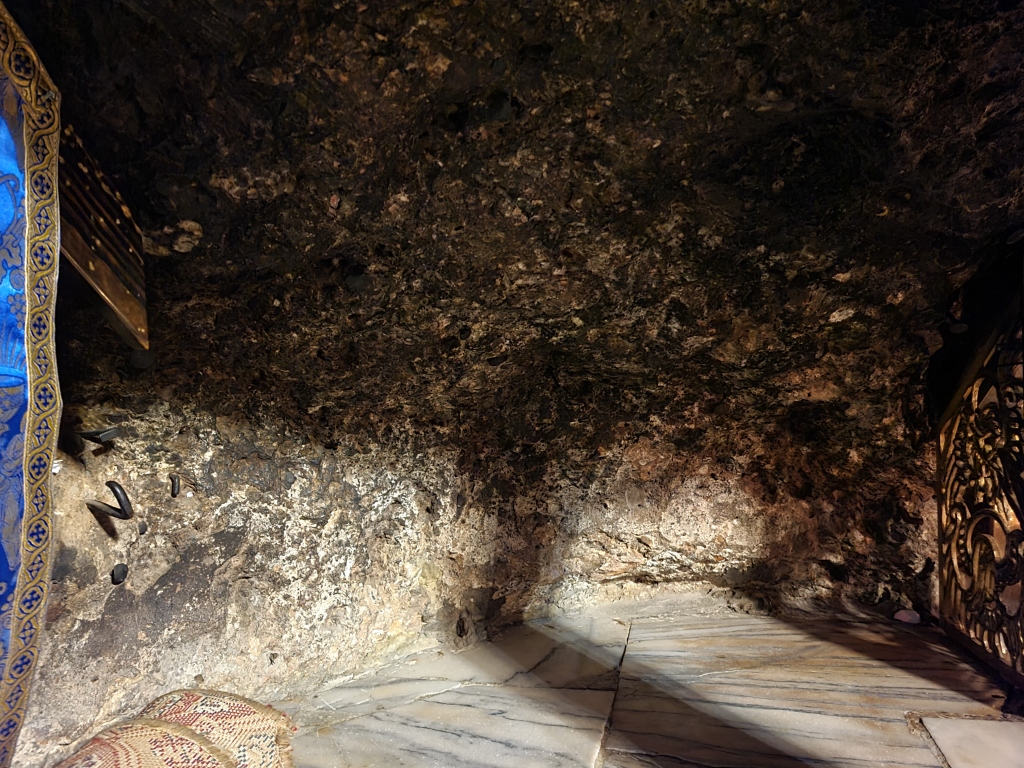
After the Greek Orthodox clergy left the cave, my attention focused on the place of Christ’s birth, marked by a silver star on the floor of the cave. It was here the Everlasting Light entered the world! What joy!
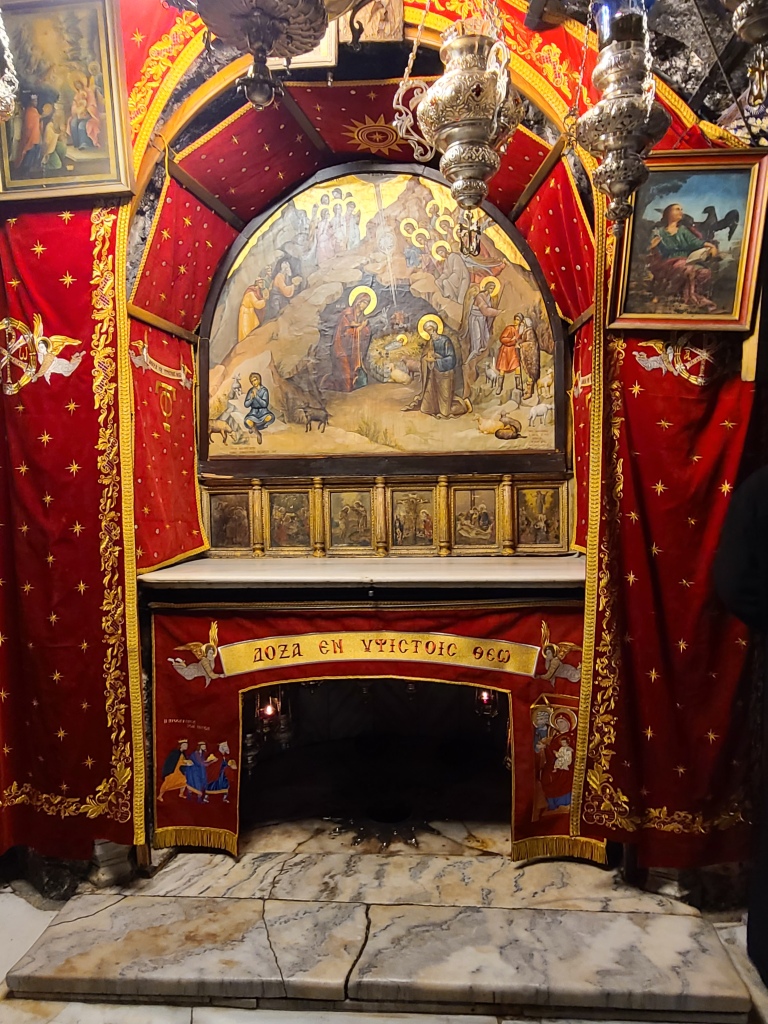
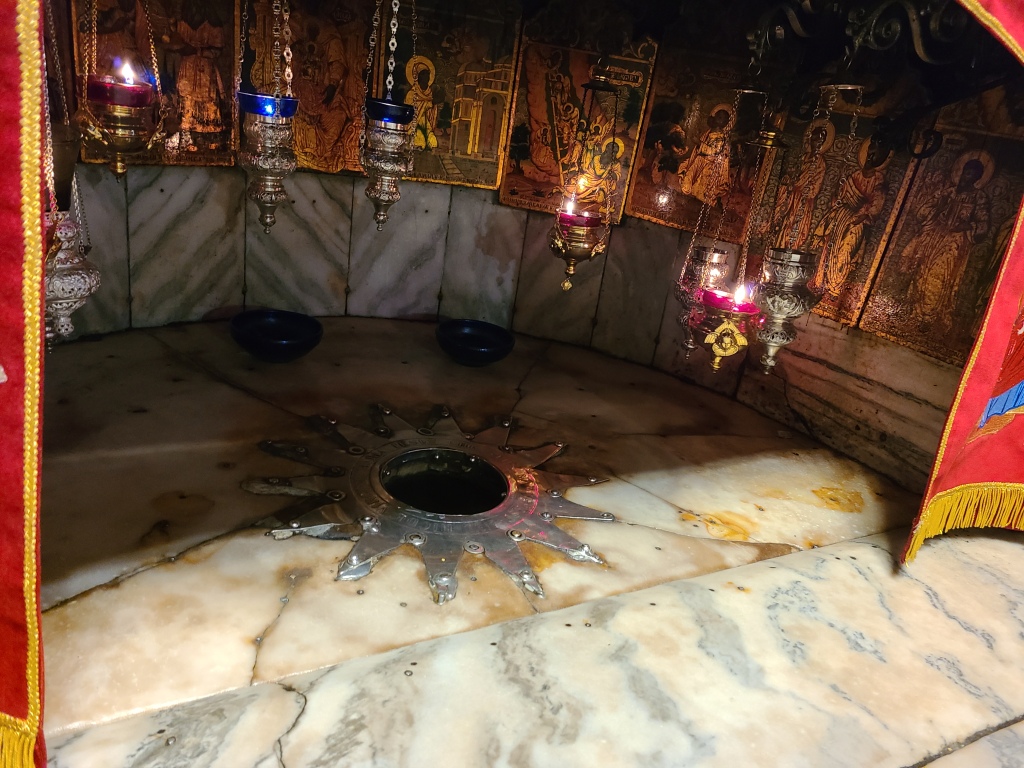
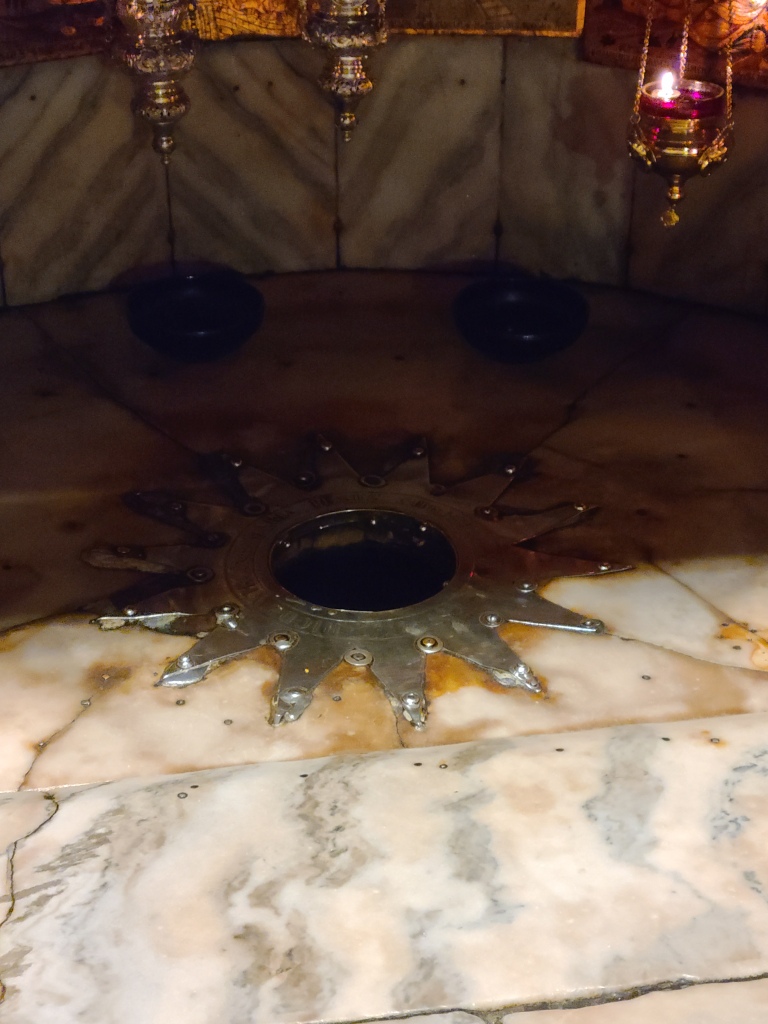
Other Catholics started to assemble inside the small cave for Mass. The photo below shows the back of the Cave of the Nativity, directly opposite Christ’s birth spot. The cave’s ceiling appears to be covered with a kind of mortar which covers most of any natural stone.
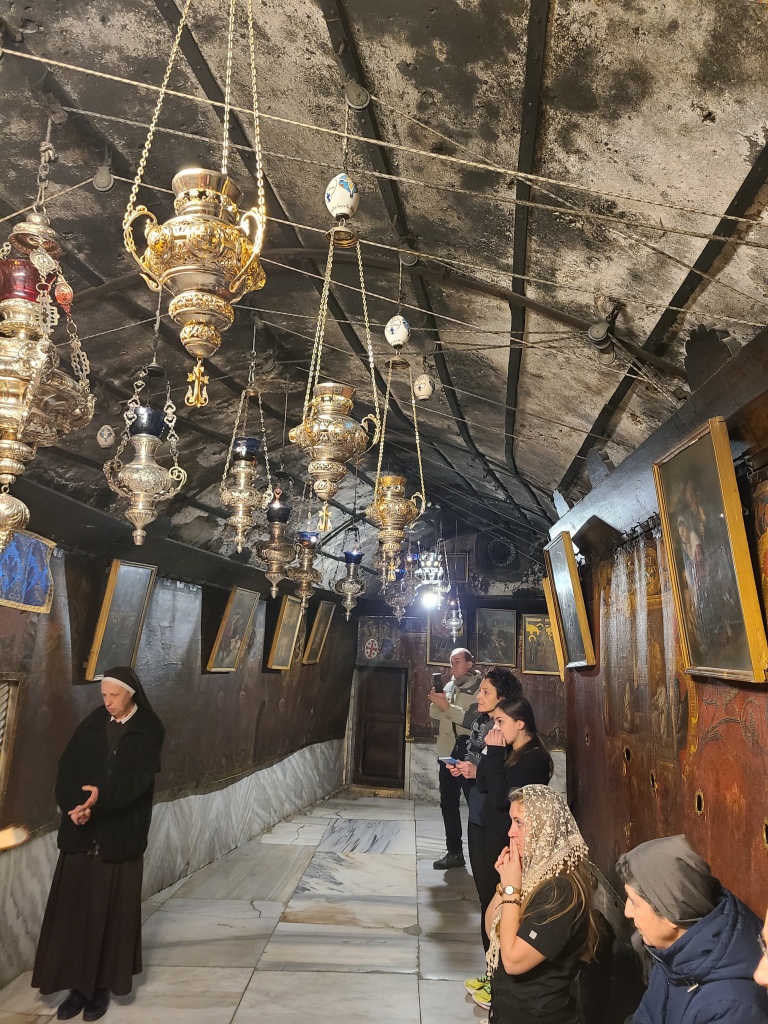
When facing the back of the cave, immediately to my left was another section slightly lower than the primary level. This area was the site of the stone manger cut into the wall of the cave where our infant Lord was placed. The natural stone of the place of the manger has been covered with marble.
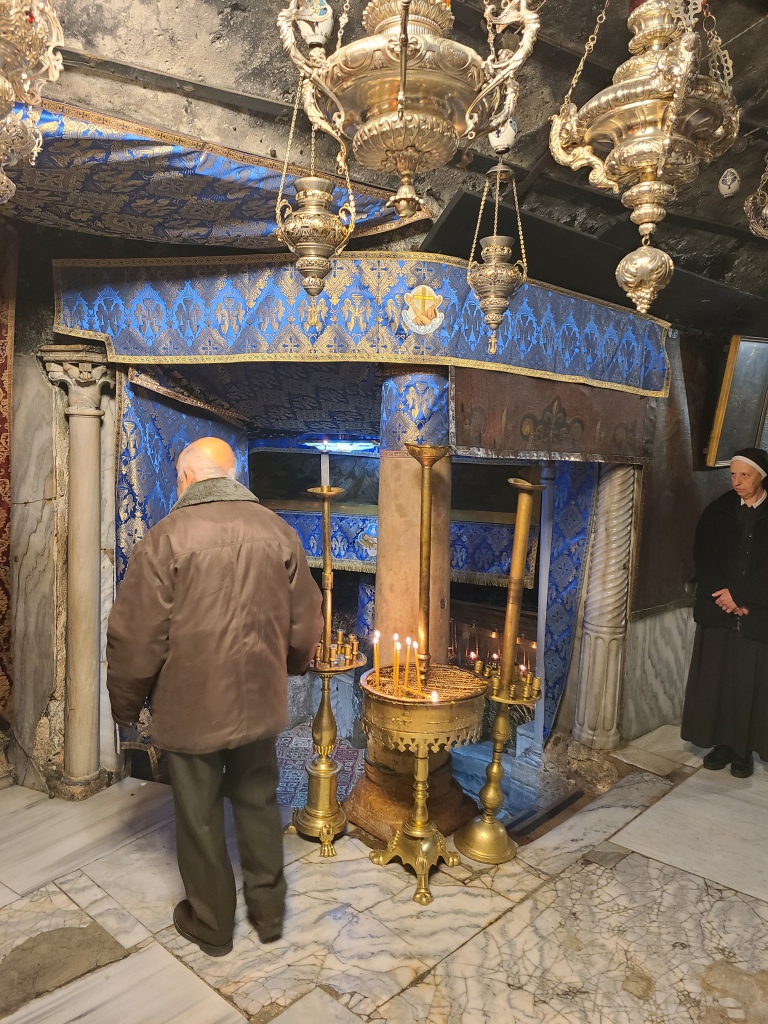
Inside the “subcavern” of the Manger (see photo below). Our Lord’s lowly manger stood where the glowing lamps and candle are burning in this picture. The Roman Catholic Altar of the Magi in the cave is on the left side of the subcavern. It would be this altar where the priest would say Mass for us.
I can just imagine this small area filled with hay and resting farm animals, next to their manger. Amazing.
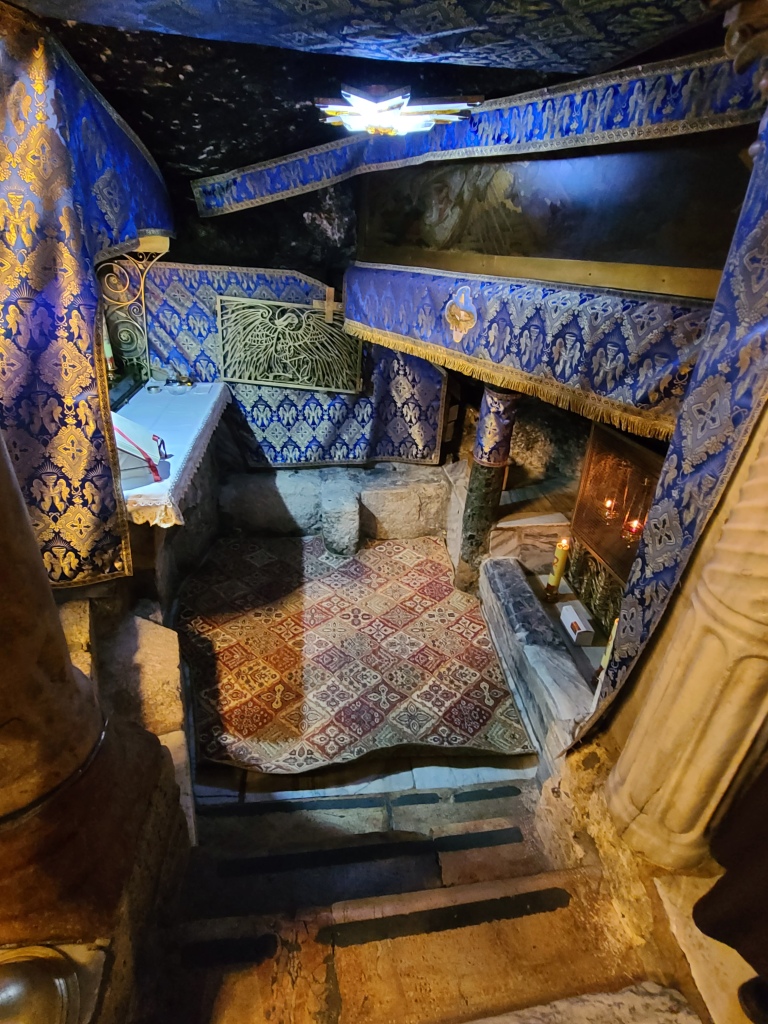
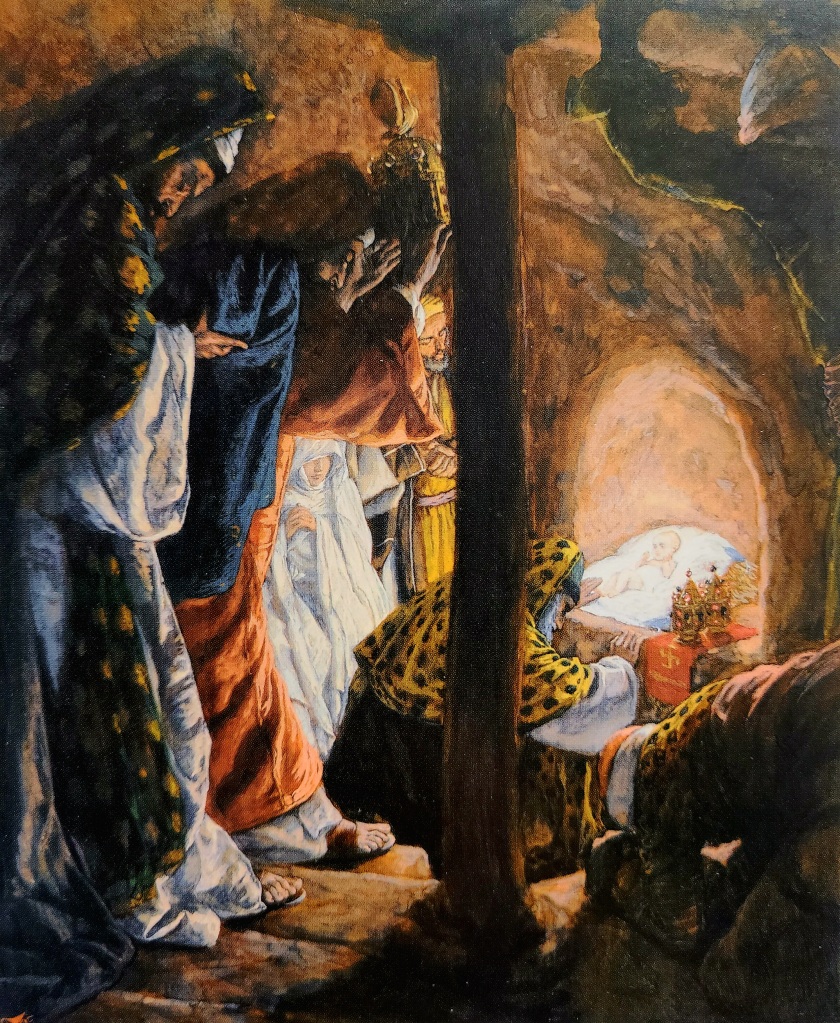
Below is a 360 degree panorama picture of the inside of the Cave of the Nativity.

The priest saying Mass soon processed in and Holy Mass began! I was excited to have the opportunity to adore our Lord in the place of His birth. I treasured every moment.
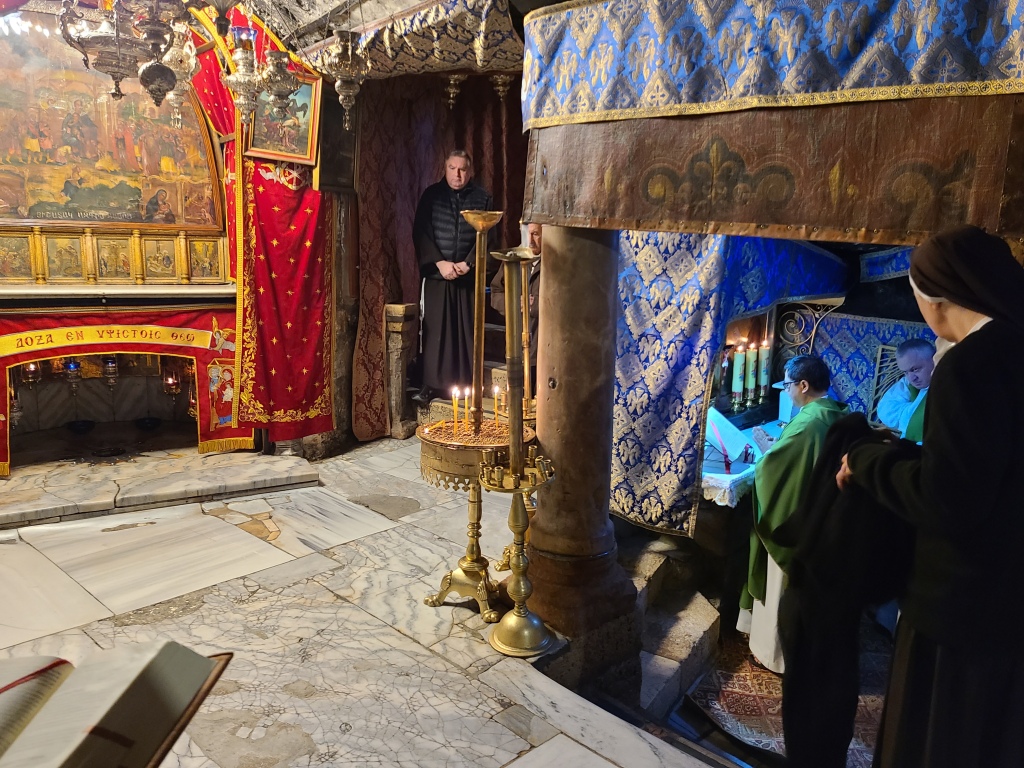
I remember the crucial moment when the priest said the Words of Consecration and the Holy Spirit sublimely transformed the bread into Our Lord’s Body. I, Dan Beaudoin, was now standing in the Cave of the Nativity physically next to Our Lord Jesus Christ, able to now adore Him in the same place and same way as the Shepherds, the Magi, St. Joseph, and Our Lady! The moment was simply divine. Thank you, Lord!
The priest held Our Eucharistic Lord aloft for all present to adore Him (see below):
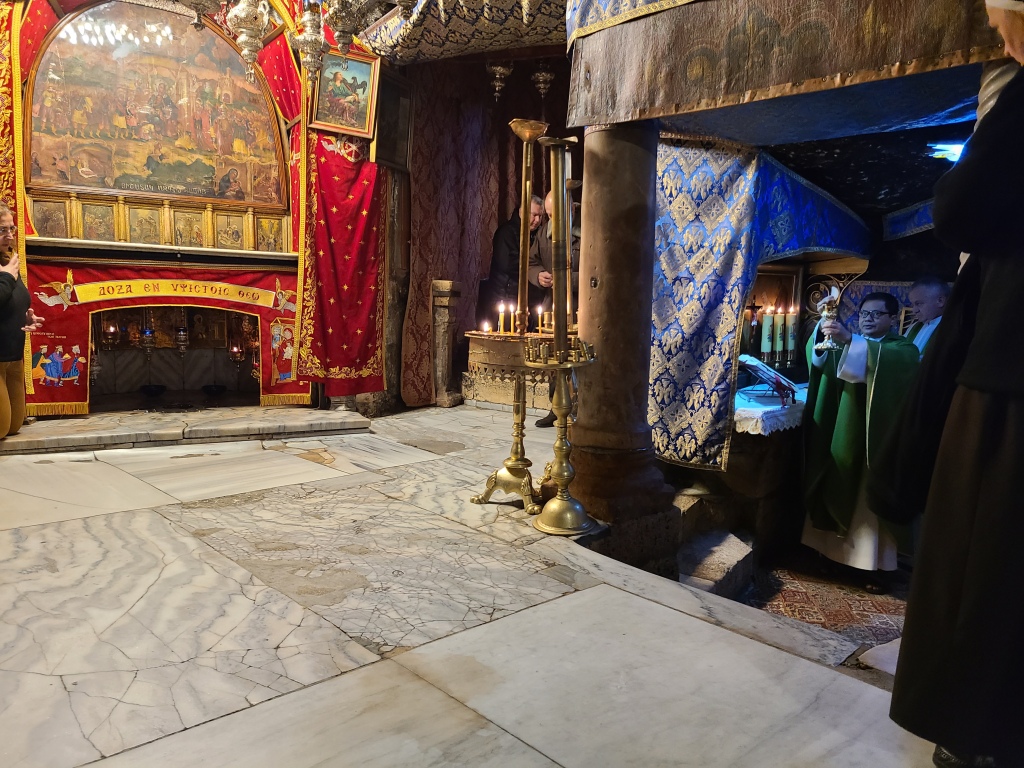
It was soon time to process forward to receive Communion. My pilgrim journey over the last 12 hours or so–flying across the Mediterranean World, driving to the West Bank, walking miles in the dark, downhill and uphill–had reached its zenith. I was given the Consecrated Host by the priest–an inexplicable honor in and of itself, but the Lord was also giving me the honor to physically *hold* Him as Our Lady did in the place of His birth. Hallelujah! Thank you, Lord! It was a moment I will cherish forever.
Mass eventually ended and those who had attended Mass were given the opportunity to look around the cave and pray before set up began for the Armenians to do their liturgy next.
I went down into the subcavern to take a closer look at the place of Christ’s manger.
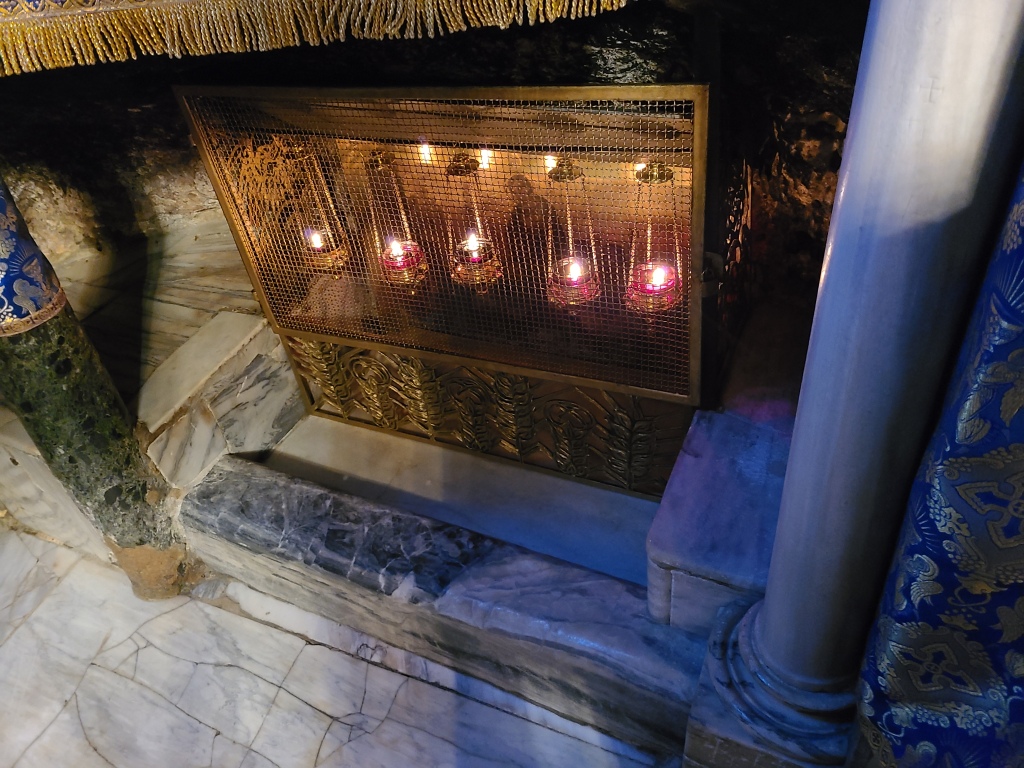
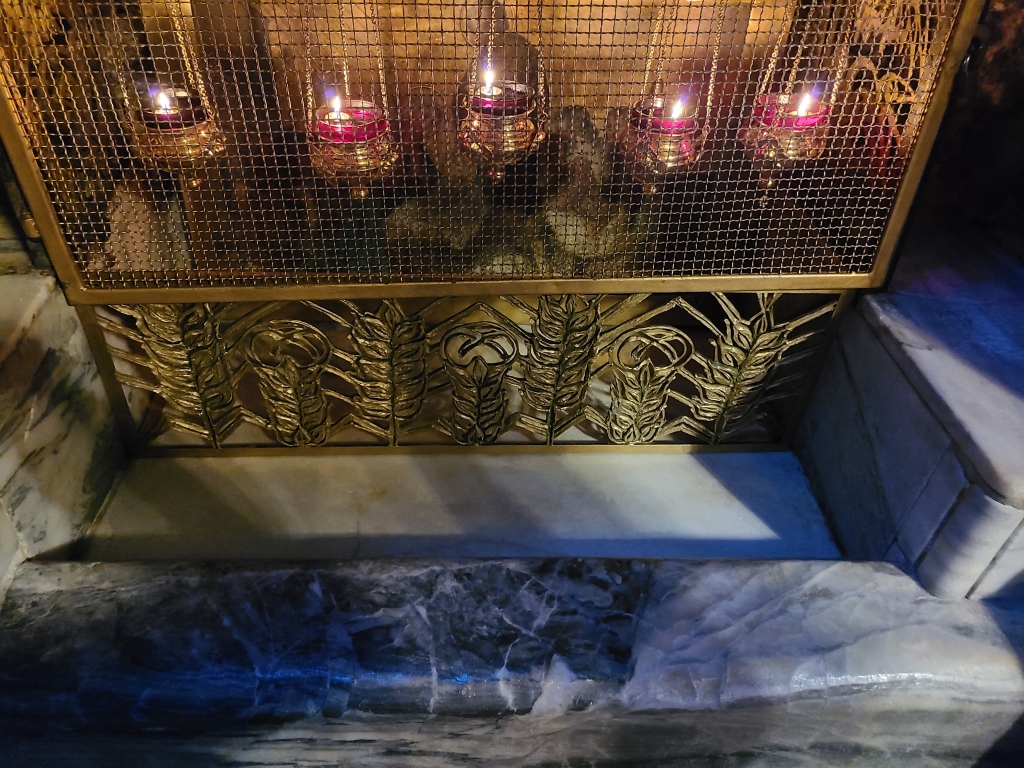
Incredible!
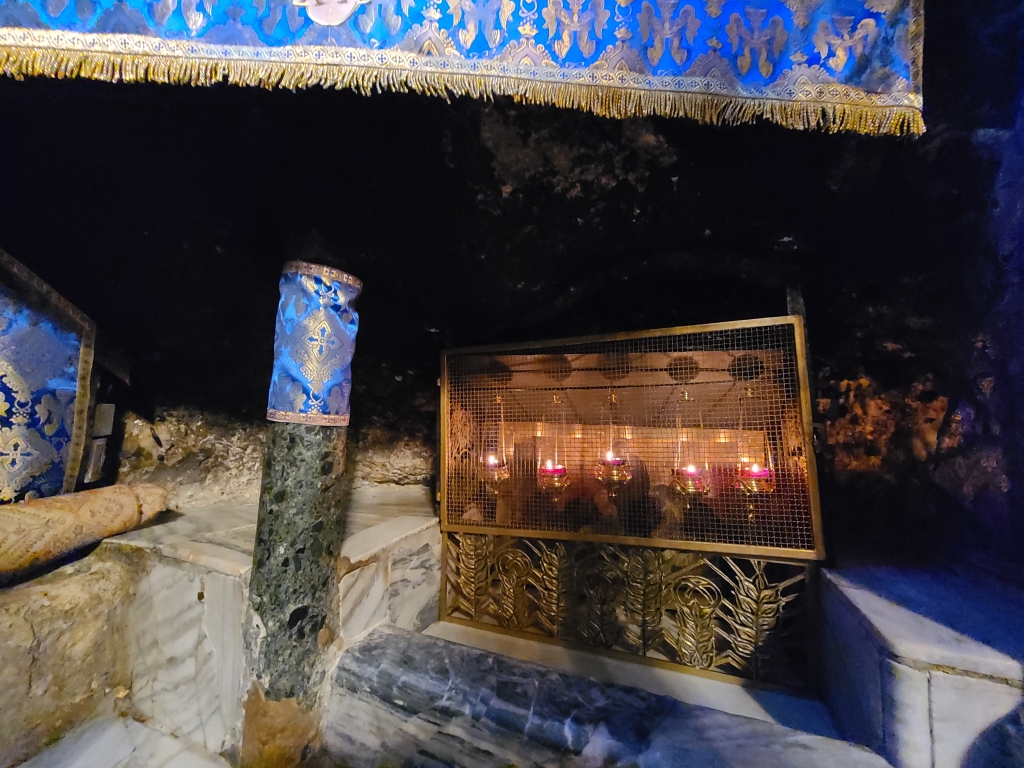
As the Armenians began to set up for their liturgy, it soon was time for me to go. I said one last prayer of thanksgiving to Our Lord for His many blessings to my family and me, and asked He pour His graces down on all my special intentions. As I left the cave, I could not help but to, yet again, follow the example of the Christmas Shepherds by “glorifying and praising God for all [I] had heard and seen.” Thank you, Lord!
Now that I had left the cave, I decided to do more exploring at the site of the Church of the Nativity. Many may not realize that the Cave of the Nativity is just one of a complex of caves under the Church of the Nativity. A map is posted that shows the caves and what they are (in English and other languages):
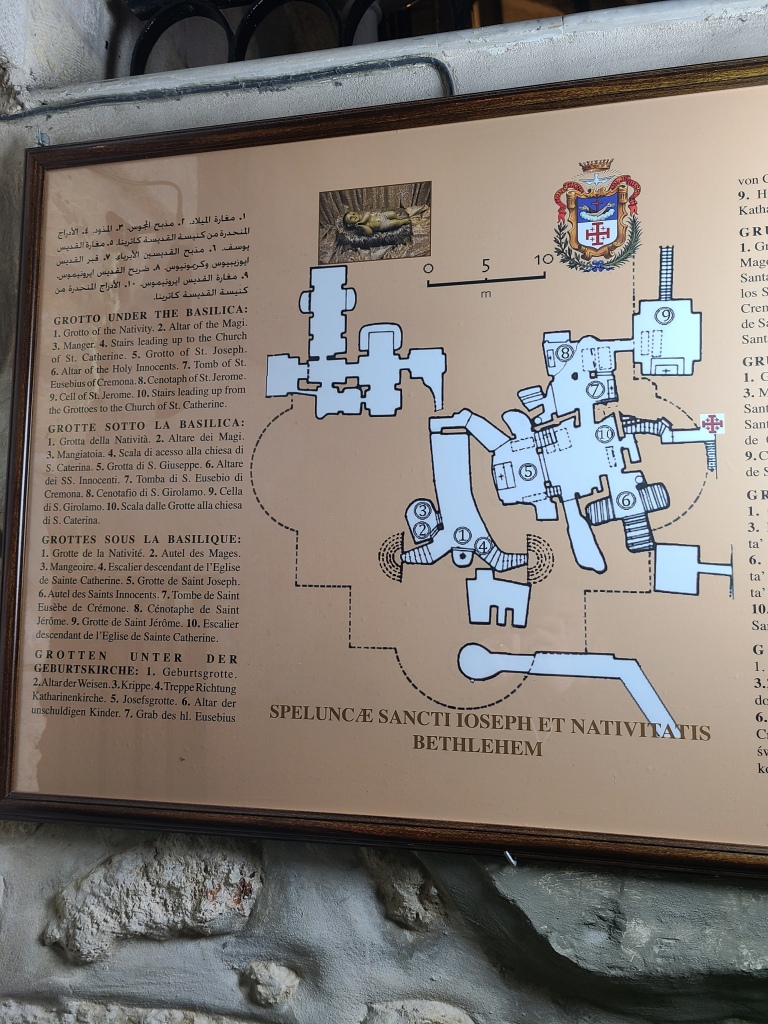
And so, I went “spelunking” once again and explored some of the other caves under the Church of the Nativity.
The photo below is the Altar of the Innocents. Surrounding the altar are small ancient tombs which a tradition holds are burial places of some of the innocent children murdered by King Herod in his bloodlust to eradicate Our Lord, the new challenger to his throne.
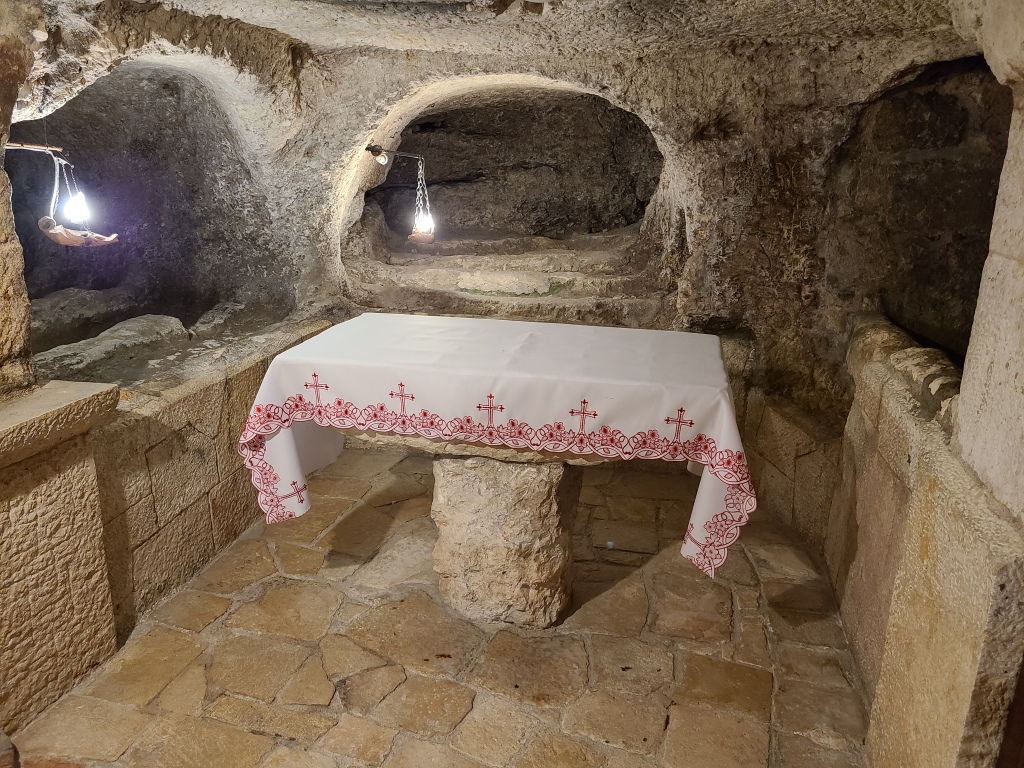
I was even able to find the backdoor to the Cave of the Nativity! Haha. I could hear the Armenian Liturgy happening on the other side of the brown door on the left in the picture below.
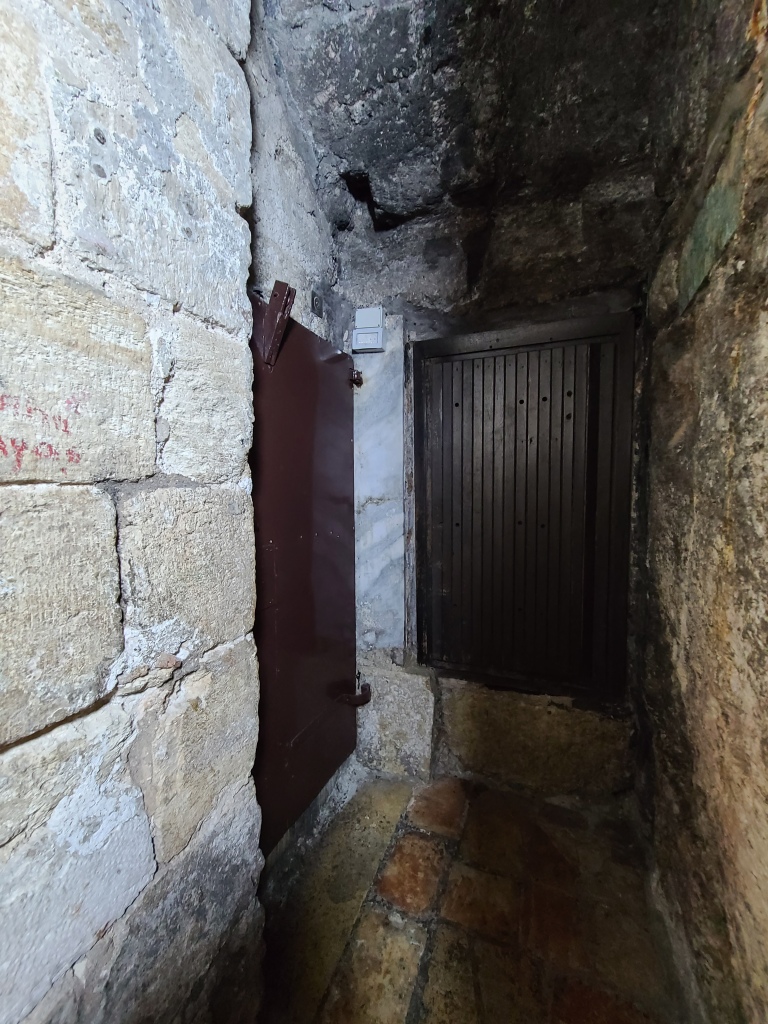
While I was outside of the backdoor, I saw some of the natural stone of the cave area more clearly…below is a picture of what it looked like.
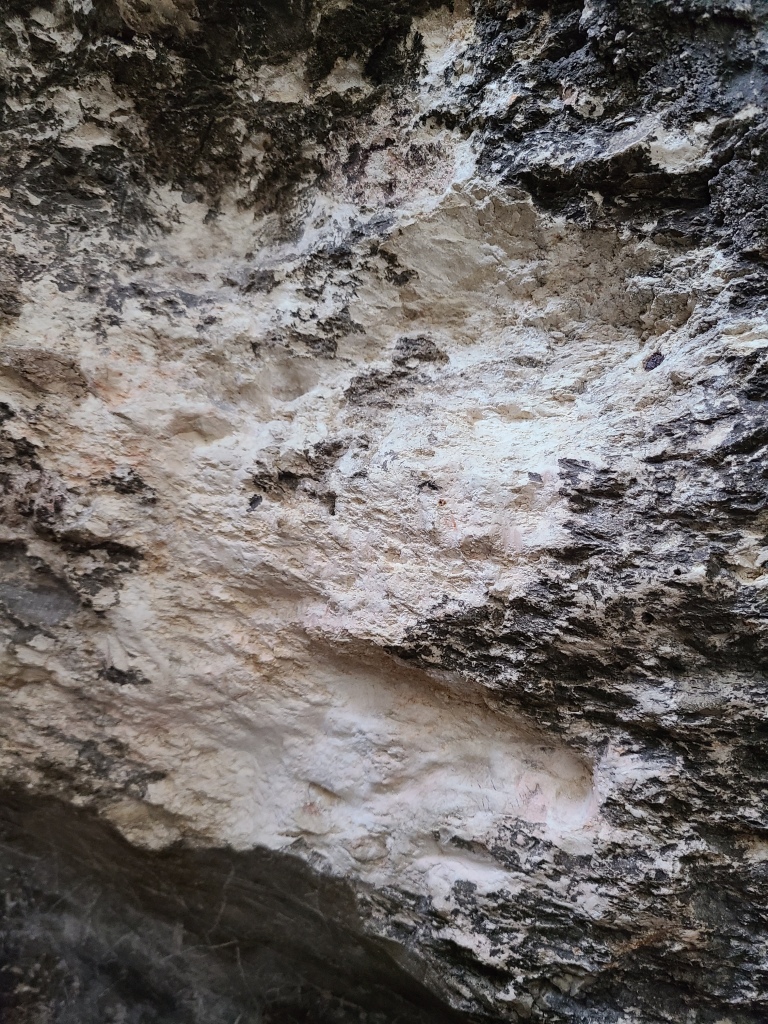
In another cave there is a cenotaph (empty tomb) commemorating St. Jerome, one of the Church Fathers and Doctors of the Church who lived from c. A.D. 342 to A.D. 420. He spent over 36 years in the Holy Land, 30 of which were dedicated to translating the Bible into Latin–a translation known as the Vulgate. His translation was essential to making God’s Word more accessible to much of the Mediterranean World, as Latin was the official language of the Roman Empire.
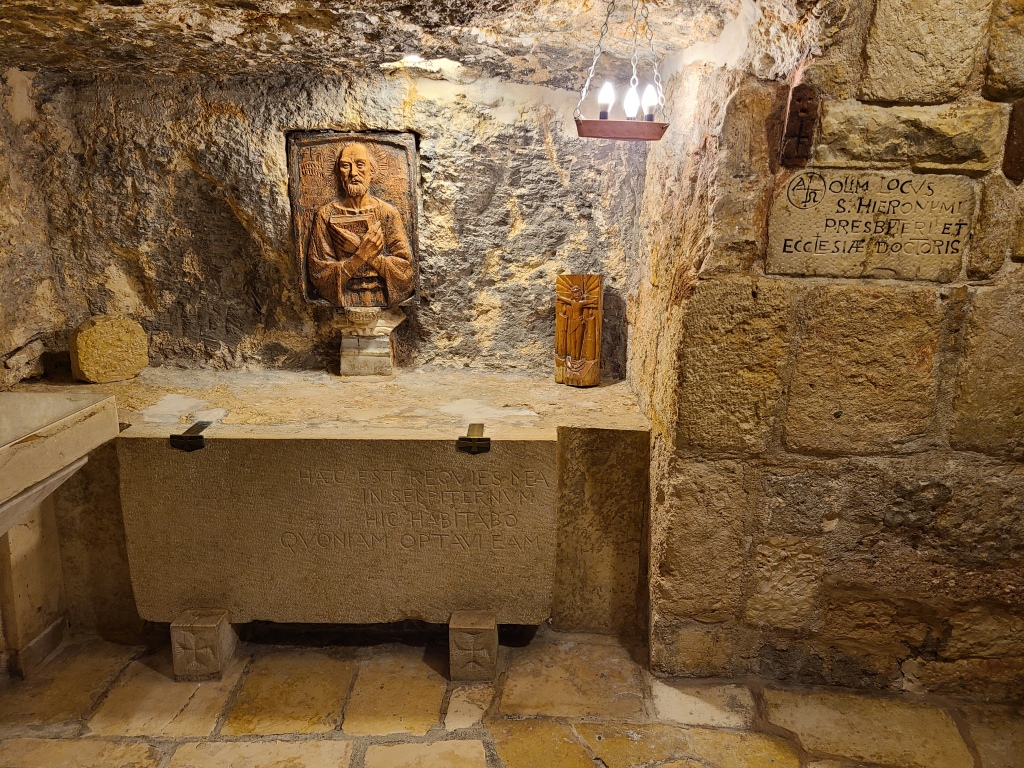
St Jerome:
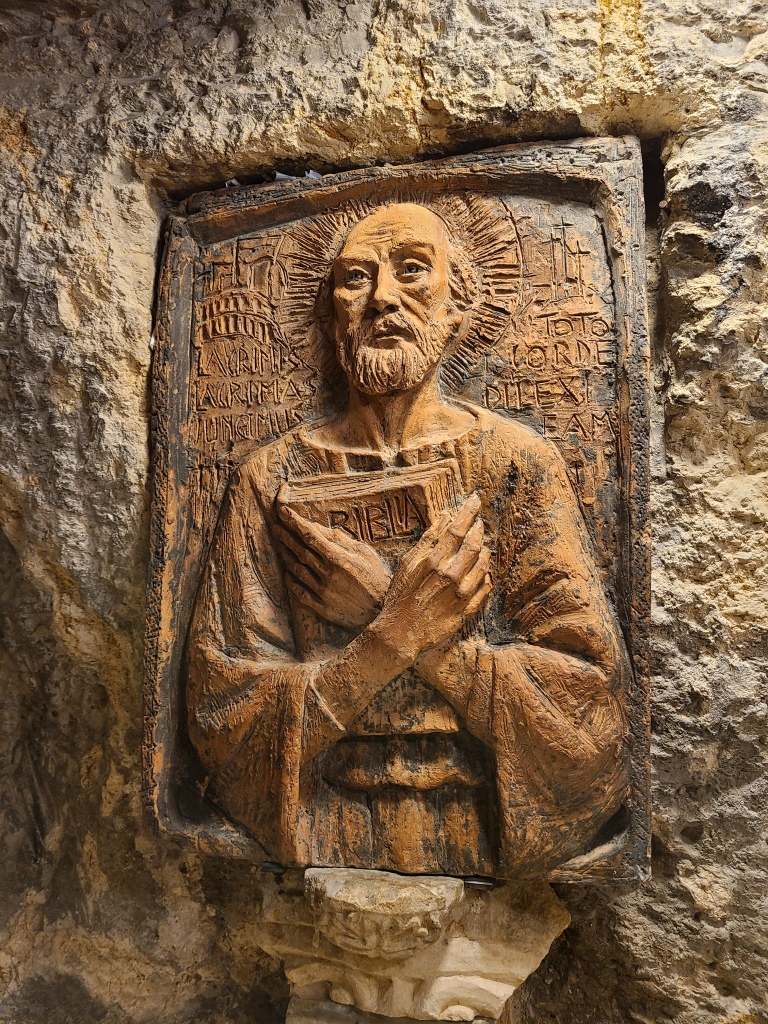
Near St. Jerome’s empty tomb (his remains were moved from Jerusalem to Rome and rest today in the Basilica of St. Mary Major), is the cave where St. Jerome lived for many years and completed his translation of the Bible. It is a small but incredibly significant place. I admire St. Jerome for his dogged persistence (over the span of decades!) out of love for our Lord to complete a major work which would change the world forever. I was standing where the great Saint lived and where he probably finally completed his grand project!
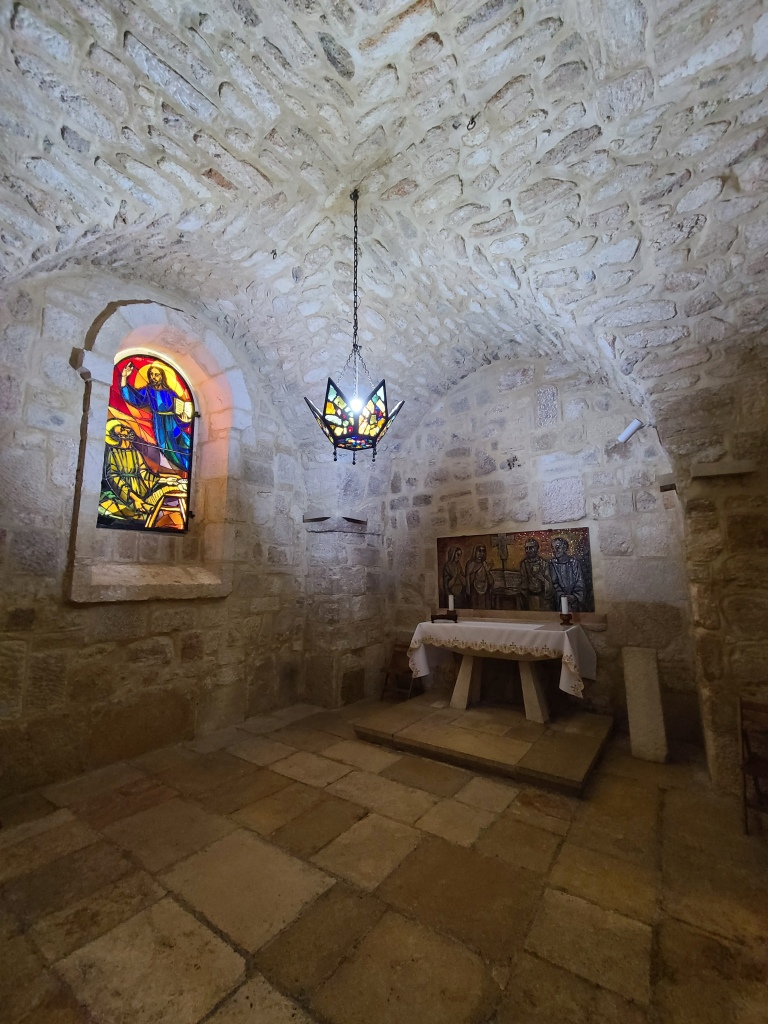
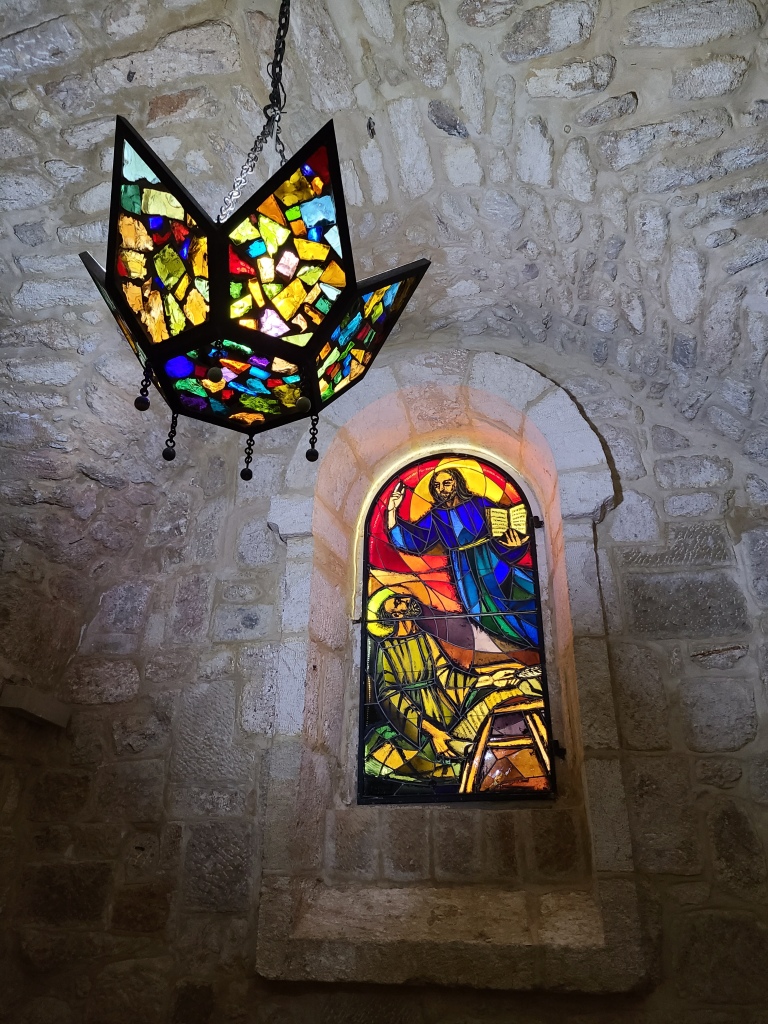
I came back up to ground level from the caves and saw a beautiful painting of St. Joseph holding two forms of the Word of God: The Torah and Our Lord Jesus Christ.
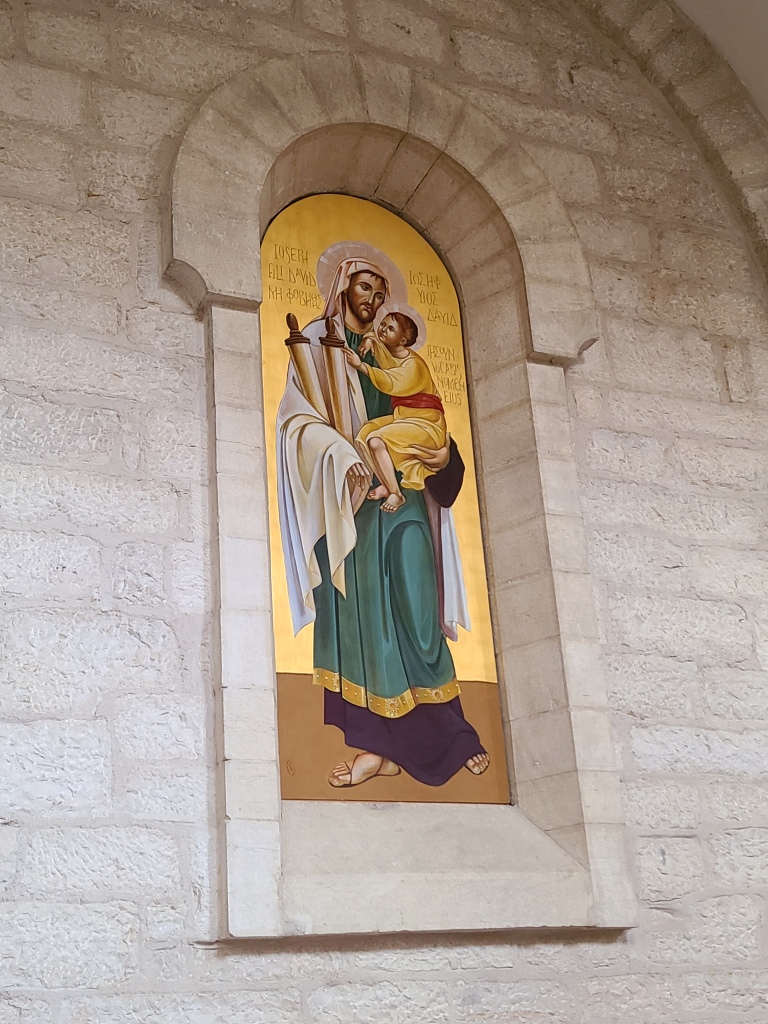
I reluctantly left the Church of the Nativity, already anxious to come visit again, and stepped into Manger Square to continue on my itinerary. In Manger Square, I was able to snap a picture of the great Christmas tree in the square next to the Nativity Scene and the entrance to the Church of the Nativity, and the sky looked very cool as well…almost like blue marble.
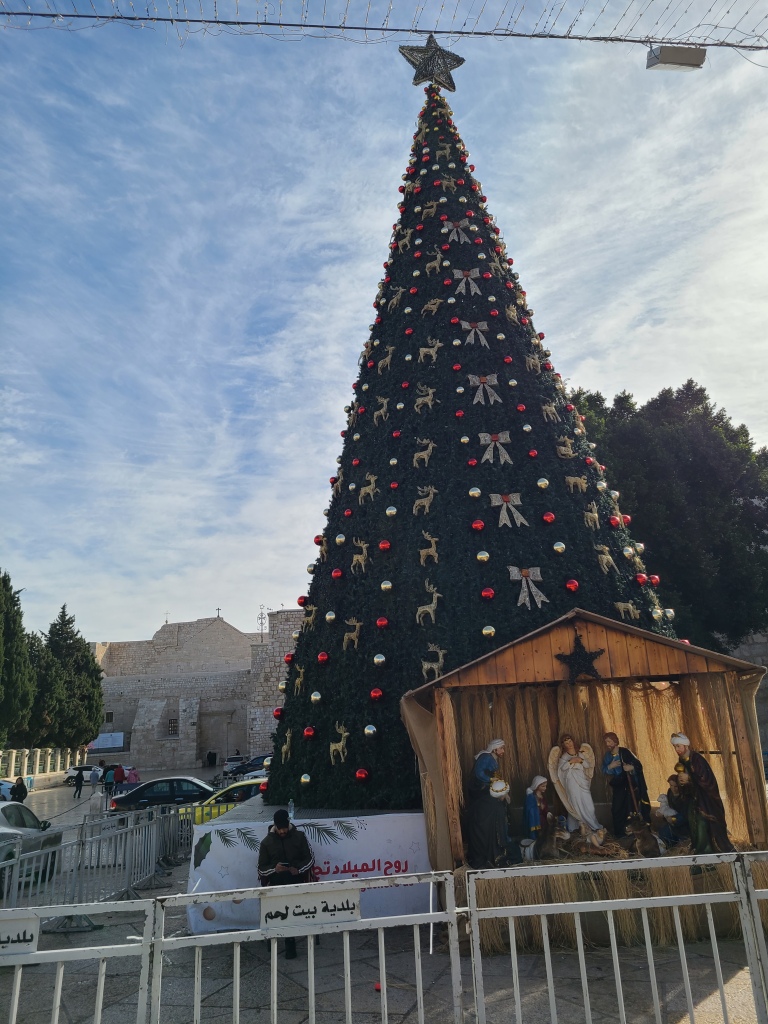
I walked down the road from the Church of the Nativity and saw a sign for a local beer that I thought looked pretty cool…haha:

As I walked down the street eastwards, I saw the entrance to the Church of the Milk Grotto on my right (GPS Coordinates: 31°42’12.28″N, 35°12’33.25″E). There is an ancient tradition dating to at least the A.D. 600s that Baby Jesus, Mary, and Joseph took shelter in this cave to avoid Herod’s soldiers and, while Mary was nursing Jesus, a drop of her milk fell to the ground and turned the stone white. Pieces of this stone were brought to Europe and miracles reported in association with them. Couples who had formerly been unable to conceive would get pregnant if they brought some of the stones from this cave into their home.
I have actually witnessed the power of God’s grace through these stones in my personal experience.
I have some friends who I gifted some fragments of stone from this cave. They had been unable to conceive after being married for several years and the wife’s doctor diagnosed that if she were ever able to get pregnant, she would probably only be able to conceive one child. After I gave them some of the fragments from the Milk Grotto, through God’s grace, they conceived their first child. About ten years later, they are now blessed with *five* healthy children–each of whom they conceived. There is definitely something special about this little-known holy site close to the Church of the Nativity!
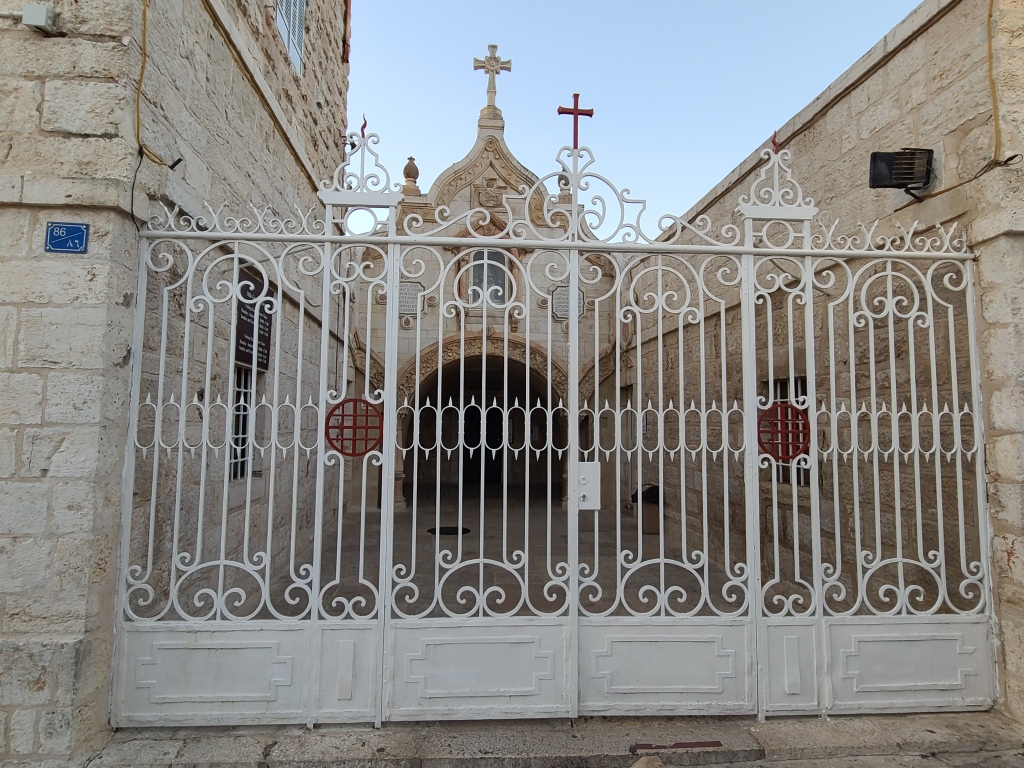
A beautiful statue of the Holy Family in flight to Egypt inside the Milk Grotto Church:
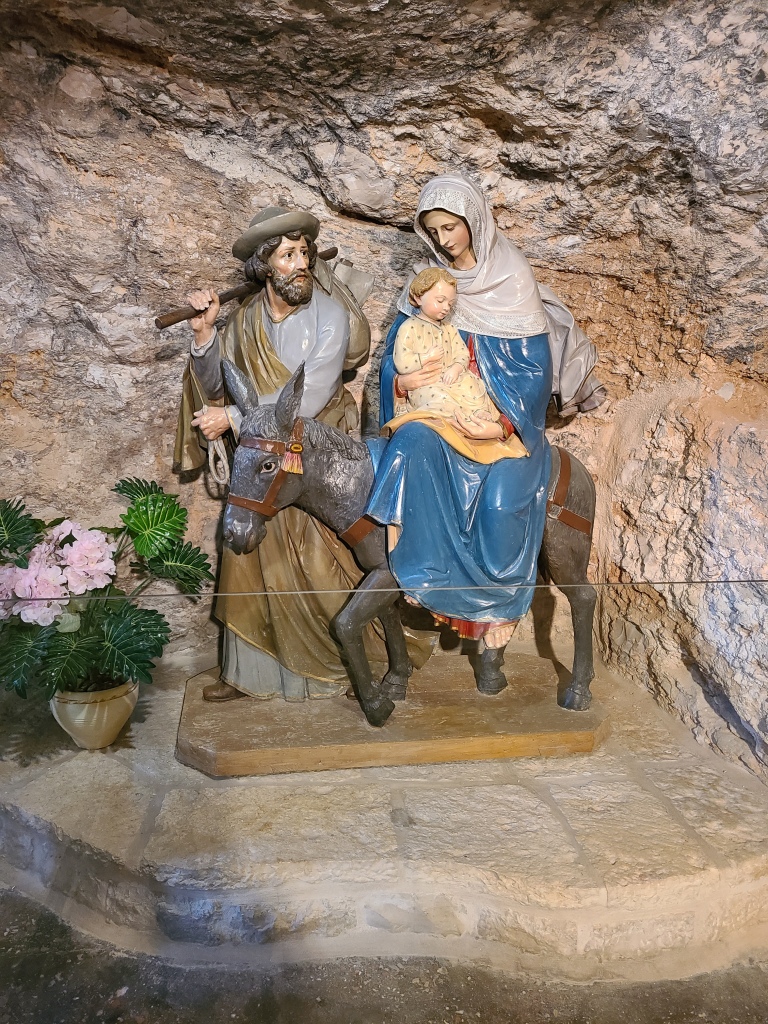
The altar inside the beautiful church of the Milk Grotto:
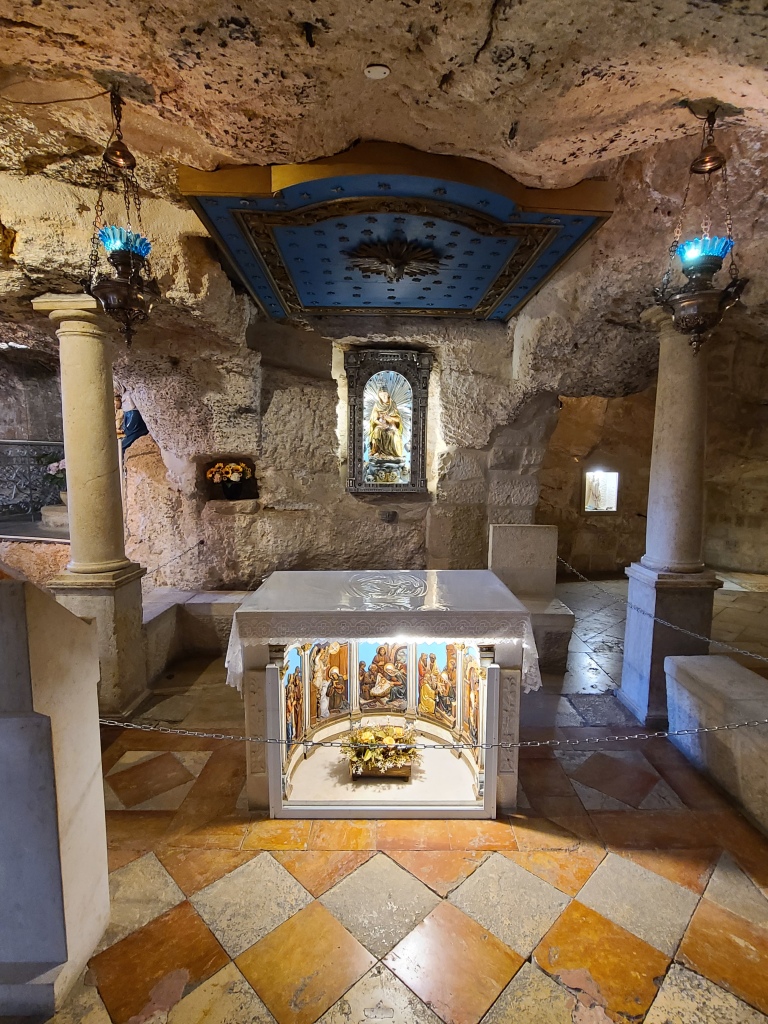
After visiting the Milk Grotto and saying a special “thank you” to Our Lady for her intercession on behalf of my friends who had received the Milk Grotto stones, I began walking down the hill of Bethlehem back down (once again) to the Shepherds’ Field. It was good to see the area in the full morning daylight (below is the view towards the area of the Shepherds’ Field from the hill of Bethlehem):
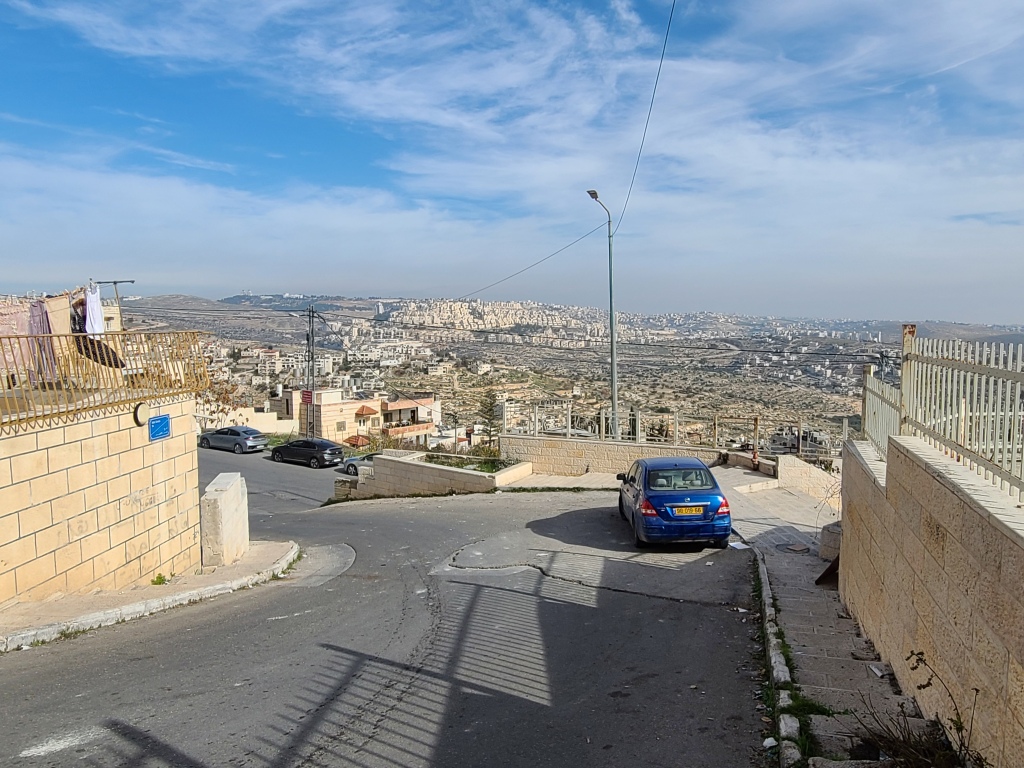
As I walked down the road from Bethlehem, I noticed a Palestinian car with a Rosary hanging from the rear-view mirror–another proof of the beauty of the Catholic–universal–Church!

I finally made it back to the premises of the Greek Orthodox Shepherds’ Field. Again, it was a different experience seeing everything in the full daylight. I was blessed with a lovely day with blue skies. As I approached the entrance to the Greek Orthodox Shepherds’ Field, I saw an impressive mosaic of the Shepherds from Luke’s Gospel. It appears the mosaic was donated by a family from Canada:
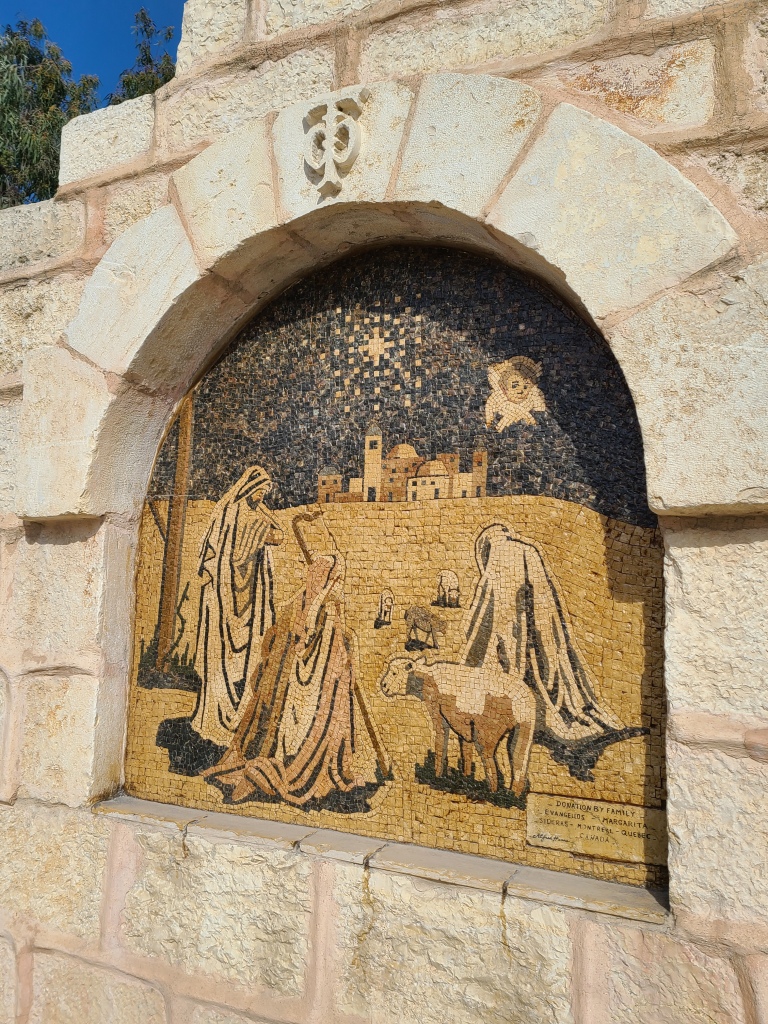
I reached the front gate of the Shepherds’ Field Complex, excited to finally visit this place that I couldn’t enter last time. I had checked the opening times online and I was arriving well after the opening time. However, when I came up to the gate…it was shut and locked! I couldn’t believe it. Over 10 years ago, I had faced the same problem. There were a couple Palestinian men standing by the gate. They spoke to me in Arabic. I gestured that I couldn’t speak Arabic and that I was trying to enter the church. They asked me “are you Orthodox?” I said “no, Catholic.” They told me the Catholic church was some distance away. I said, “no, I am here to visit the Orthodox place.” He said…”Oh…” I looked at him intently expecting him to tell me it was closed for some kind of function or Orthodox holiday. ”…all you need to do is push the button and they will let you in.” I was very surprised and overjoyed! I got closer to the gate and pushed the intercom button on the gate. After a few short seconds, the electronic gate slowly rolled open and I stepped into the Greek Orthodox Complex of the Shepherds’ Field!
As I mentioned earlier, the tradition linking this place to the angelic appearance to the Shepherds seems to be earlier than the tradition of the Catholic Complex of the Shepherds’ Field about a half a mile away. After visiting the Catholic Complex last time, and being unable to enter the Orthodox Complex, I now was able to finally explore *this* holy place.
The first sights you see upon coming through the front gate are the beautiful modern church and baptistery.
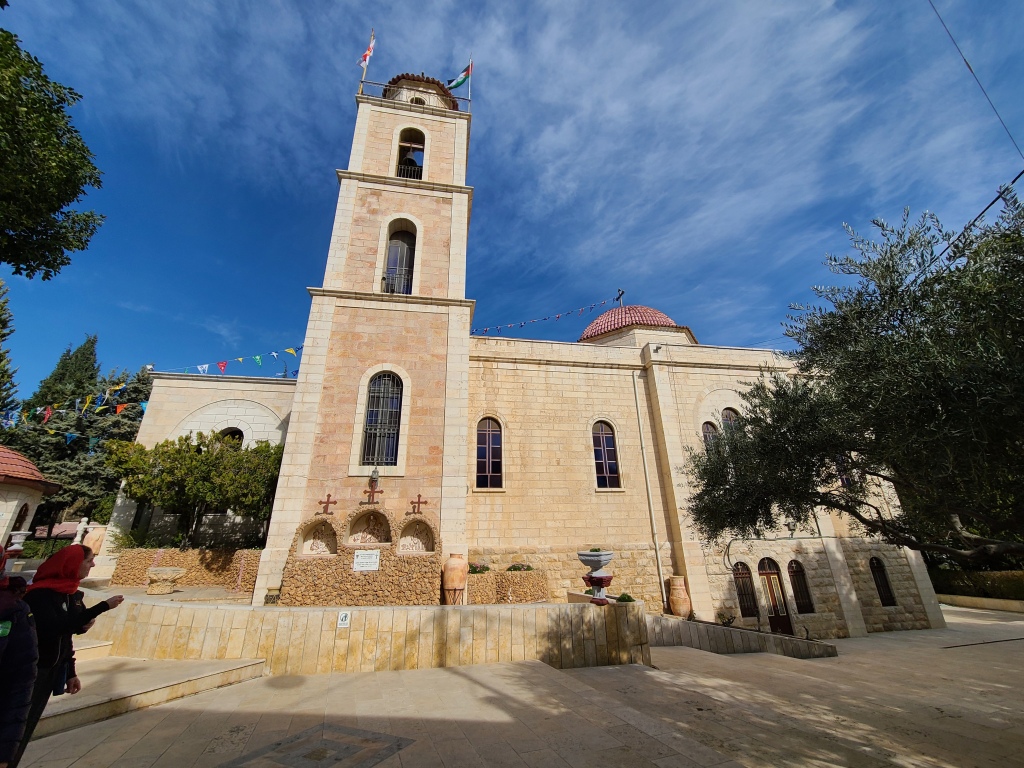
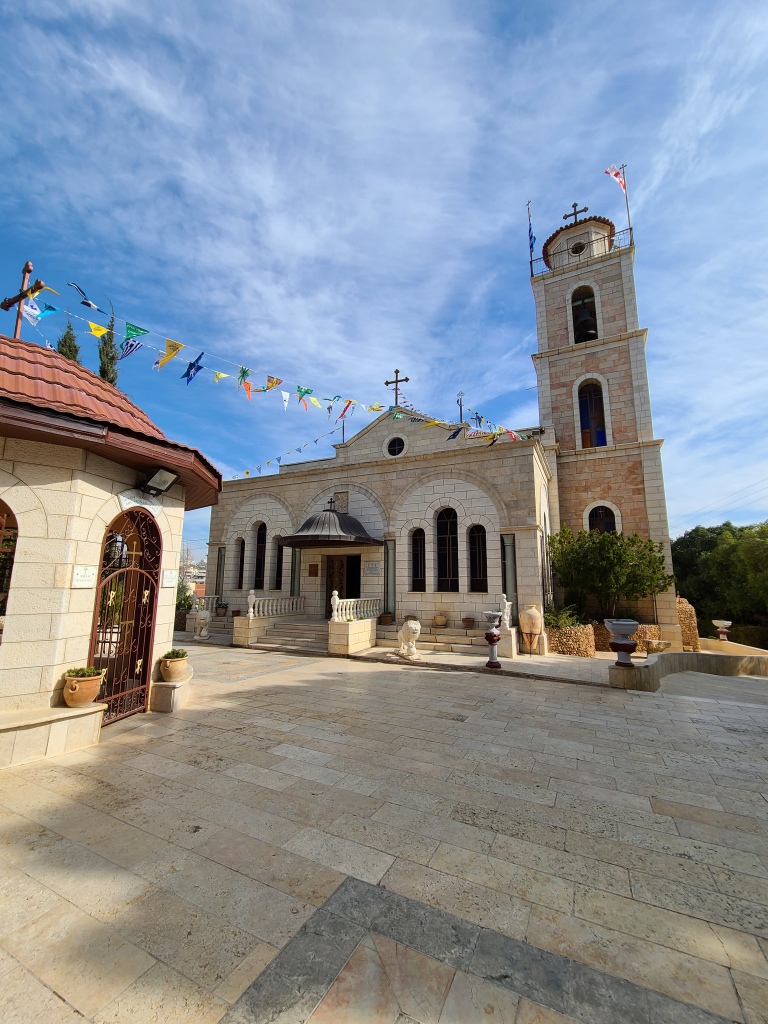
Unfortunately, there were signs stating NO pictures were allowed to be taken inside the church. That is unfortunate–as it is incredibly gorgeous.
So I can share the inside with you, my readers: thankfully, I was able to find some pictures online and get the license to them, so I’ll share them below! Enjoy!
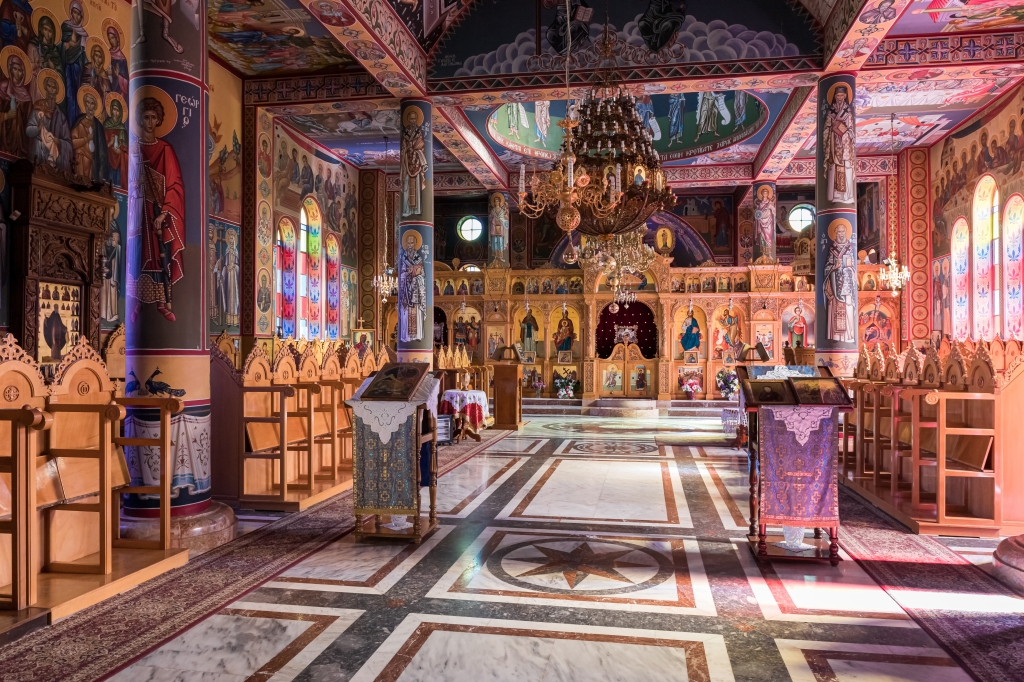

The bright colors and heavenly figures above you seem to give the visitor an impression of what the sky above this very place could have looked like to the shepherds 2,000 years ago on the night of Christ’s birth.
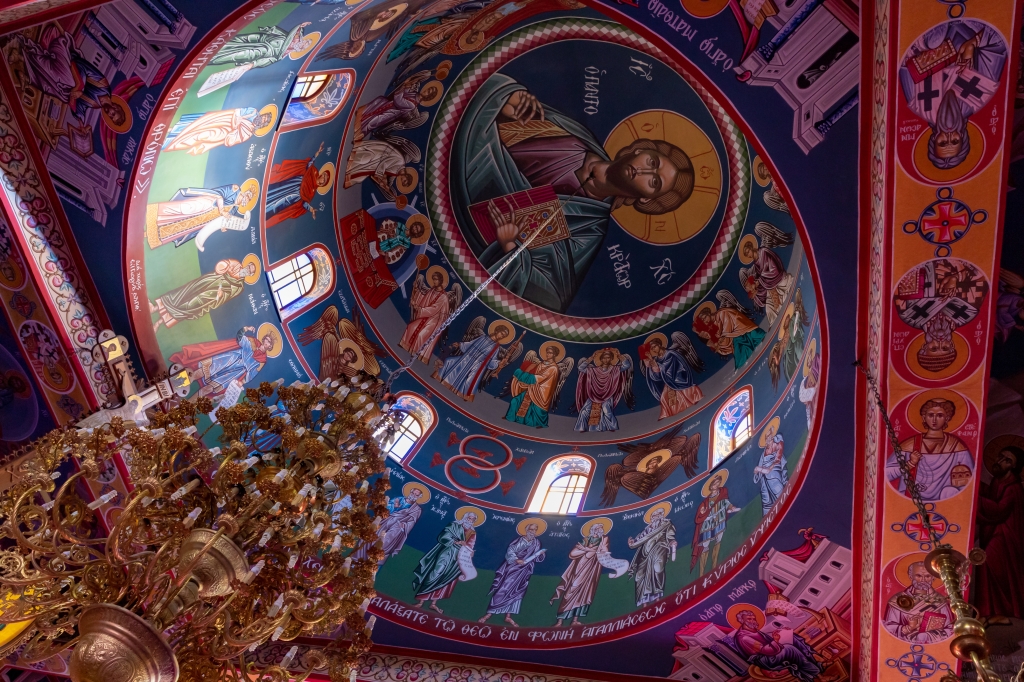
The back of the church had an impressive Eastern iconographic fresco of the announcement of Christ’s birth to the shepherds.
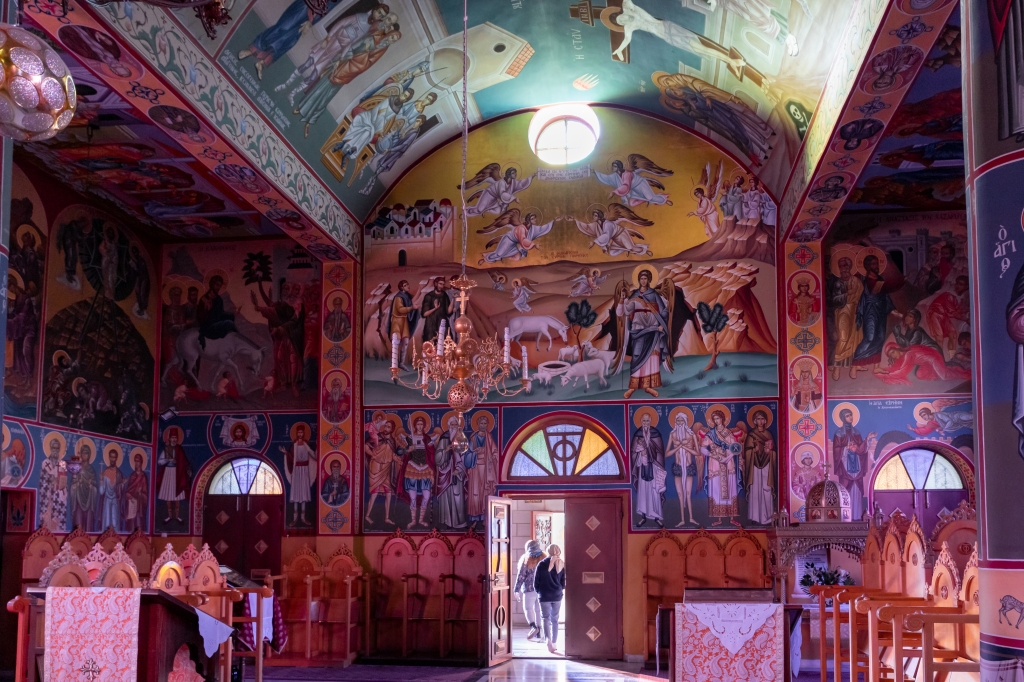
After stepping outside the church, I took a right and walked down a shaded path towards some ancient church ruins.
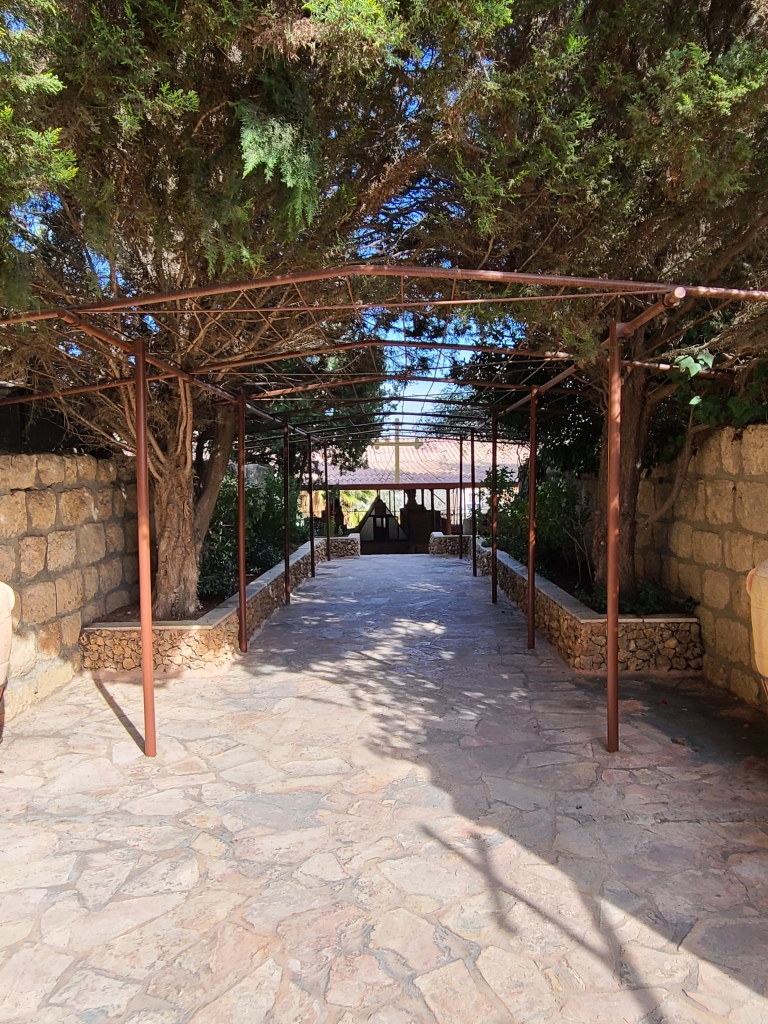
In front of me were the remains of successive churches from the 5th, 6th, and 7th Centuries that had been built on top of the Cave of the Shepherds where the shepherds were taking shelter the night of Christ’s birth when the angels appeared to them (GPS Coordinates: 31°42’7.17″N, 35°13’35.86″E).
Inside the cave are the remains of the first church built at this location in the 4th Century by the Emperor Constantine’s mother, St. Helena. There has therefore been a place of devotion here since the same time the first churches of the Holy Sepulcher and the Nativity were being built.
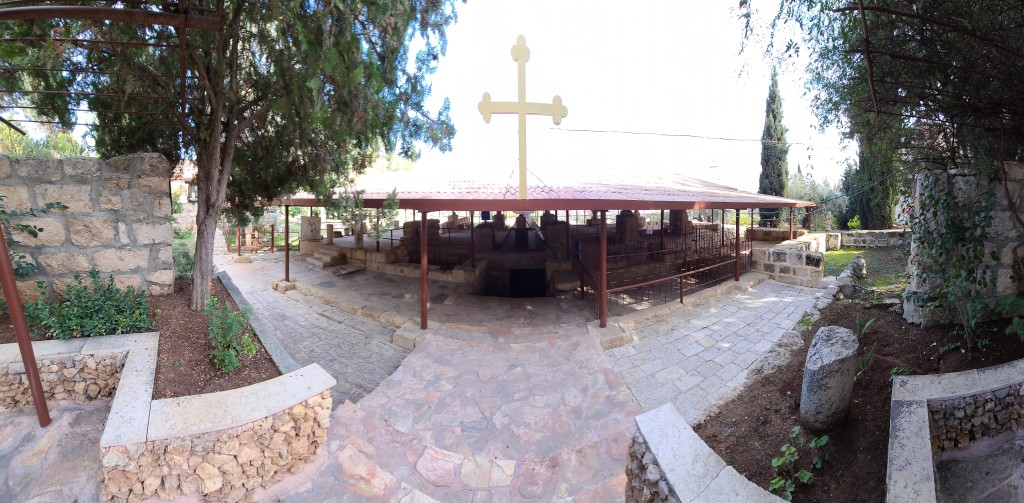
Next to the ruins and the entrance to the cave were a couple sheep statues sitting on the grass. Nice touch! haha:
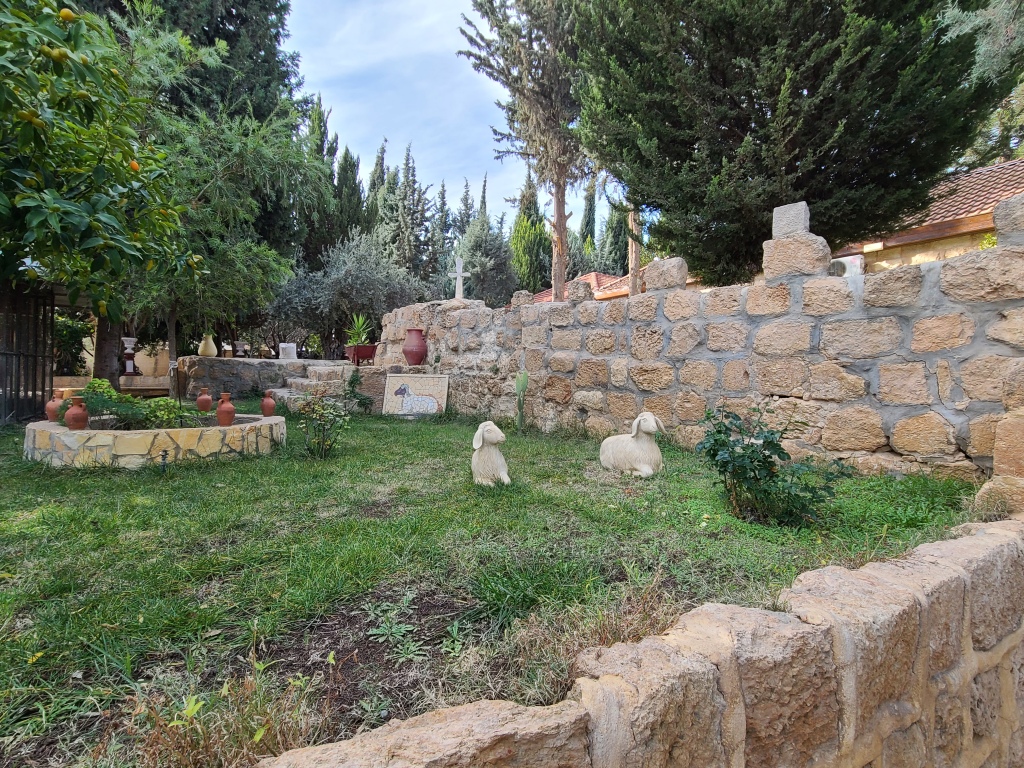
Below are some of the ruins of the ancient churches. The last church above the cave was built in A.D. 632 after the Byzantines re-conquered the Holy Land from the Persians. Unfortunately, that church was later destroyed as well and never rebuilt.

Some of the ancient mosaic floor is still intact!

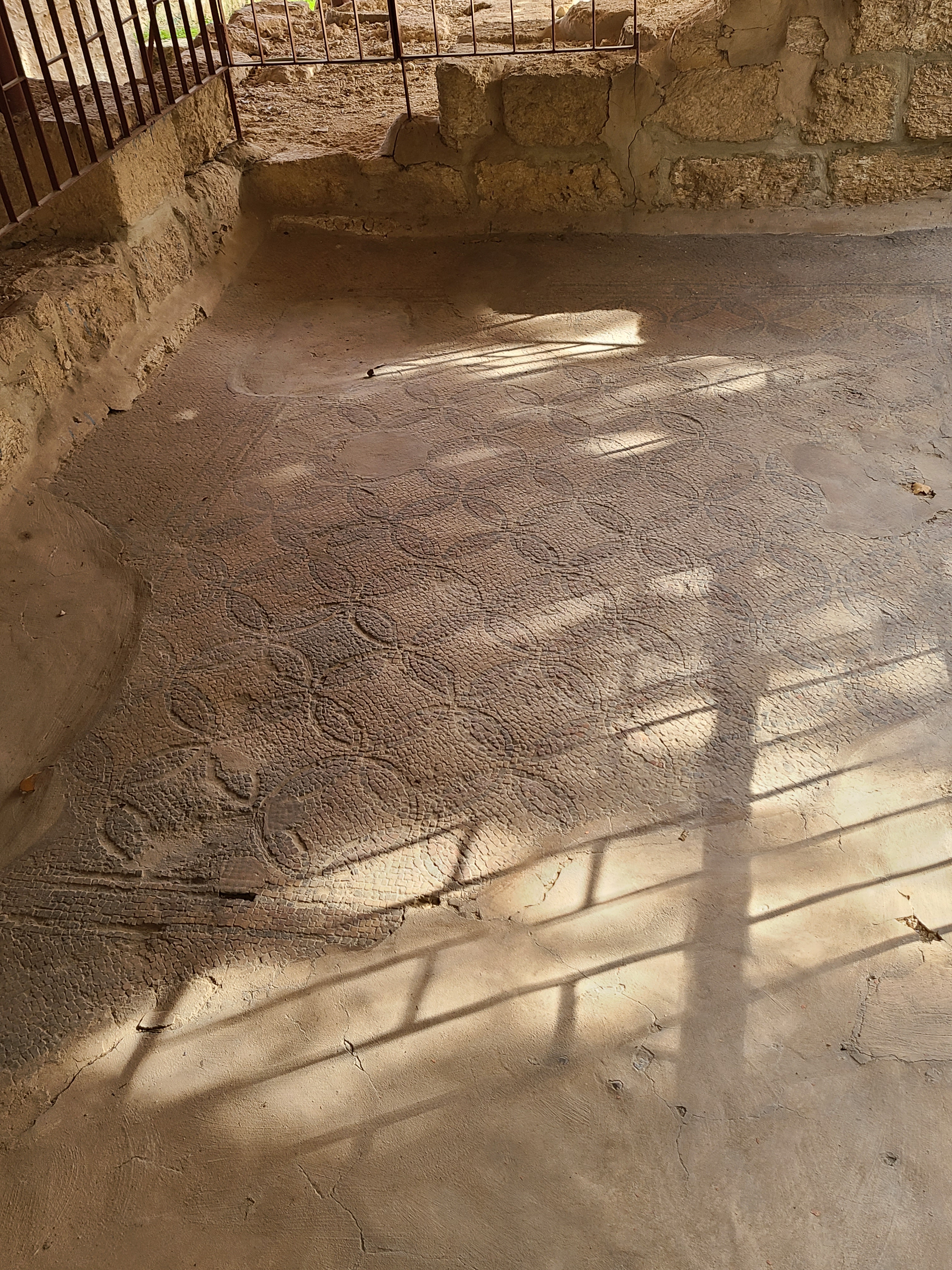
After looking around the ruins, I decided to go down into the holy cave where the shepherds had been taking shelter when the angel appeared to them…

As with the Greek Orthodox Church of the Shepherds Field, the ancient cave church of the shepherds had a strict “no photos” policy. Below are some photos I got the license to so I can share the beautiful interior with you.
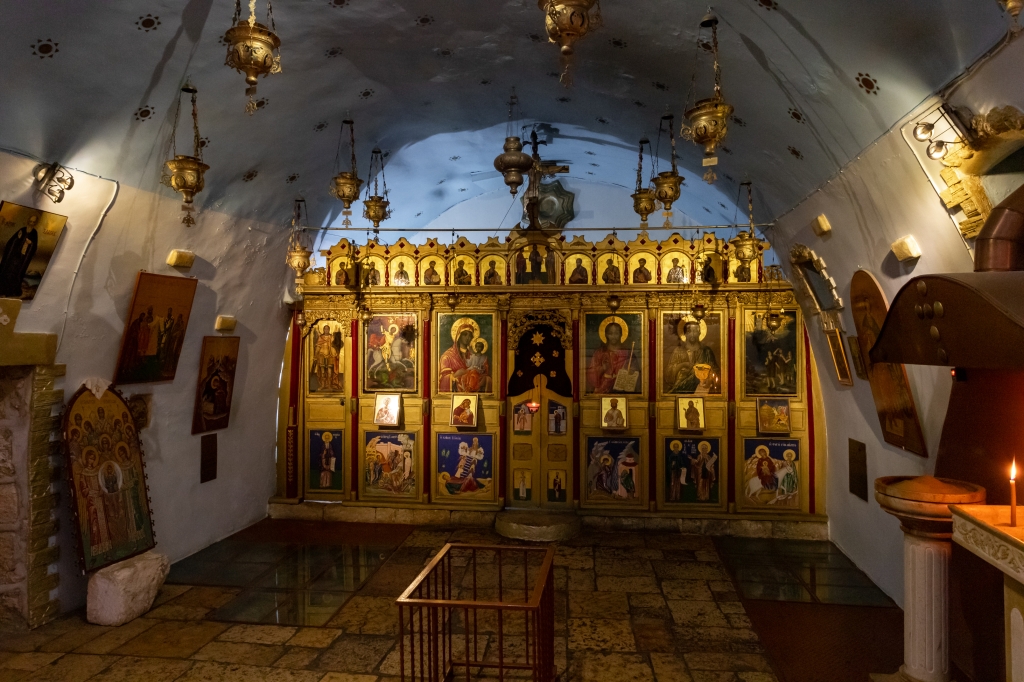
Mosaic flooring from the original Cave Church built by St. Helena sometime between A.D. 326 and 333.
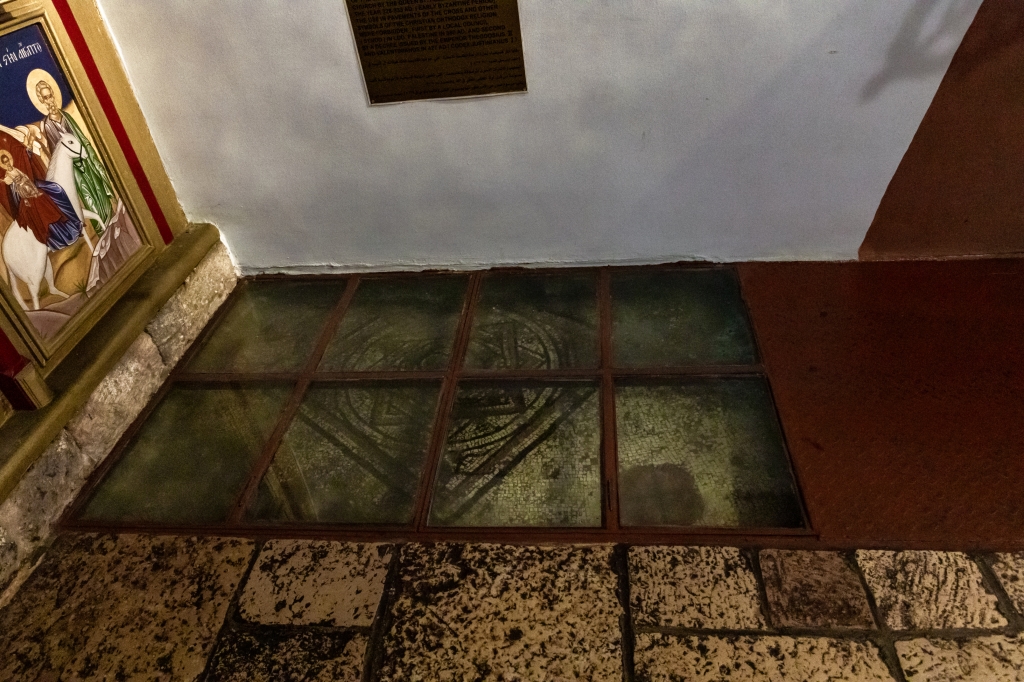
During excavations of the churches here, the remains of Christian monks slaughtered by the Persians were found. Some of their skulls are on display (see the left side of the picture below).
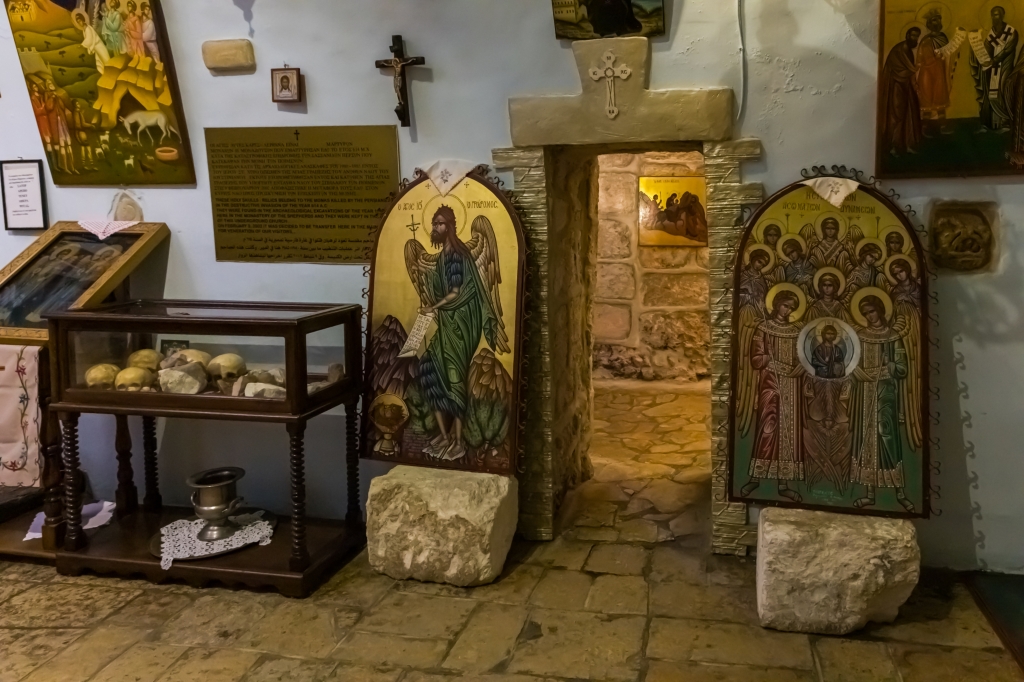
The back side of the cave church has an incredible fresco of the birth of Jesus and the angel’s announcement to the shepherds:
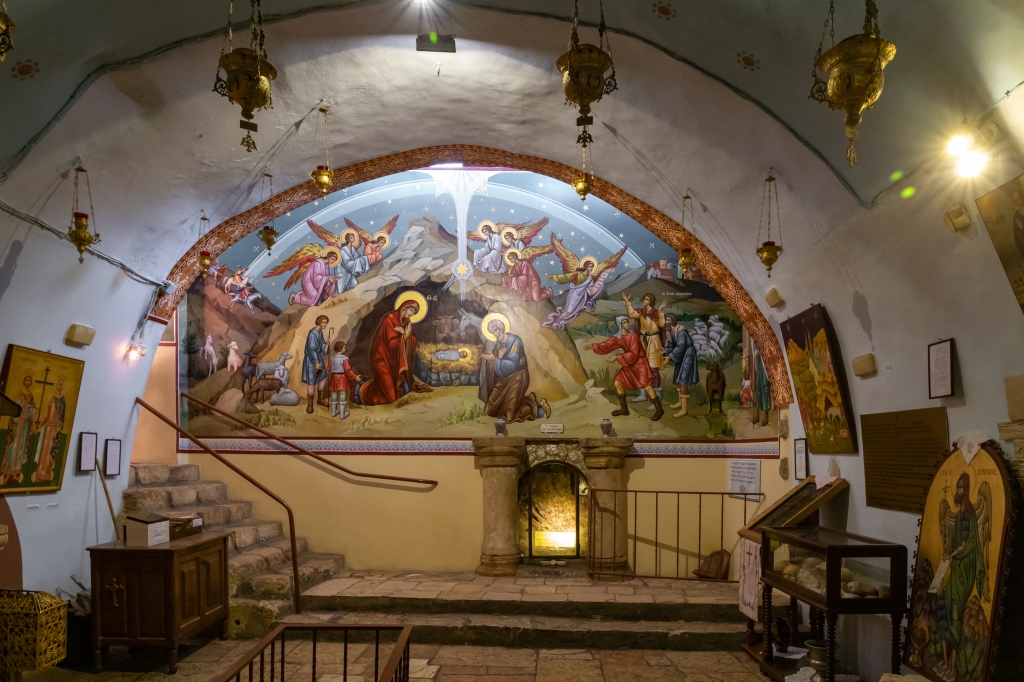
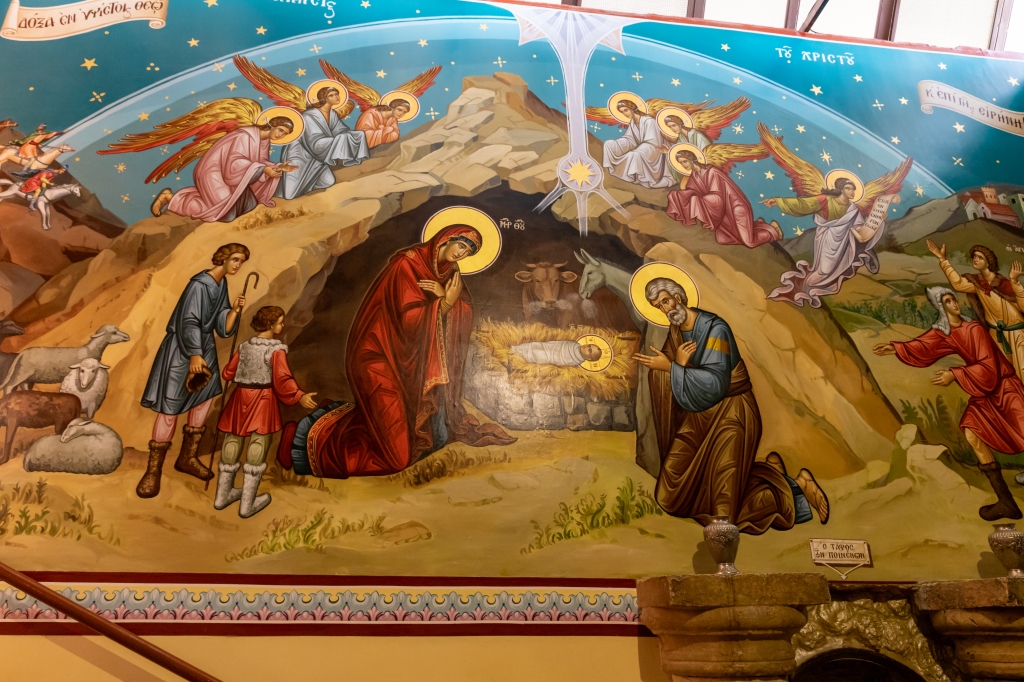
Underneath the fresco is a small stone niche that tradition holds is where the bones of the shepherds were kept after they died.
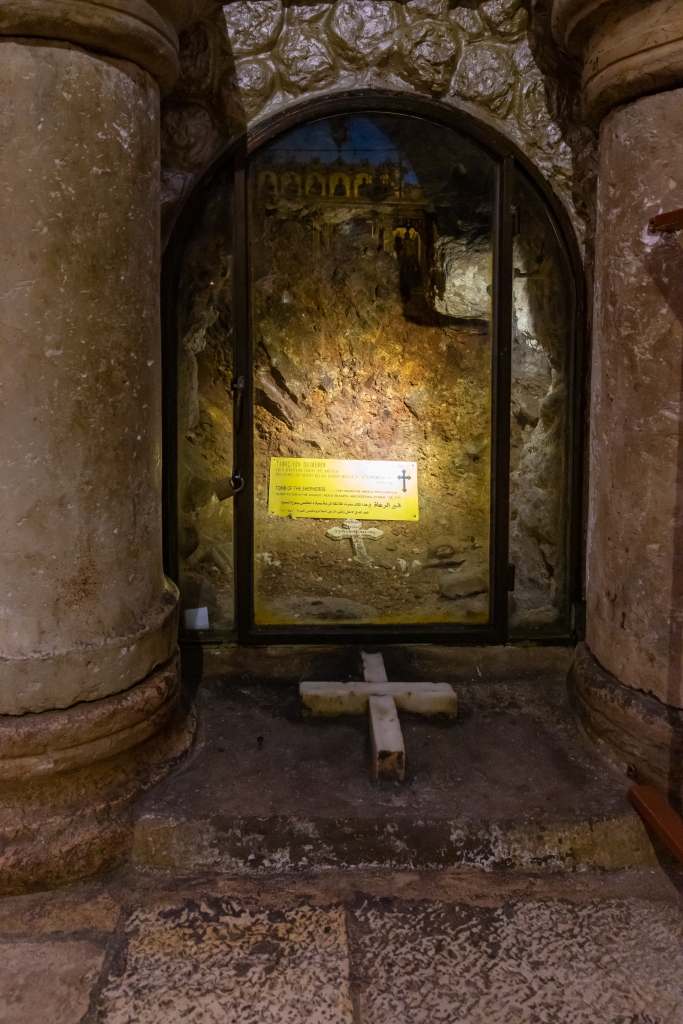
After spending some time in this small, ancient cave where Christians have been worshipping for at least 1,700 years, I came back outside to do more exploring of the grounds of the Greek Orthodox Shepherds’ Field. The excavated remains of the Byzantine churches that once stood here were very interesting.
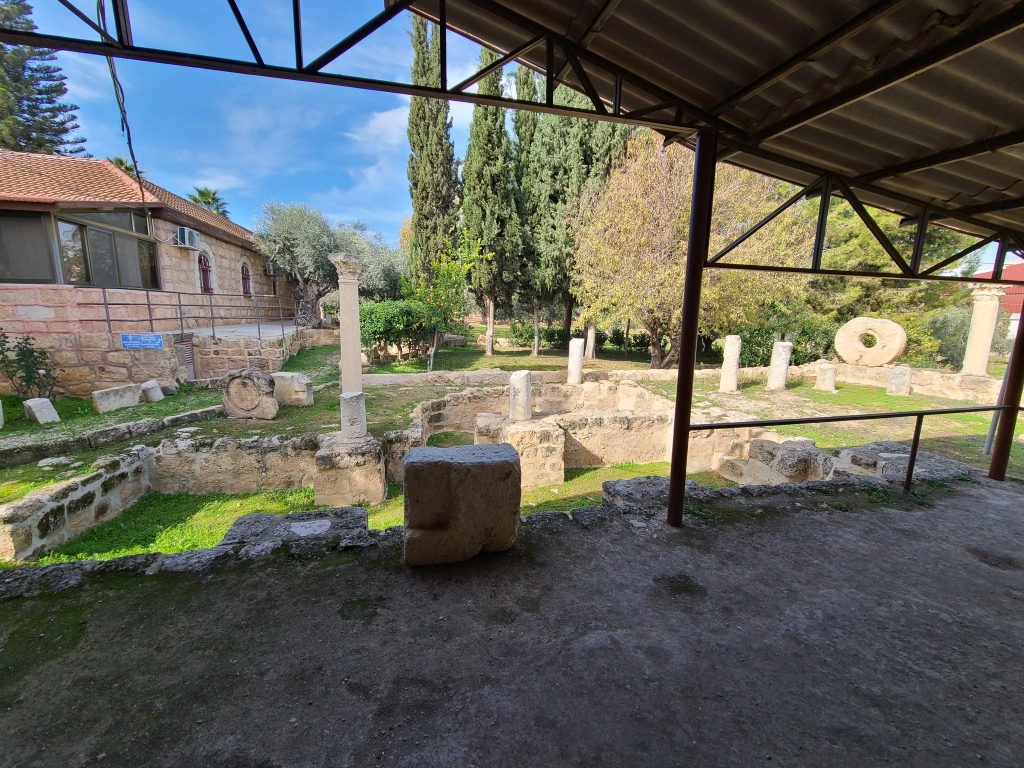
I walked around to the north side of the cave area and stopped to pray and meditate. I was enjoying the cool, bright day with its refreshing, light breeze. It was quiet. I was the only person in the area. I decided to take a couple minutes to lay down on the green grass and look up at that beautiful sky–during the daytime now–where the Glory of God and the Heavenly Hosts appeared to the shepherds. It was refreshing to relax for just a bit, especially since I had been running all over Bethlehem for hours now! haha.
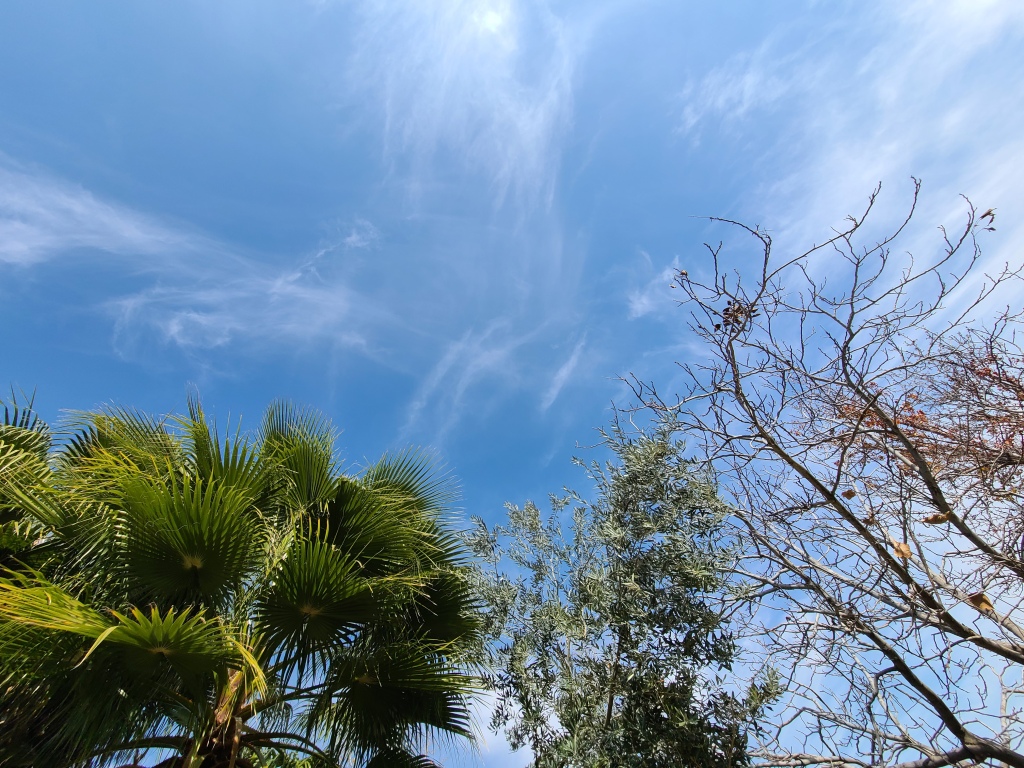
After taking a few minutes to reflect and enjoy the Lord’s creation in this special place, I decided to collect some rocks and turf from the green scrub that made up the holy Shepherds’ Field…I’m sure still radiating holiness 2,000 years later from the event that happened here!
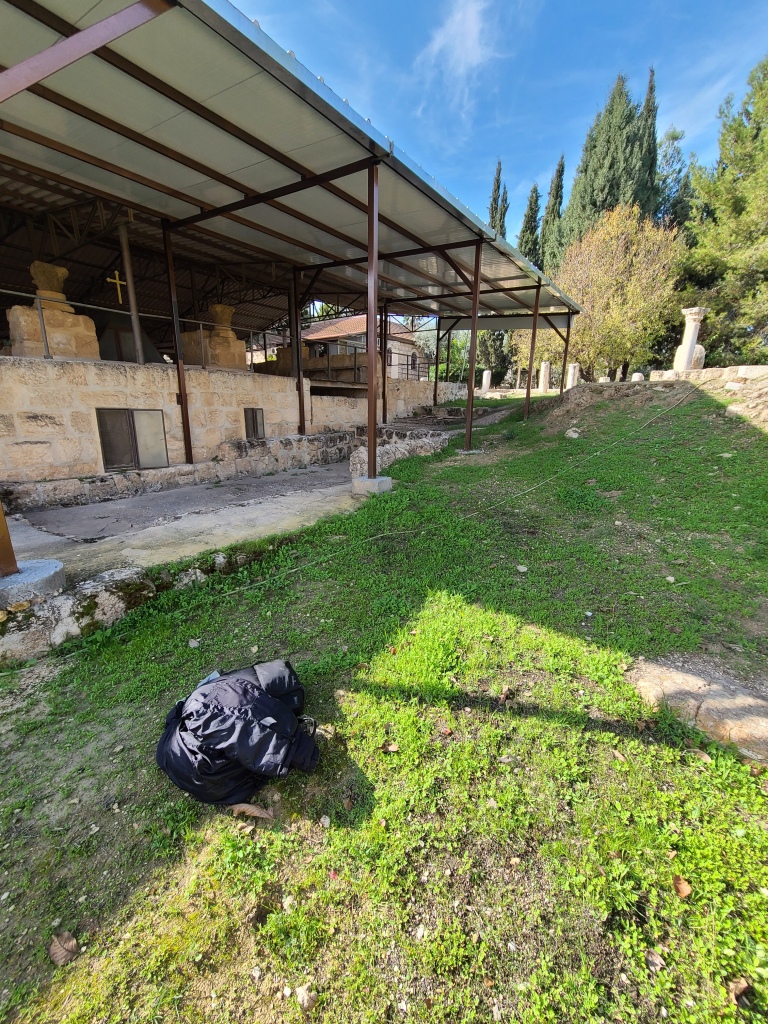
Ironically, about 7 months later, I was watching a clip of Matt Fradd’s incredible interview with an exorcist, Fr. Carlos Martins, which was posted on YouTube on 8 August 2023.
During this interview, Fr. Martins discusses his procedure for gaining control of a demon during an exorcism session. One of the ways he gains this control is to ask the demon to state the purpose they were originally created by God as a good angel before they rejected God’s will and became a fallen angel/demon.
Fr. Martins says:
“[During an exorcism] I ask ‘for what purpose were you [originally] created [as a good angel]’….The reason I most often have heard as to why they were created, and it astounds me every time, I’ve heard it so many times: [the demons say] ‘I was created to be a part of the throng that proclaimed, ‘Glory to God in the highest’ above the Shepherds’ Field.’…God created beings for that event! He created spiritual fireworks for that proclamation….Those demons…they react horrifically, for example, when you sing a Christmas carol in the room in an exorcism….The next time I went to Israel and I went to the Shepherds’ Field, I made sure to bring back a bag of rocks. You take a rock and touch it to a demon who states that ‘this was my purpose’ and he rejected it. Well, this thing now is the cutting edge of a blade that wounds him.”
How powerful!
(Small jars of rocks and turf from this hallowed field make great Christmas gifts for loved ones, BTW! ;) (much to demons’ chagrin…haha))
I next began walking around the area to do more exploring. I saw some ancient millstones on display not far from the cave. Imagine having one of those tied to your neck and being cast into the sea! No thanks!
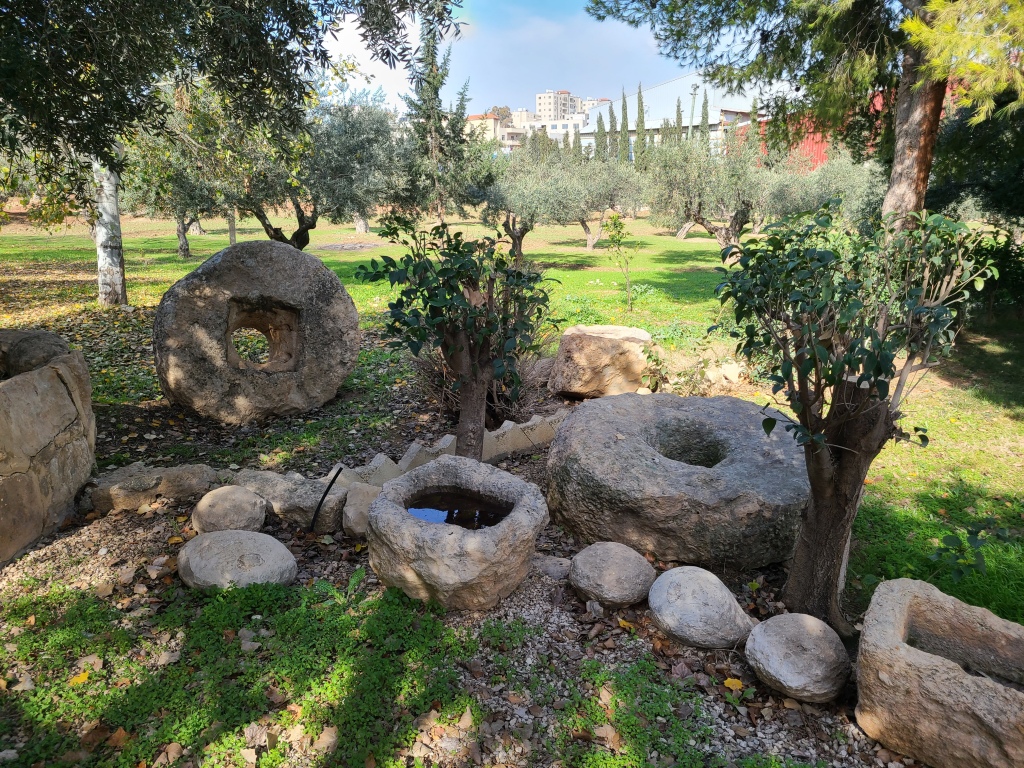
There were also some ancient olive trees there. A sign in front of one of the trees states they were planted *before* Christ! Therefore, they would have been silent witnesses to the “spiritual fireworks” here on Christ’s birthday! Amazing…
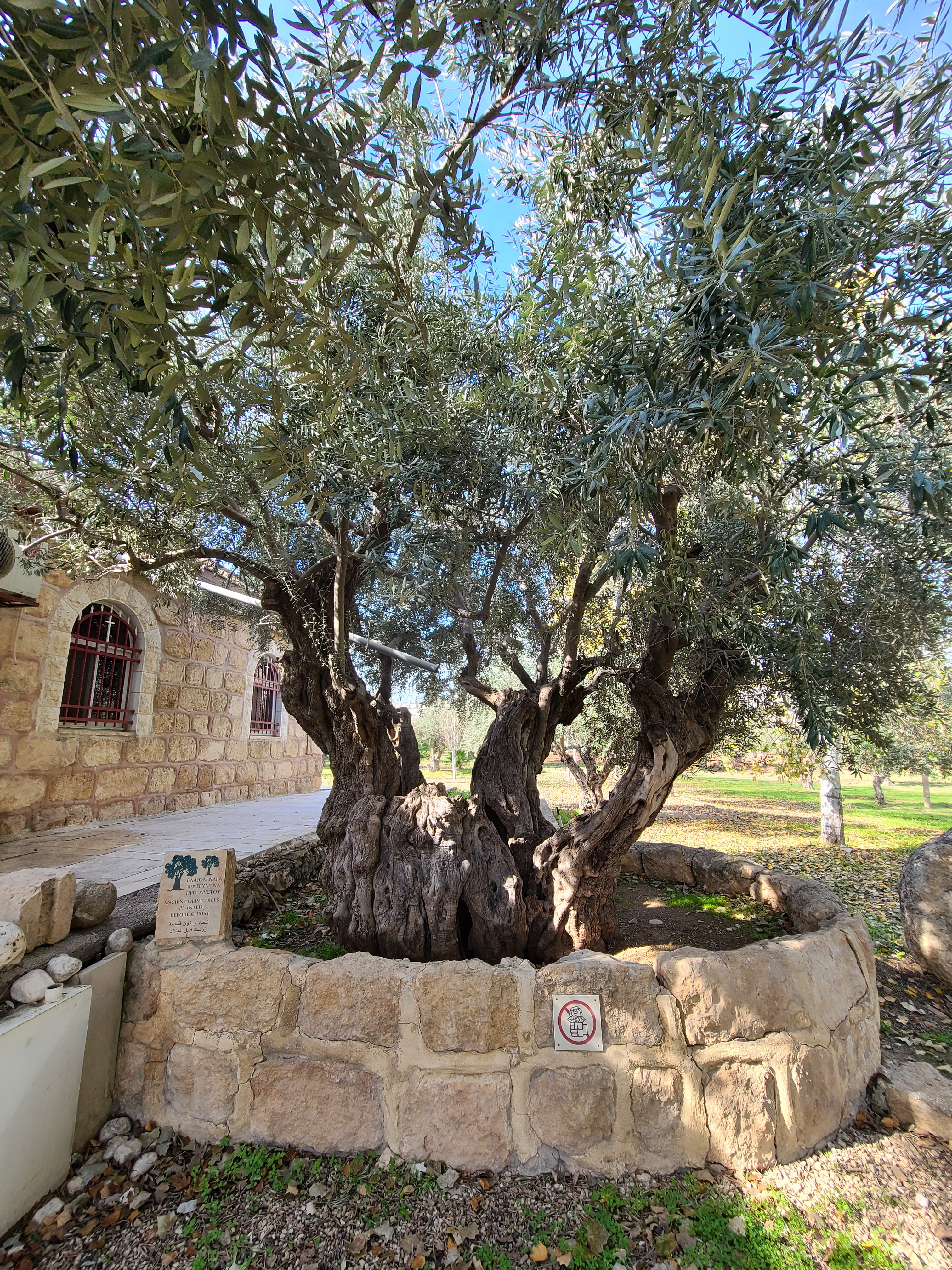
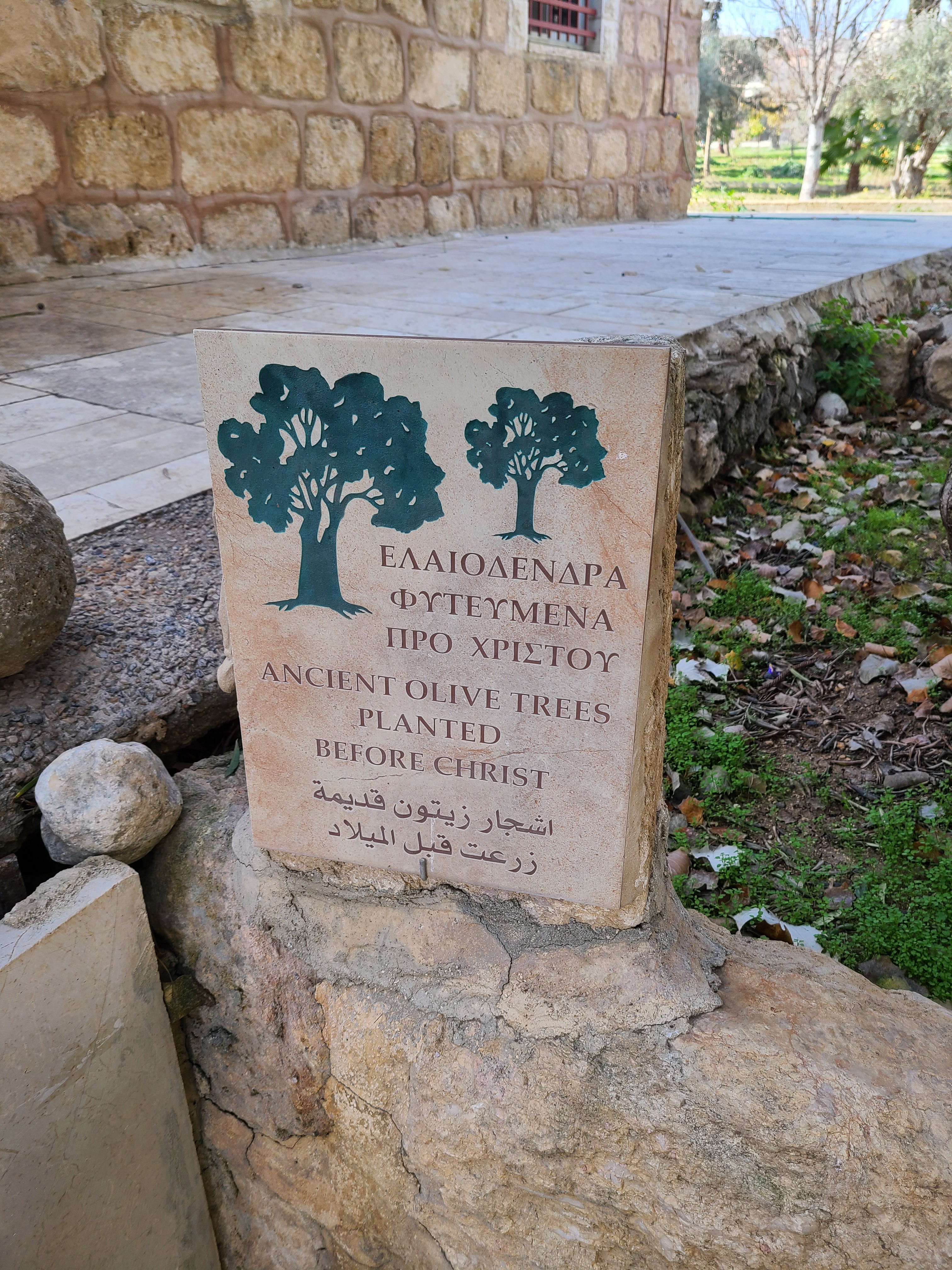
I walked a little further through the field here. It was green and beautiful, filled with small olive and evergreen trees. There was even an area where a fire had been burning. Perhaps the same place where some of the shepherds had been warming themselves on the night of Christ’s birth?
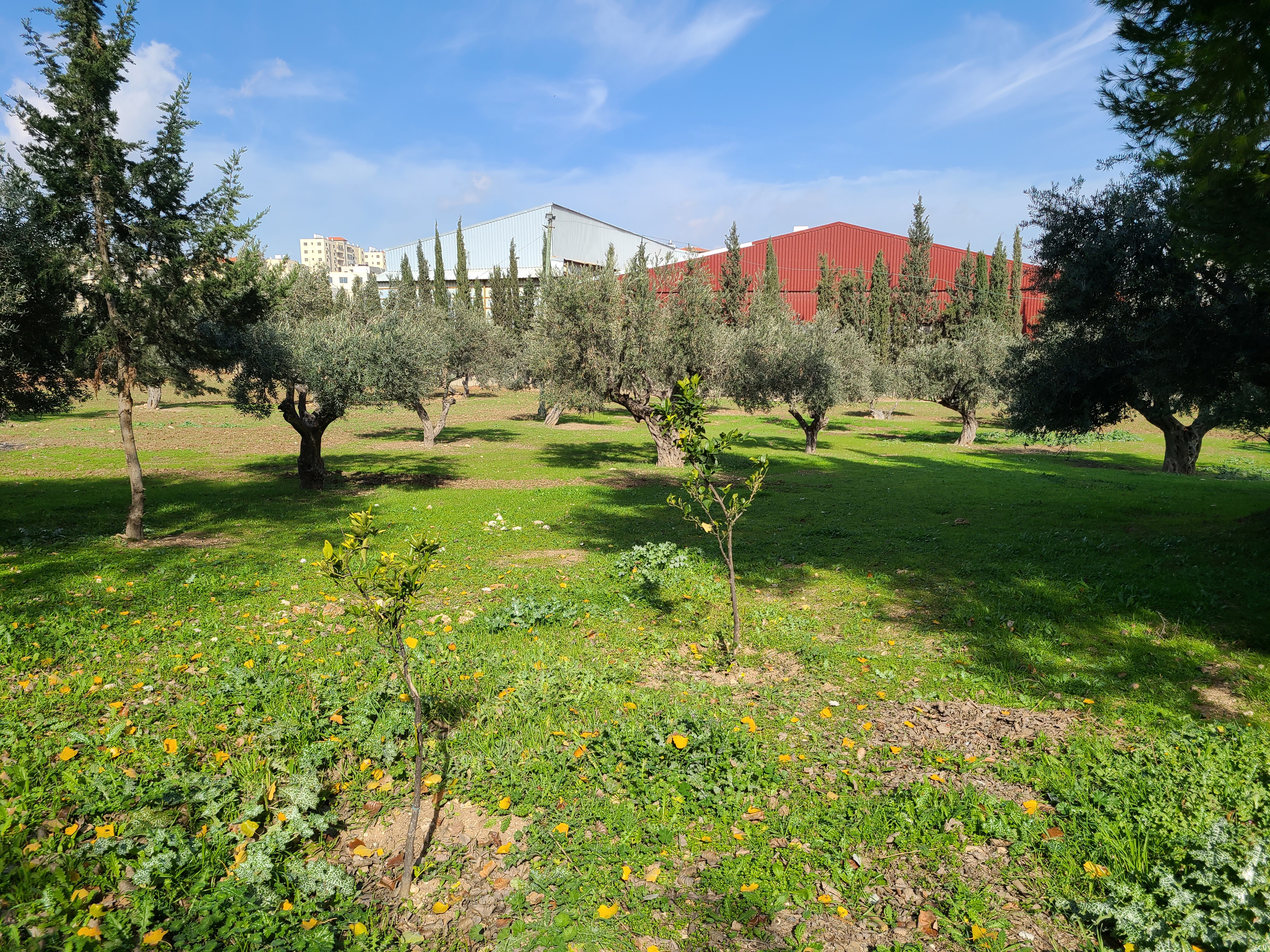
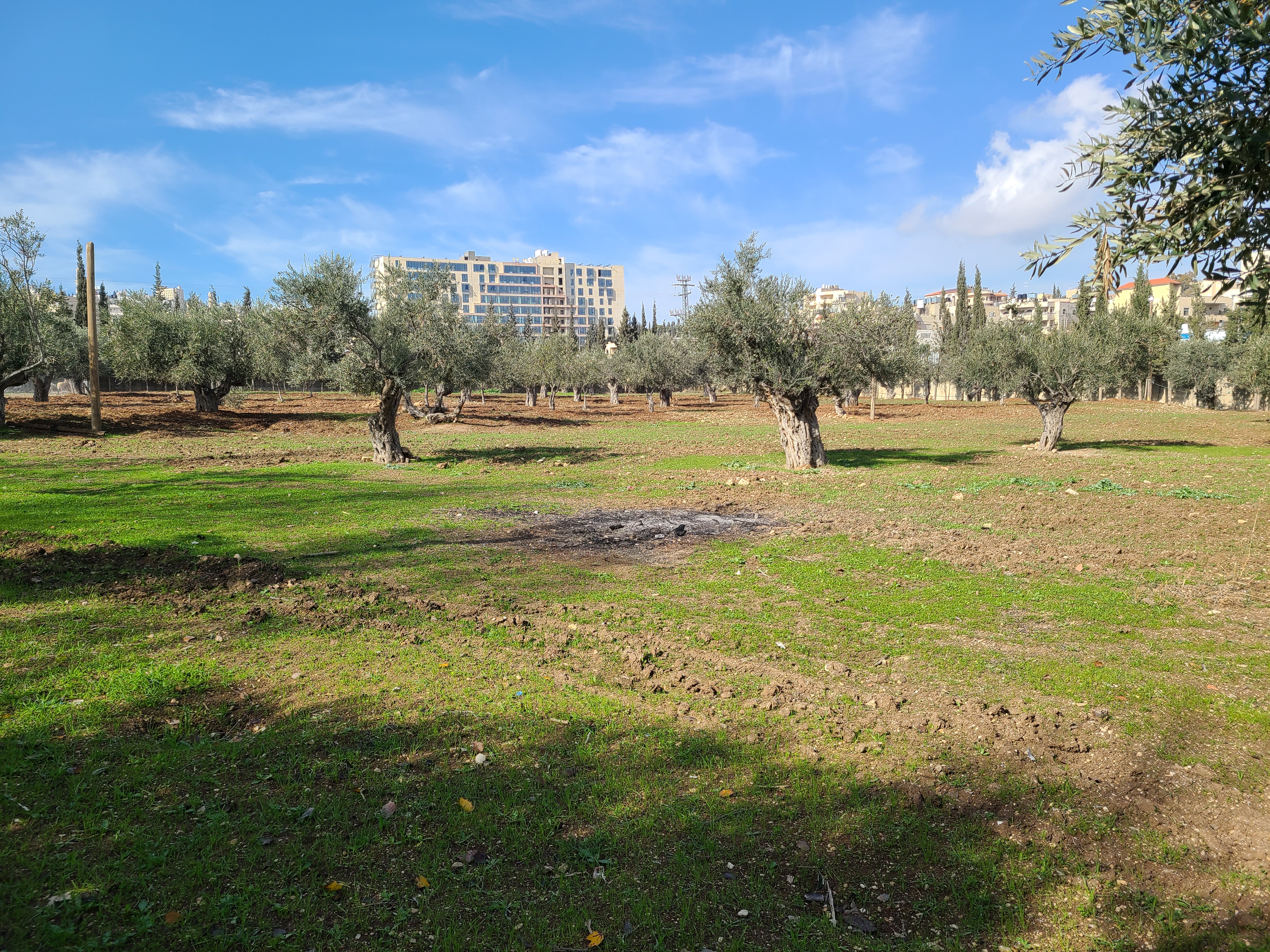
I decided to sit down again to meditate and pray. I sat underneath one of the olive trees and looked to the west towards Bethlehem and the Cave of the Nativity. The shepherds would have started walking towards Bethlehem through this very area. I felt a great peace amid the quiet here:
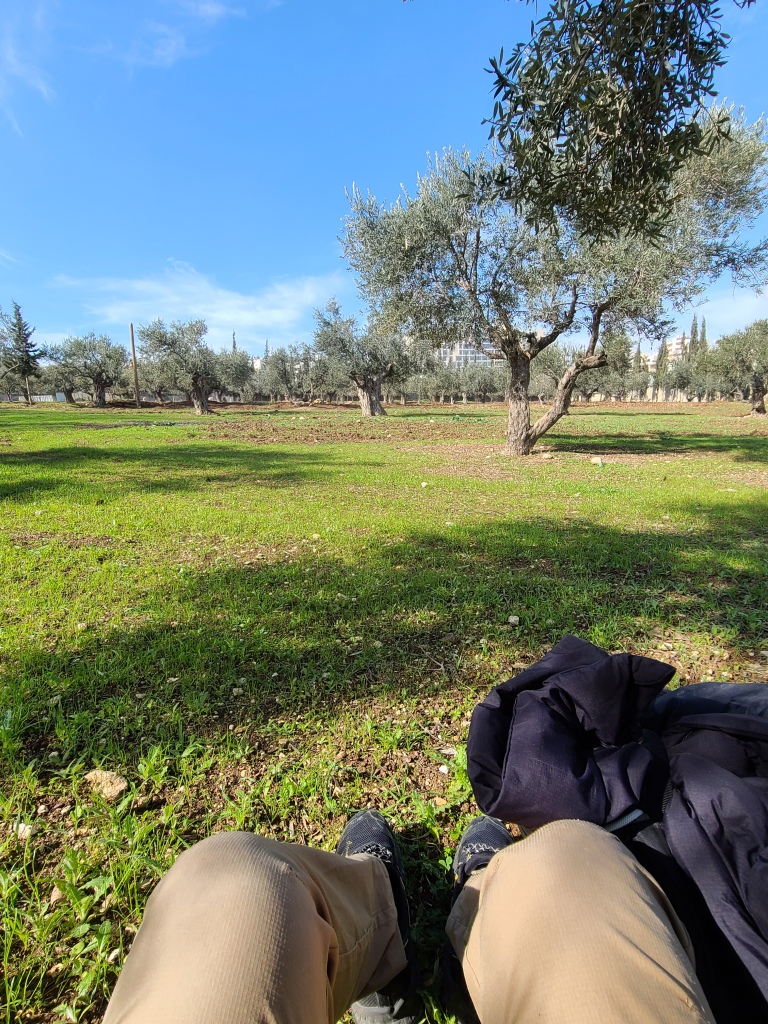
I kept walking westwards through the field and eventually saw a sight that filled me with joy:
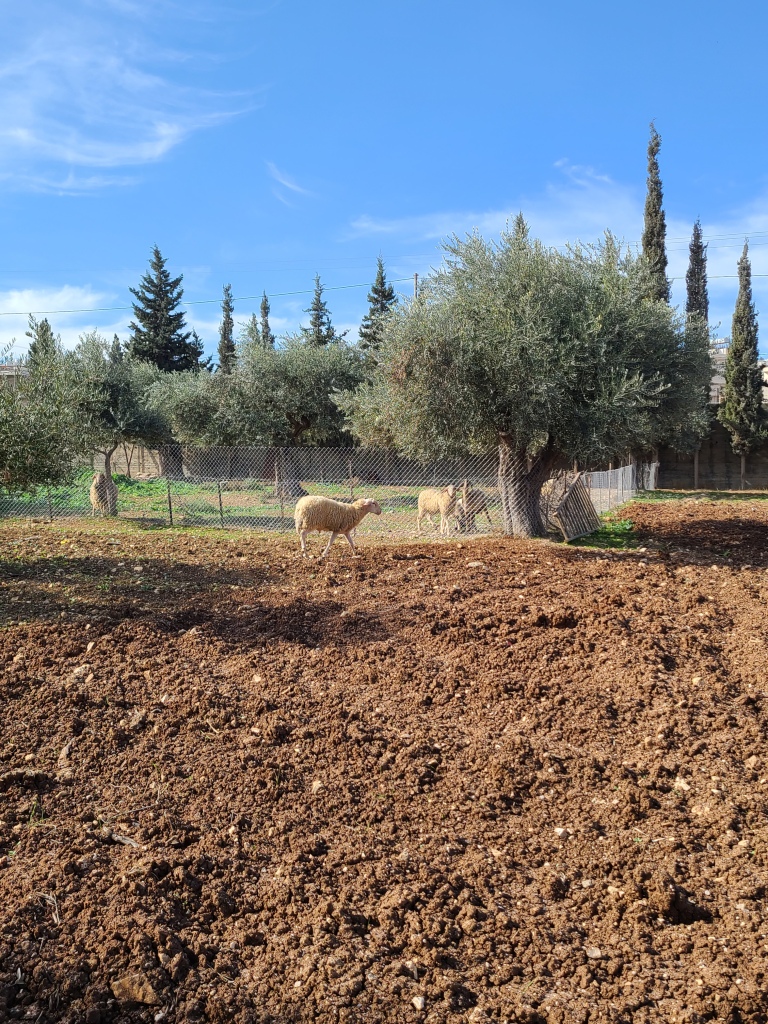
It was a pen of sheep and goats at the Shepherds’ Field! It was sooo cool to see them here and it further brought to life the story of the holy night of Our Lord’s birth!
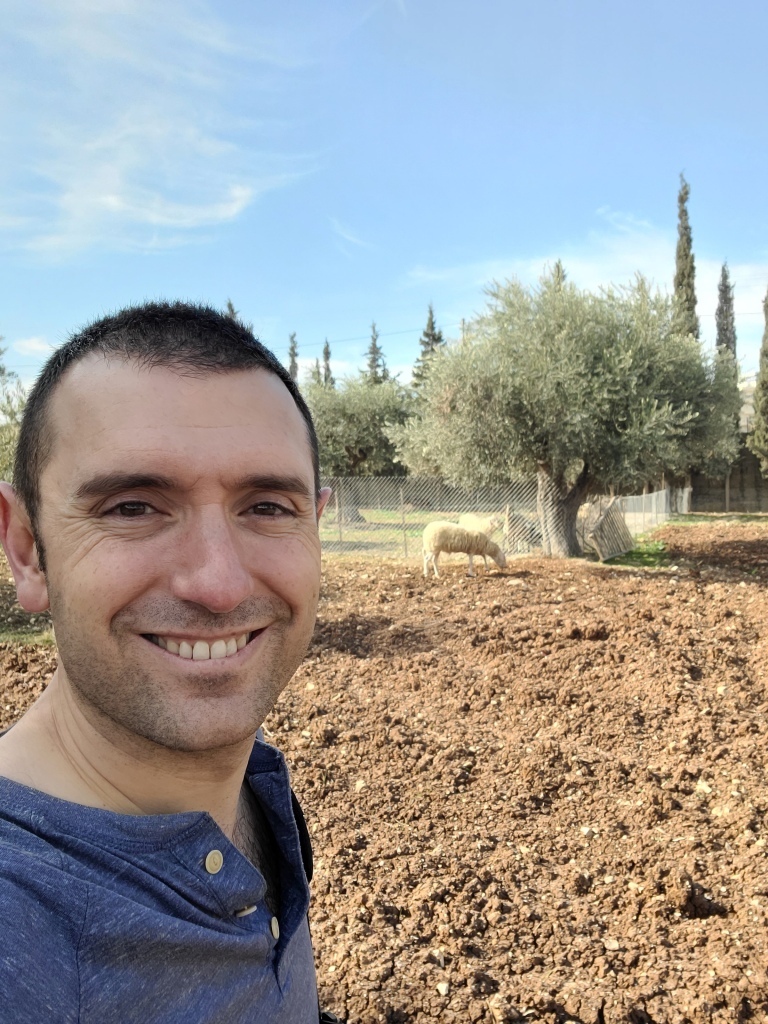
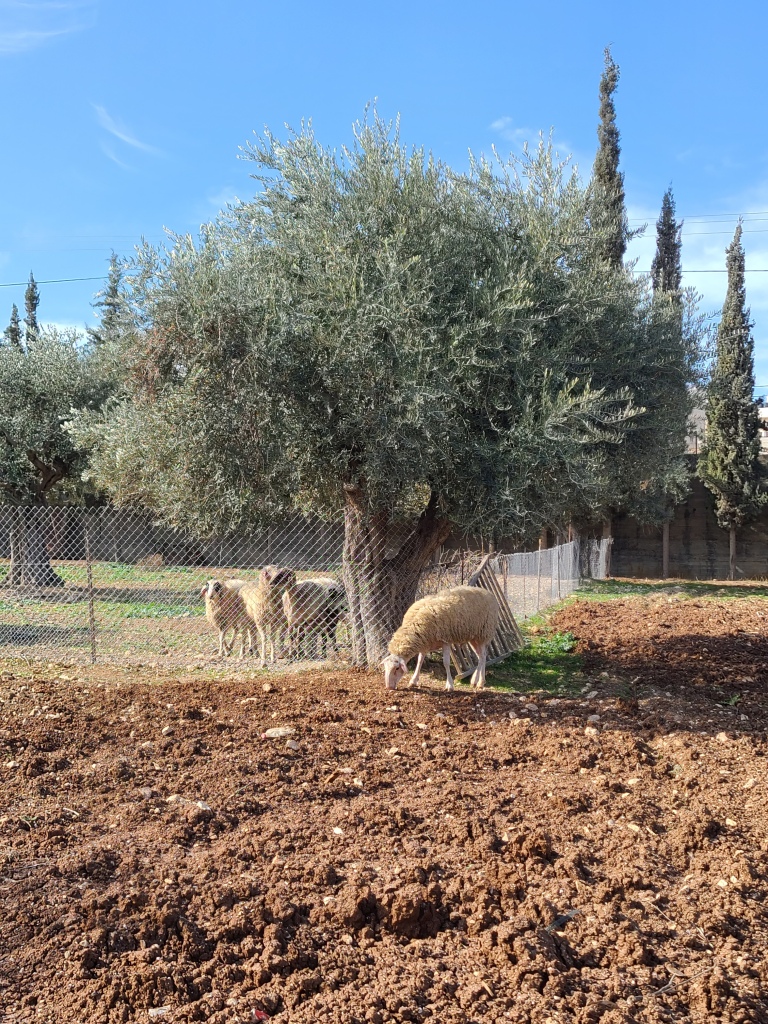
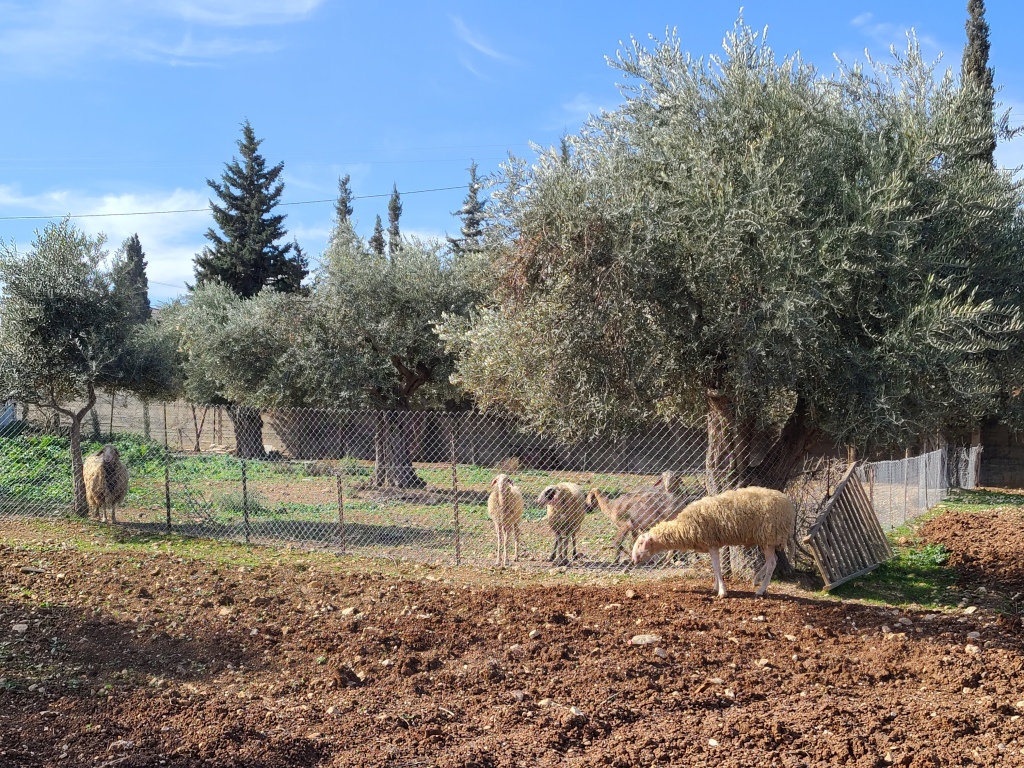
After seeing the sheep and getting some pictures, I turned back towards the Cave of the Shepherds and got one more photo of the field and the sky above this holy place. It was such a blessing to be able to visit here.
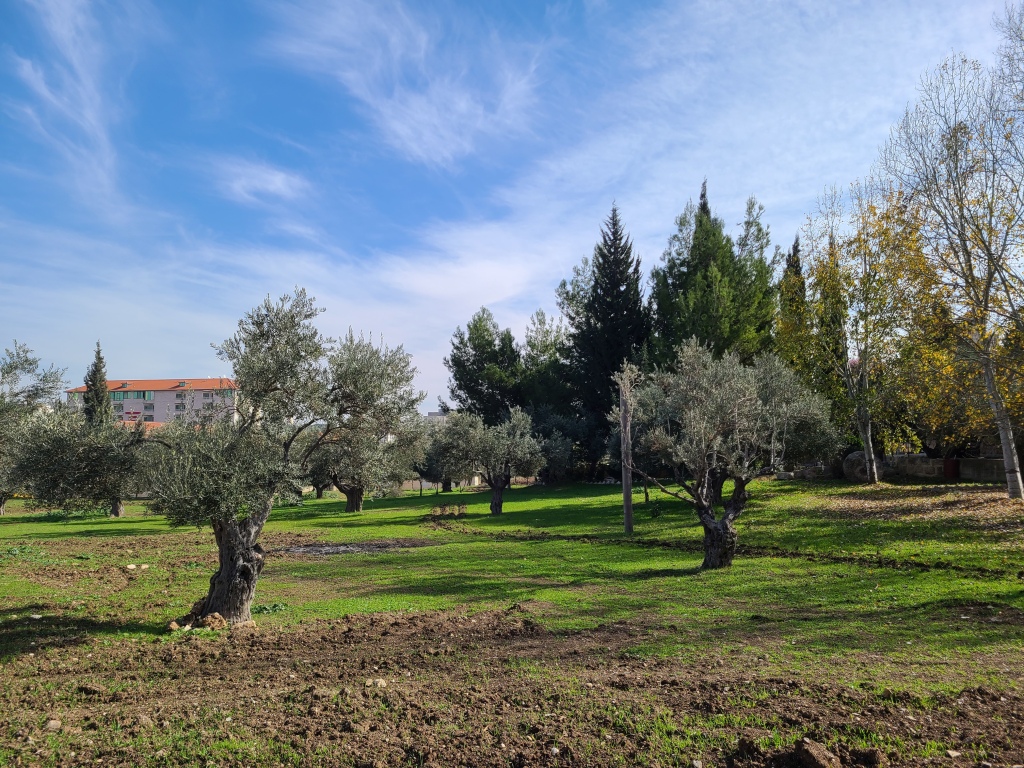
I also took a picture of a modern altar built over the ancient mosaic flooring of the church from the A.D. 500s which once stood above the cave:
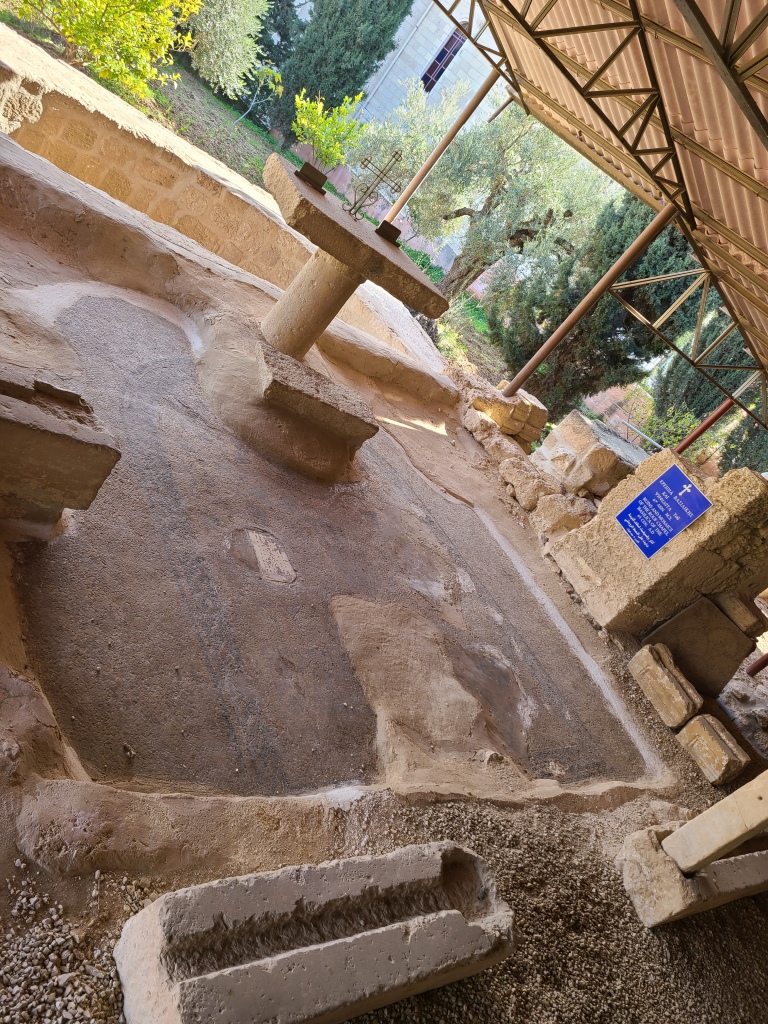
After saying more prayers and thanking the Lord for the gift of visiting the Shepherds’ Field, I had to tear myself away from this holy place and keep pressing along with my itinerary for the day. At that point, I had left my rental car outside Checkpoint 300 for the last 6 hours and 40 minutes…the Israeli soldier at 4:45 in the morning had said I was ok to park there, but I hope he didn’t just mean I could park there for *only a short time*! Hopefully I did not have a ticket–or worse–a rental car that had been towed away! No matter what though, my opportunity to visit Bethlehem had been worth it. I said a prayer that it would all be ok.
I stepped outside the gate of the Shepherds’ Field complex. I decided running 3 miles back to Checkpoint 300 was not a good option and walking wasn’t a good option either as I wanted to conserve time for seeing more sites that day. I needed to get a ride. Amazingly, about 30 seconds later, I saw a taxi cab driving past the gate. I hailed the cab, he stopped and I hopped in! Yes!
The cab driver spoke broken English and we had some interesting conversation. He asked me where I was from and I told him I was from America. He smiled and asked: ”Biden or Trump?” haha. I tried to avoid talking politics with him and asked about him and his family. He told me he had lived in Bethlehem his whole life. He had a son who was able to get permission to leave the West Bank and was a doctor living in Israel. A short time later he dropped me off at Checkpoint 300. I processed through the checkpoint by showing the guards my passport, and I was back once again on the Israeli side of the barrier wall from the Palestinian-controlled West Bank. I now nervously walked towards the parking lot where I had left my rental car…did I have a ticket? Was my car even still there???
God is good and it was right where I had left it, with NO ticket! Thanks be to God! :)
I got in my car and started driving towards my next destination for the day. It was a little-known holy site about halfway between Bethlehem and Jerusalem along the ancient road between the two cities (they are about 5 miles apart): the Rock of the “Kathisma” and the remains of the ancient church built around it (GPS Coordinates: 31°44’21.17″N, 35°12’45.85″E).
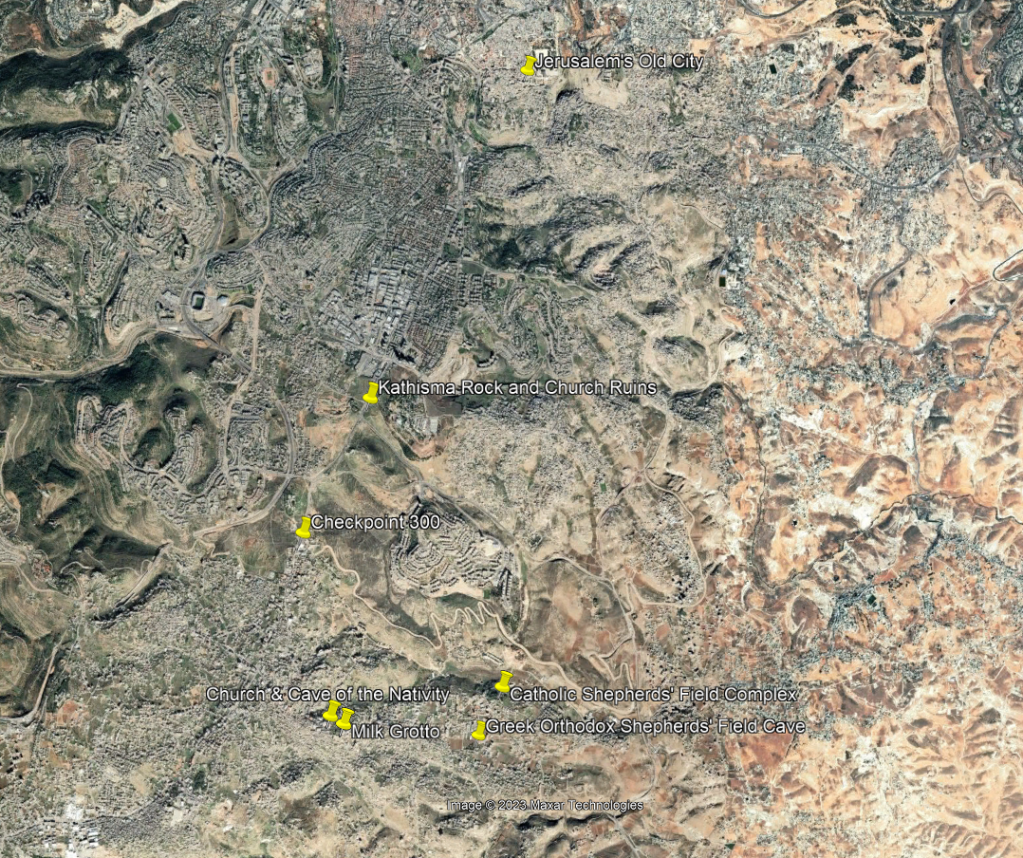
“Kathisma” is Greek for “seat”–a very ancient tradition holds this rock was the “seat” of Our Lady where she rested on her way to Bethlehem with St. Joseph. According to a very early apocryphal infancy gospel from the A.D. 100s called the Protoevangelium of James, St. Joseph took Our Lady down from their donkey to rest on their way to Bethlehem: ”And they came half the way, and Mary said to him: ‘Joseph, take me down from the ass, for the child within me presses me, to come forth.’ And he took her down there.” Although the Protoevangelium of James is apocryphal, because it and the tradition of the location of Mary’s “Rest Stop” are so old, there is a distinct possibility this was an actual location where Mary and Joseph stopped. According to Fr. Bargil Pixner’s book Paths of the Messiah and Sites of the Early Church from Galilee to Jerusalem, in around the year A.D. 440, a wealthy woman named Ikelia, who had been the wife of a high imperial official, funded the construction of a beautiful octagonal church dedicated to Our Lady to cover the stone of the Kathisma (2010, 41). Fr. Pixner also states the church was probably destroyed by the Persians when they invaded in A.D. 614, never to be rebuilt and was eventually covered up with earth and vegetation and forgotten to history (2010, 44). That is, until the Fall of 1992 when the Israelis were widening the adjacent highway between Jerusalem and Bethlehem and came across the remains of a large octagonal church with mosaics centered around a large rock (Pixner 2010, 38). The ancient Church of Mary’s Seat (the Kathisma) had been at last re-discovered!
I drove north on the highway between Bethlehem and Jerusalem, parked at a gas station, and walked to the nearby the Kathisma Church. It must have been quite an impressive church when it was still standing! The photo below shows the site of the church–with the remaining foundations of its walls outlining the shape and extent of its structure:
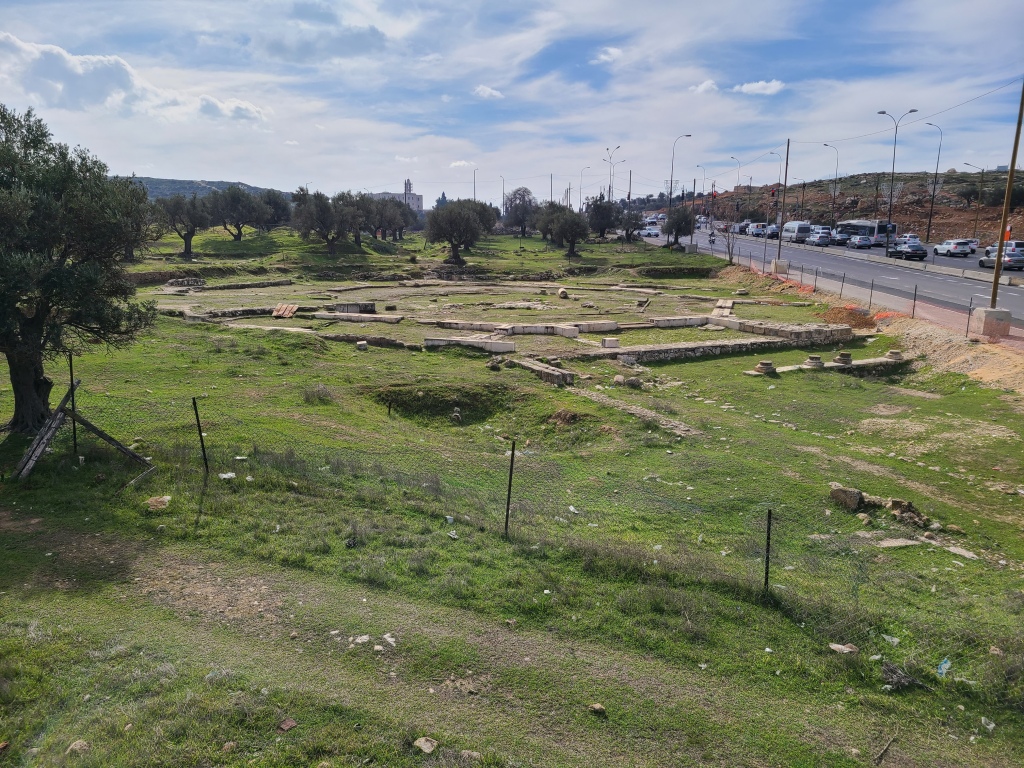
I walked up to the ruins…not much was left, but I believed I was once again on holy ground.

I walked to the center of the ruins and saw the Rock of the Kathisma–Our Lady’s humble seat which, for a short time, was the shared throne of the pre-born King of the Universe and Our Holy Queen! It was truly breathtaking…something so great buried over the centuries and, still today, all but unnoticed by the thousands of motorists that drive past it every day!
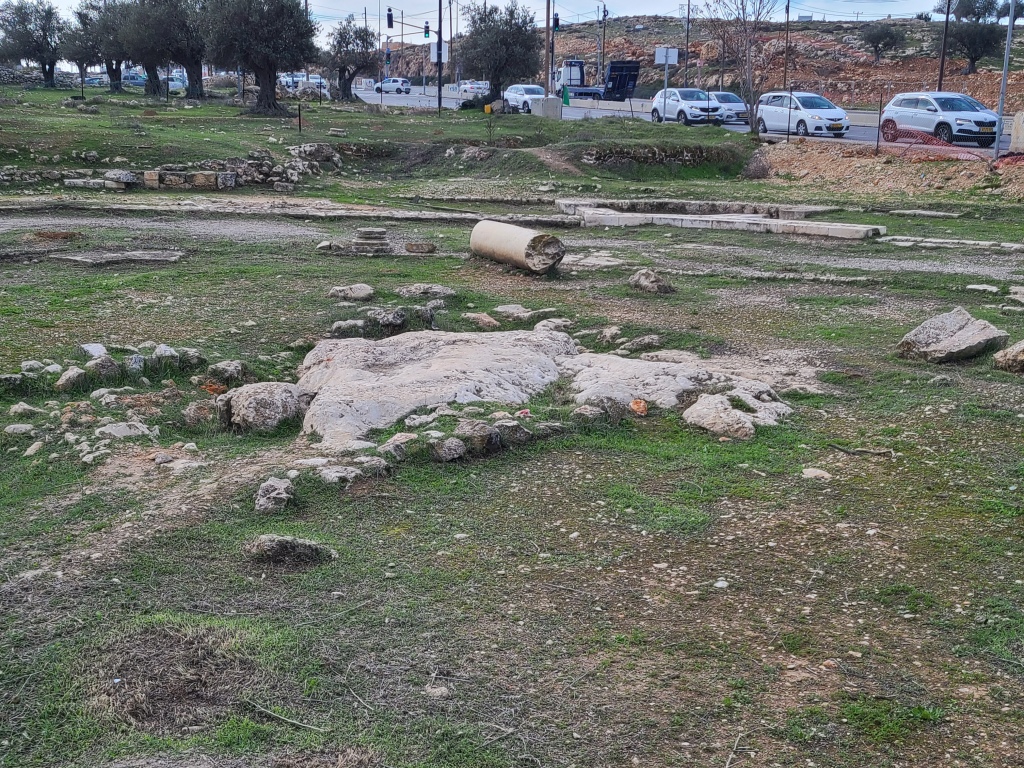
Next to the rock, you could see some of the ancient flooring foundation that was still in place:

Nearby were some woolen blankets covered in dirt. Underneath them were the remnants of the elegant, ancient mosaic floor which once surrounded the rock inside the church.
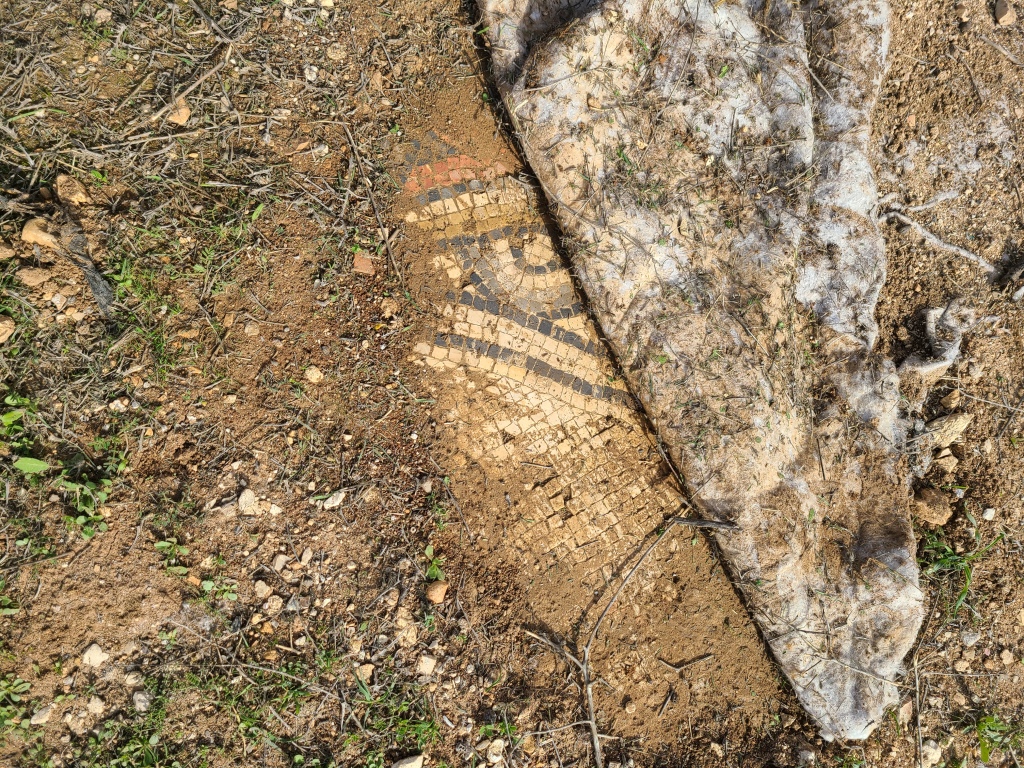
As I stood there taking in this incredible place, I decided to take a quick break as well and rested on the holy rock as Our Lady did. Her view would have been very different from mine–I watched noisy cars, vans, and buses speed by on the modern highway. Nonetheless, it was a distinct blessing to be where the Holy Family had once rested as well.
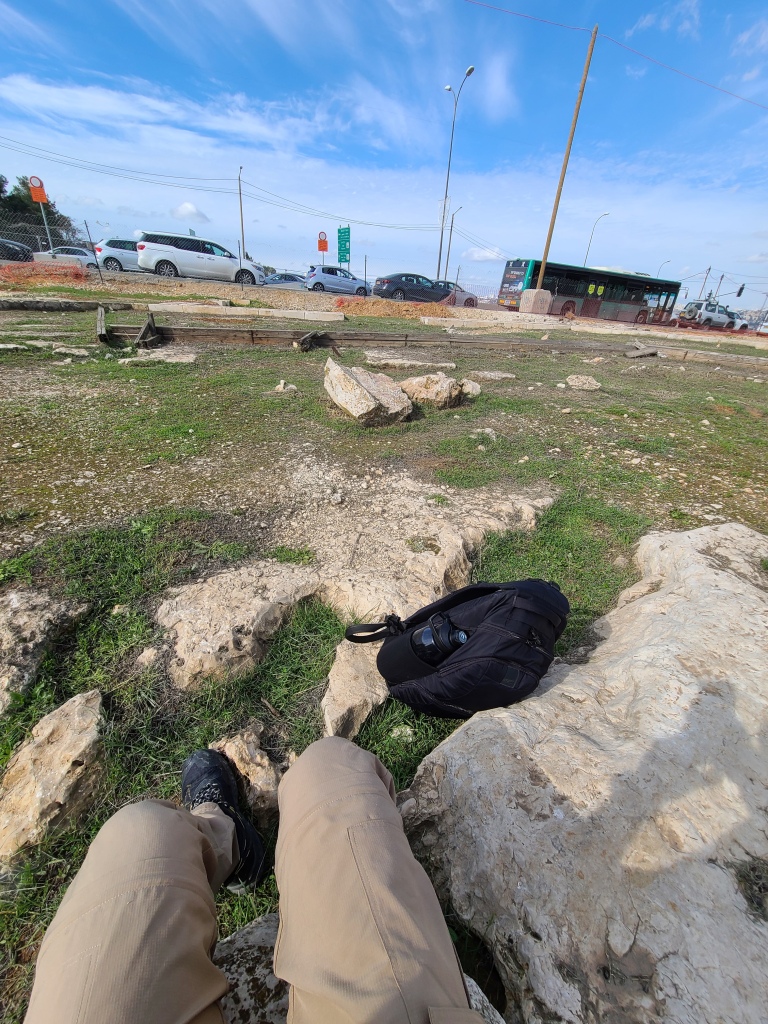
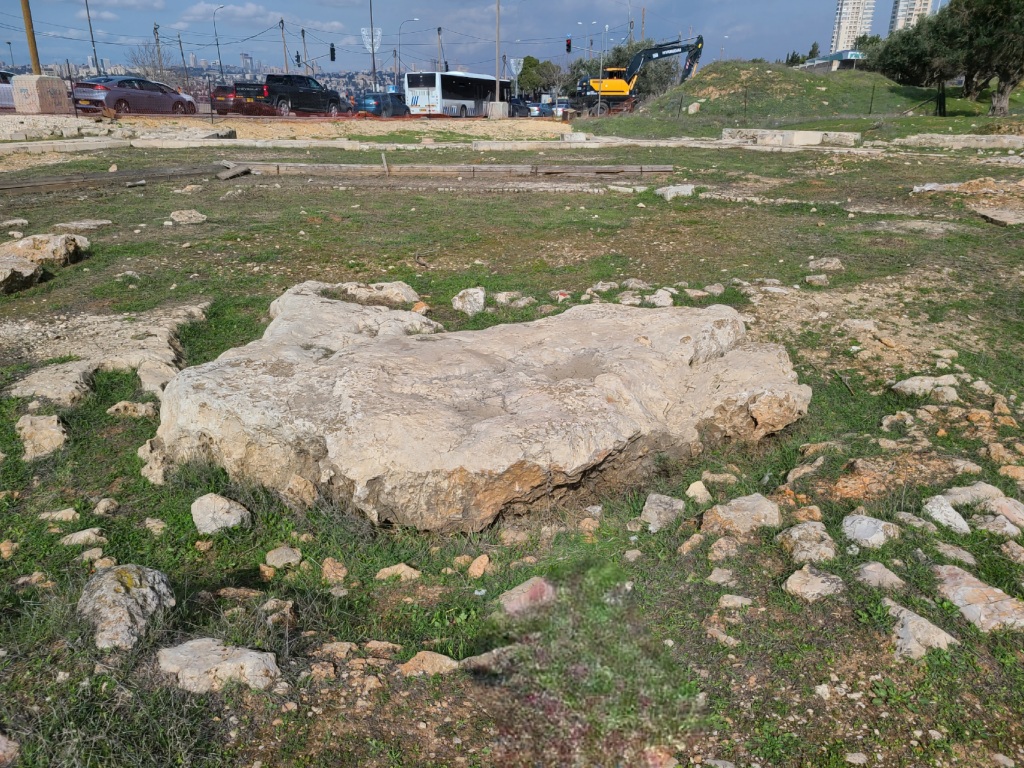
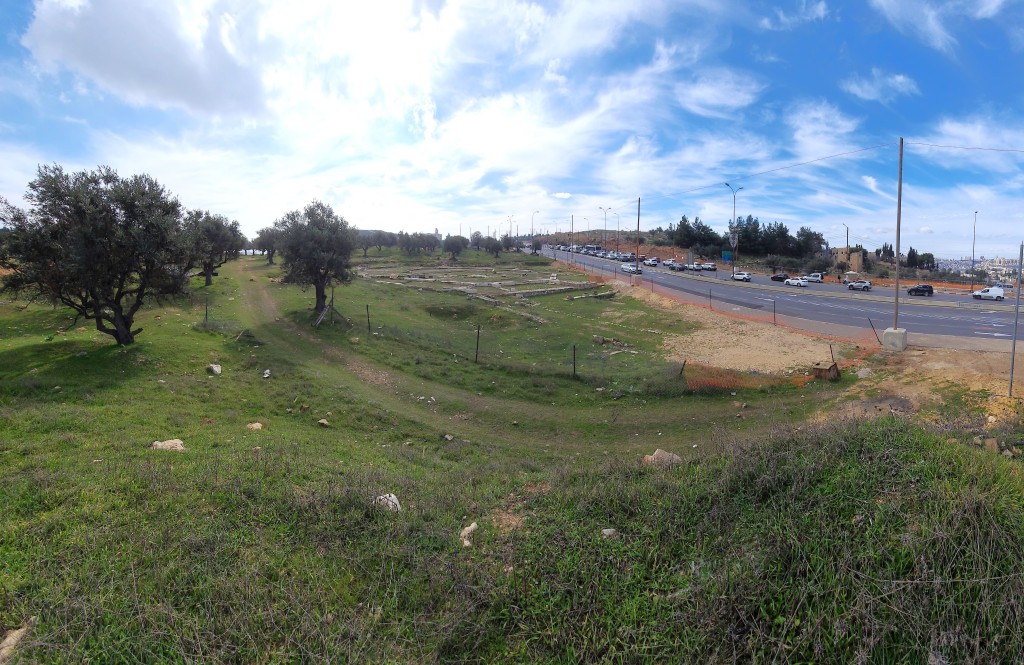
To conclude this post, I want to thank all my dear readers for making it to the end of this long post. This post actually only covers the first half of my first day in the Holy Land for this January 2023 trip. I will work to post more soon.
Thanks be to God for the opportunity to experience the story of His birth in a very special way in 2023–both from visiting where it all happened, and from being able to reflect and write about traveling there as I prepare for Christmas 2023!
God’s blessings to all of my readers and your families during the Advent and Christmas seasons and, in the words of the angelic Host above the Shepherds’ Field:
“Glory to God in the highest, and on earth peace among men with whom He is pleased!”
Luke 2:14
Merry
Christmas!!!
Also, if you enjoyed, this post, check out my one-of-a-kind book, The Second Person of the Trinity in Time and Space: What is Known Historically About Jesus and the Holy Sites of the New Testament, sold on Amazon.com! (click below)
